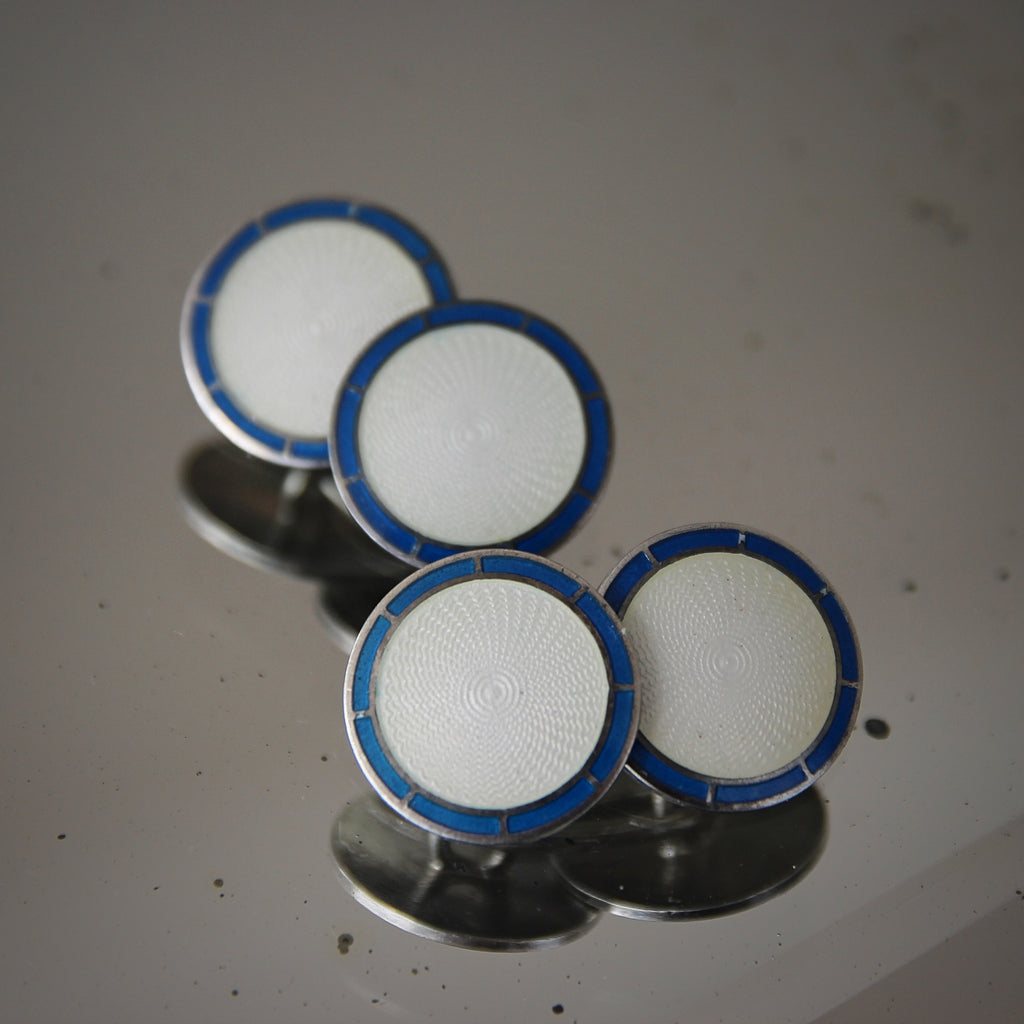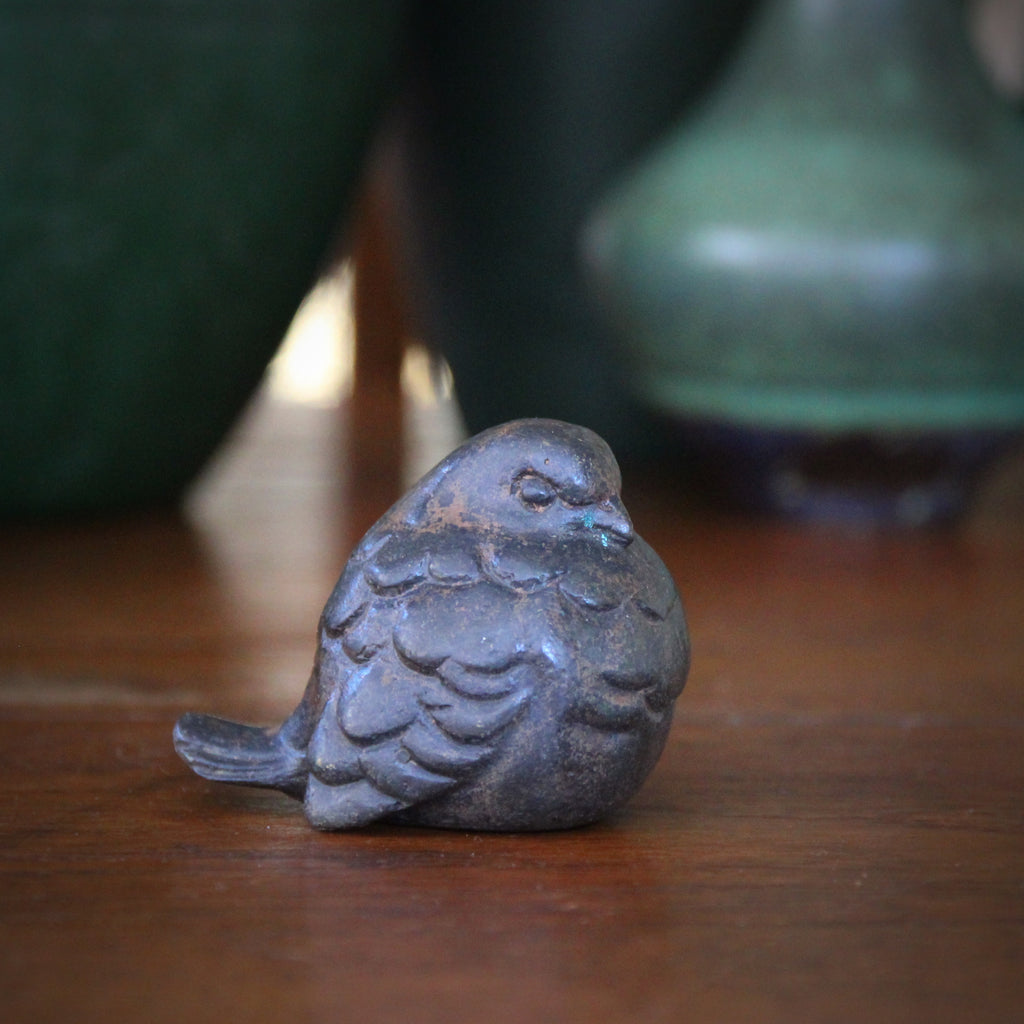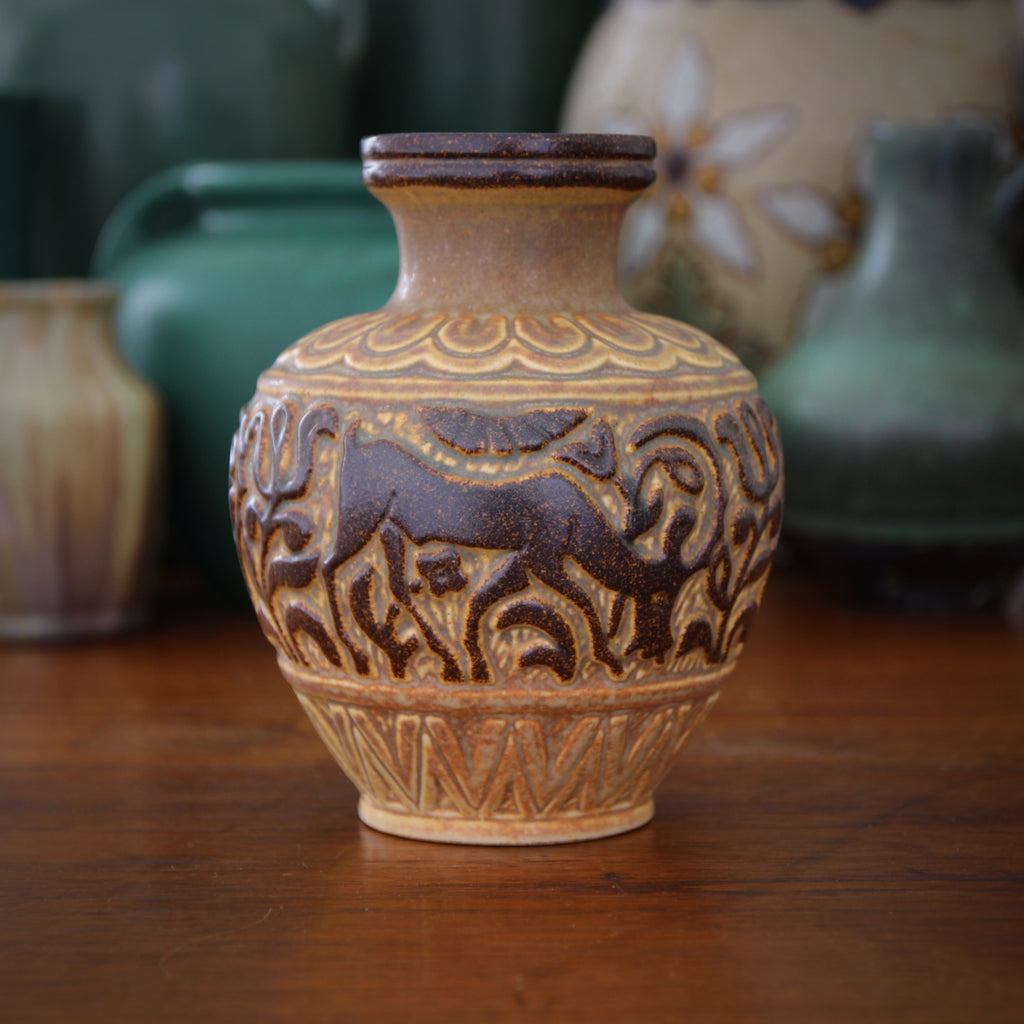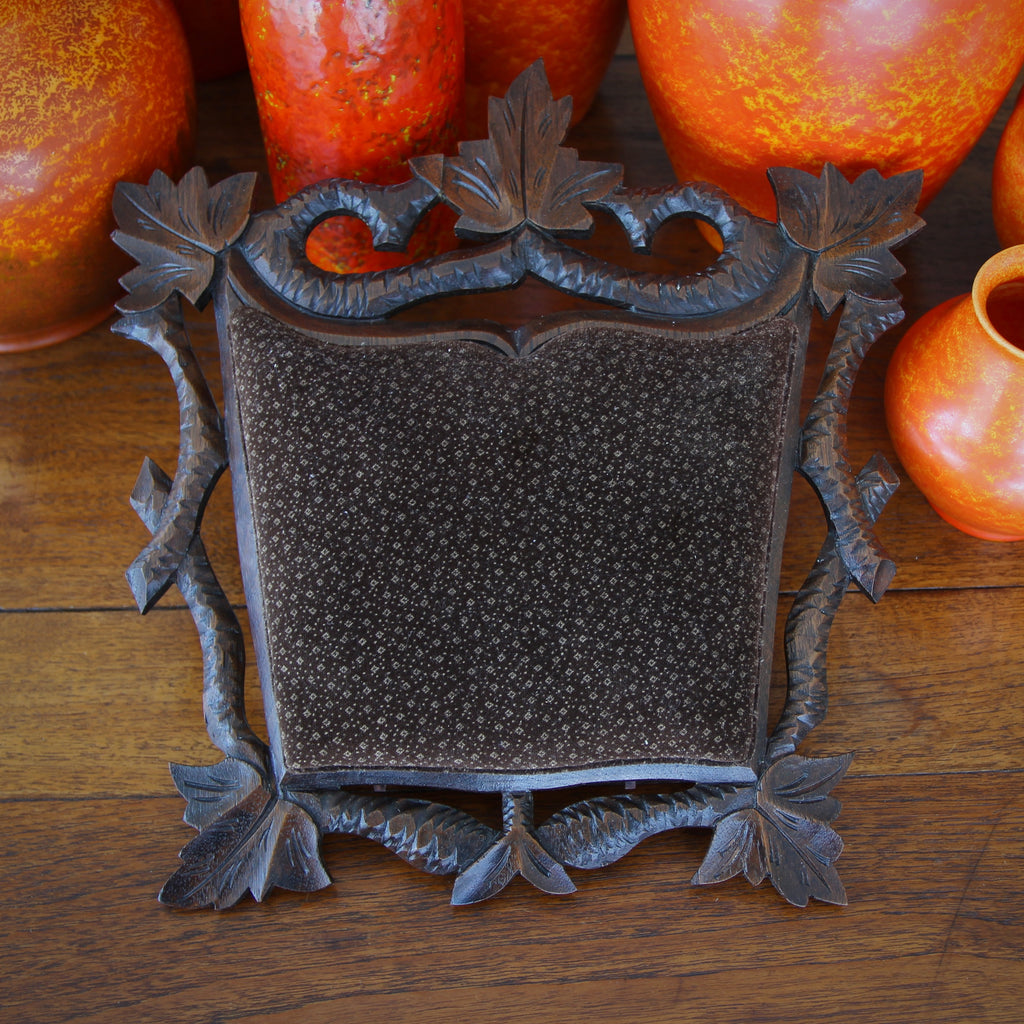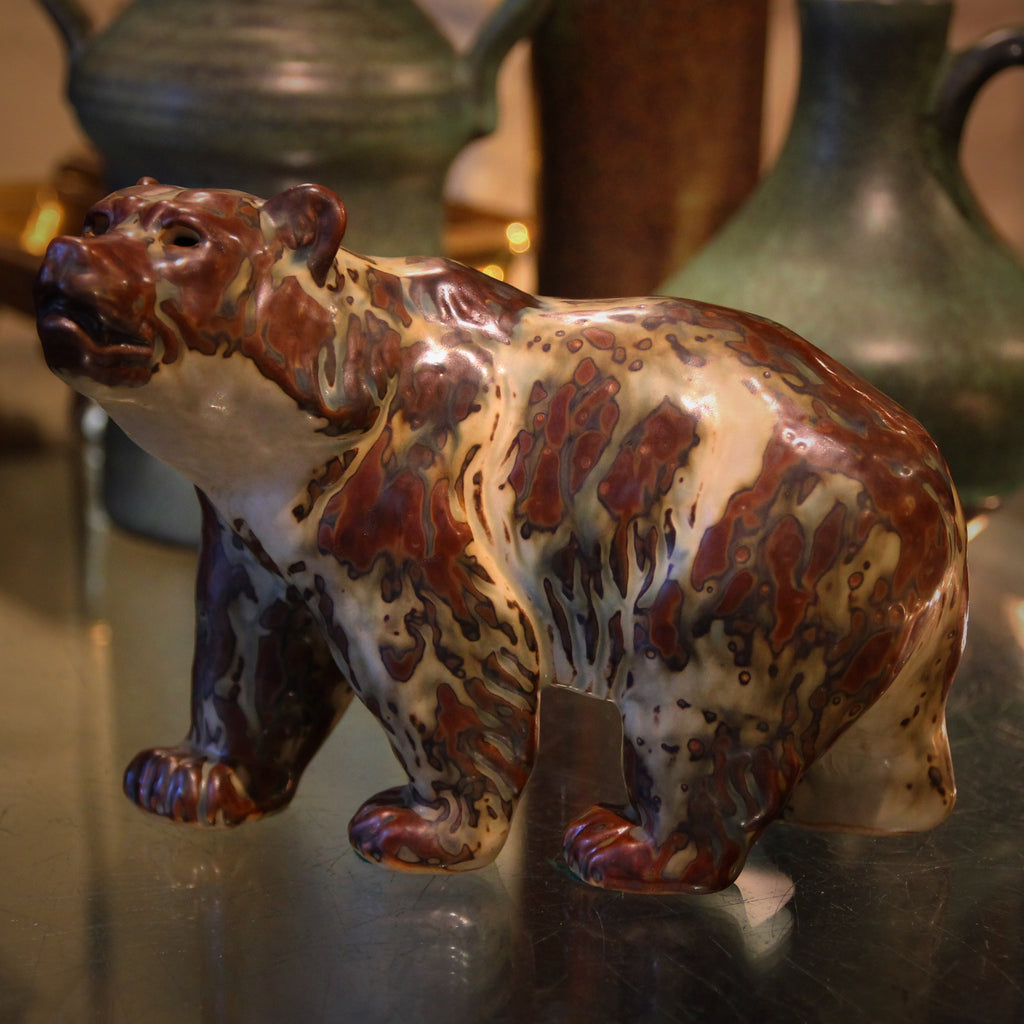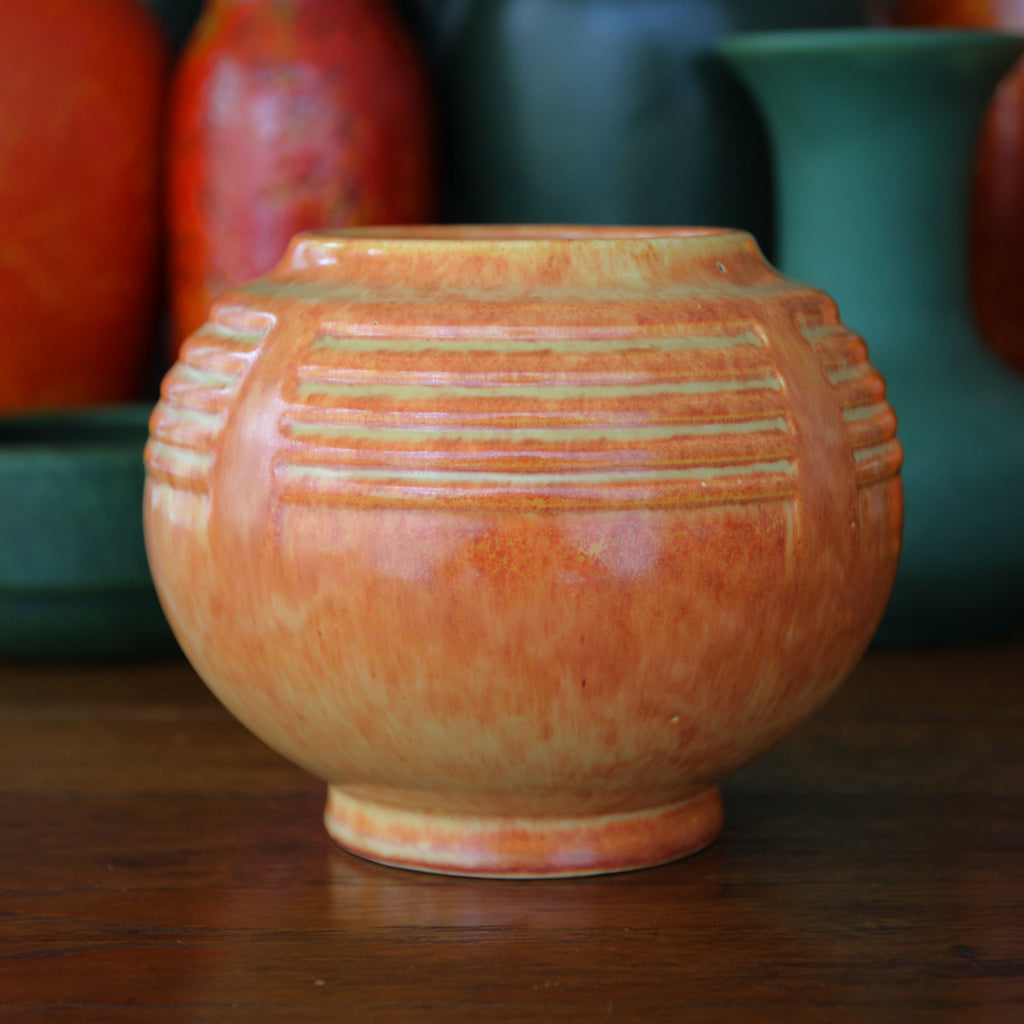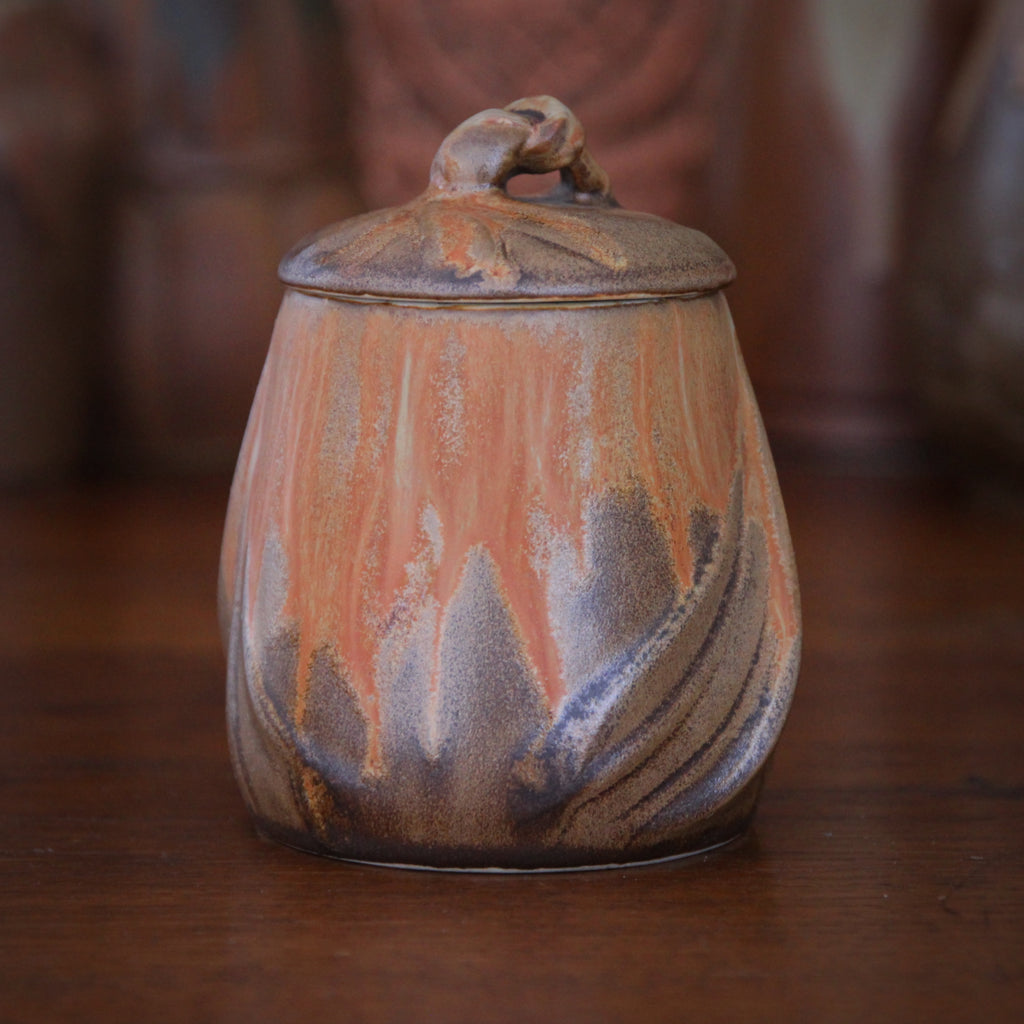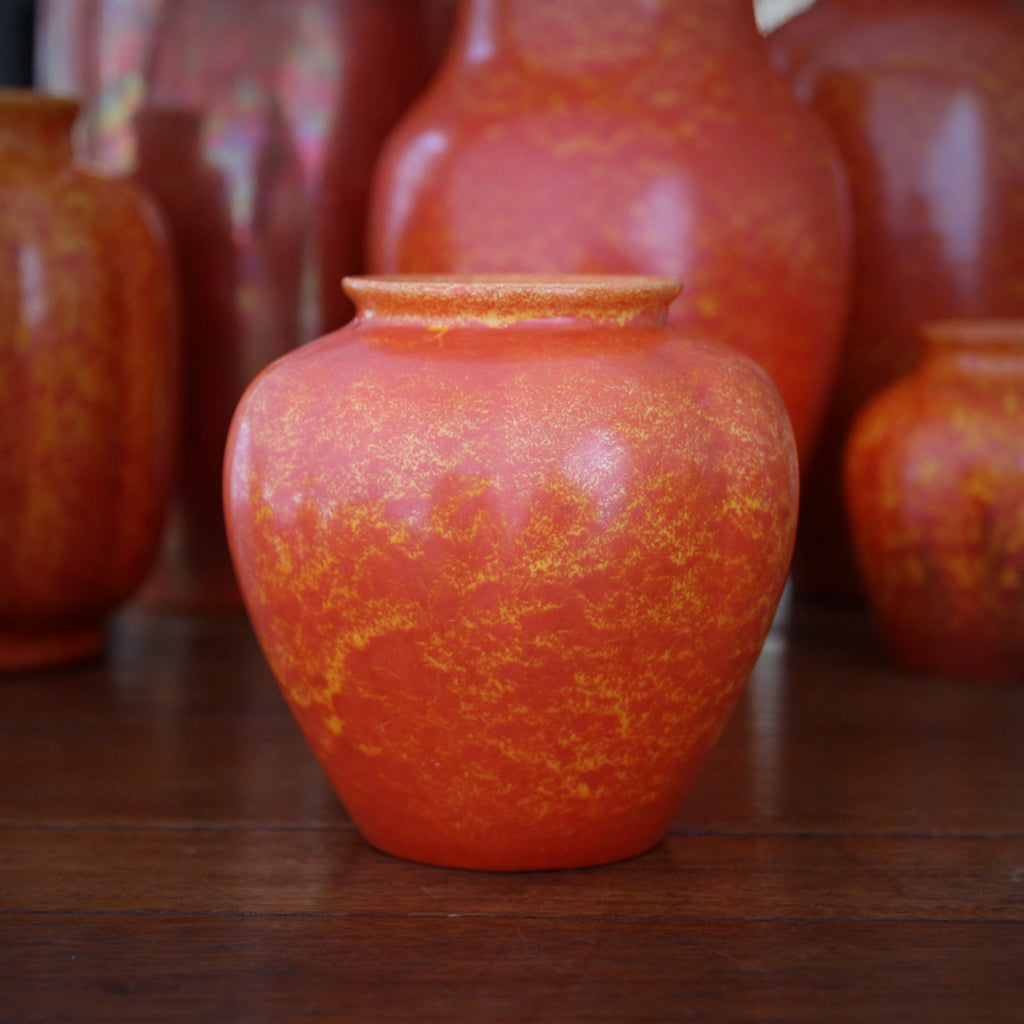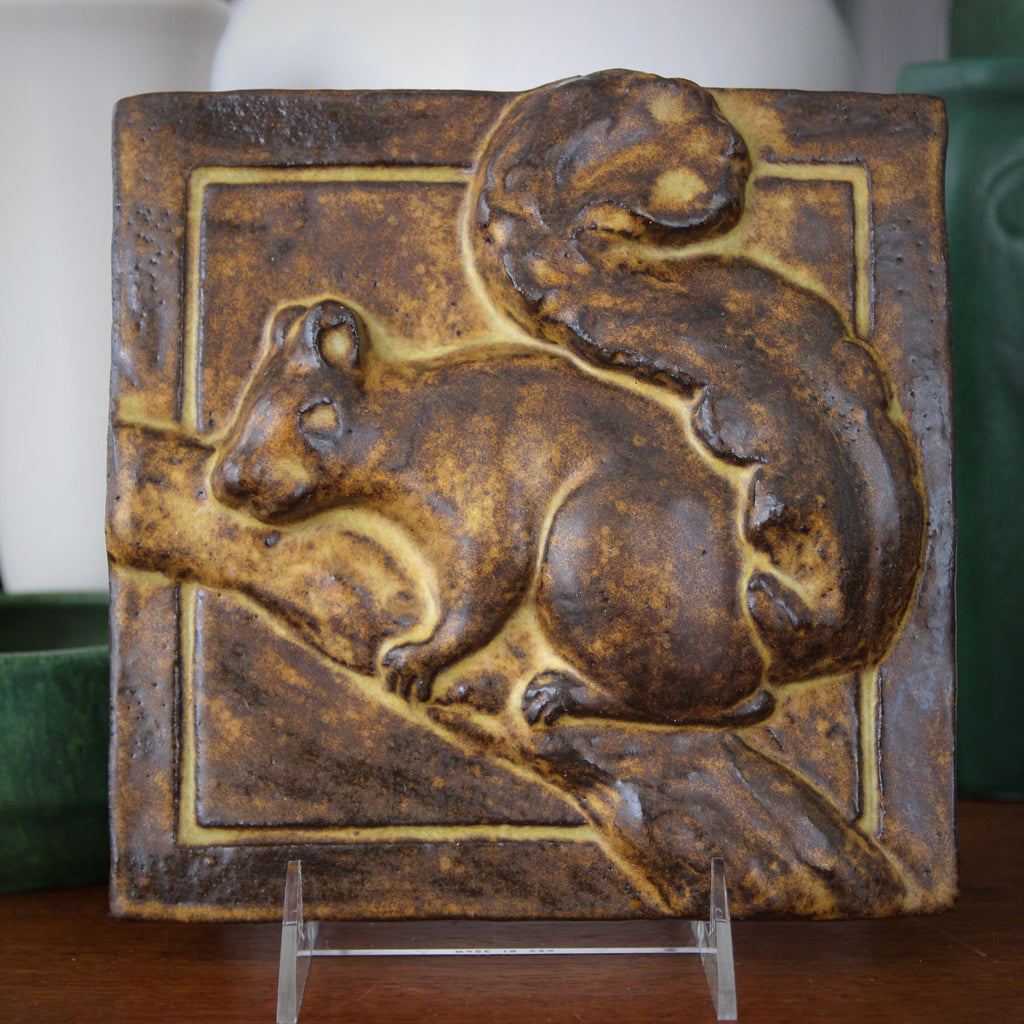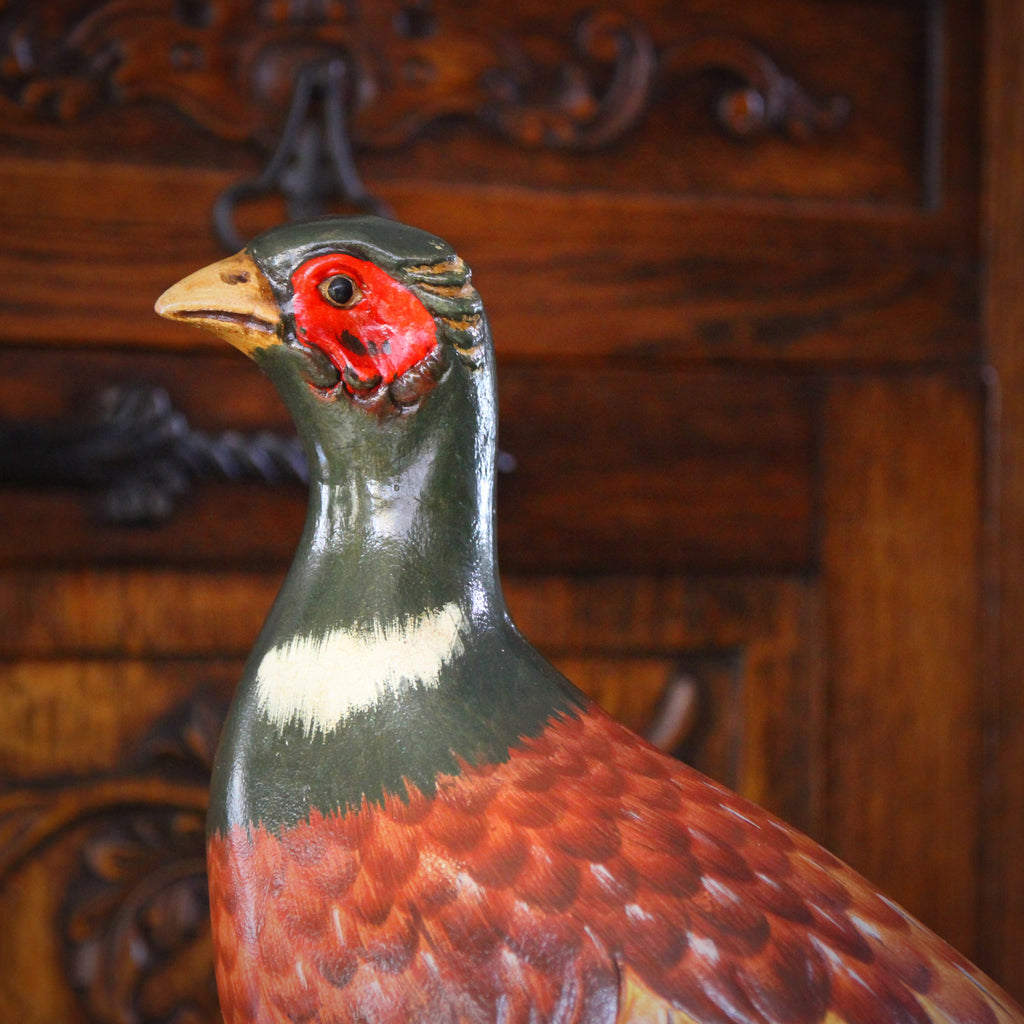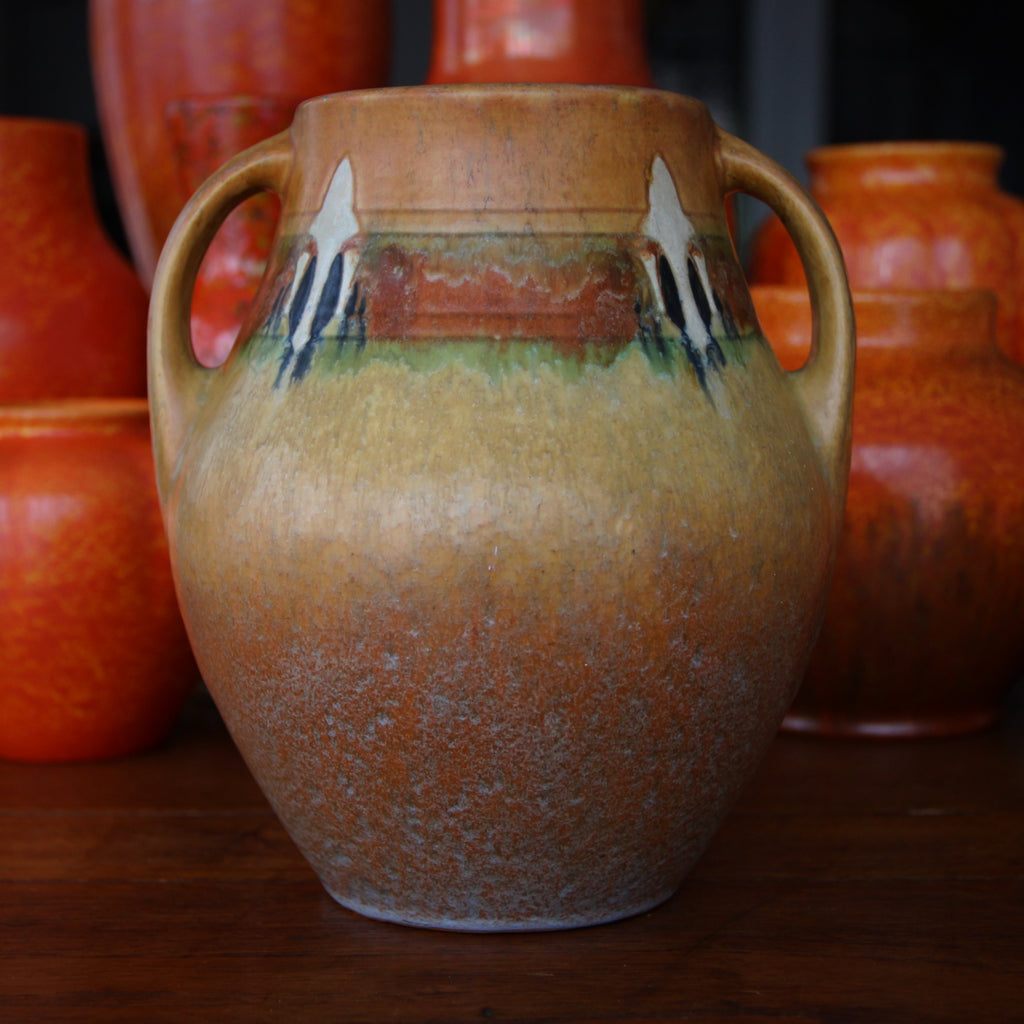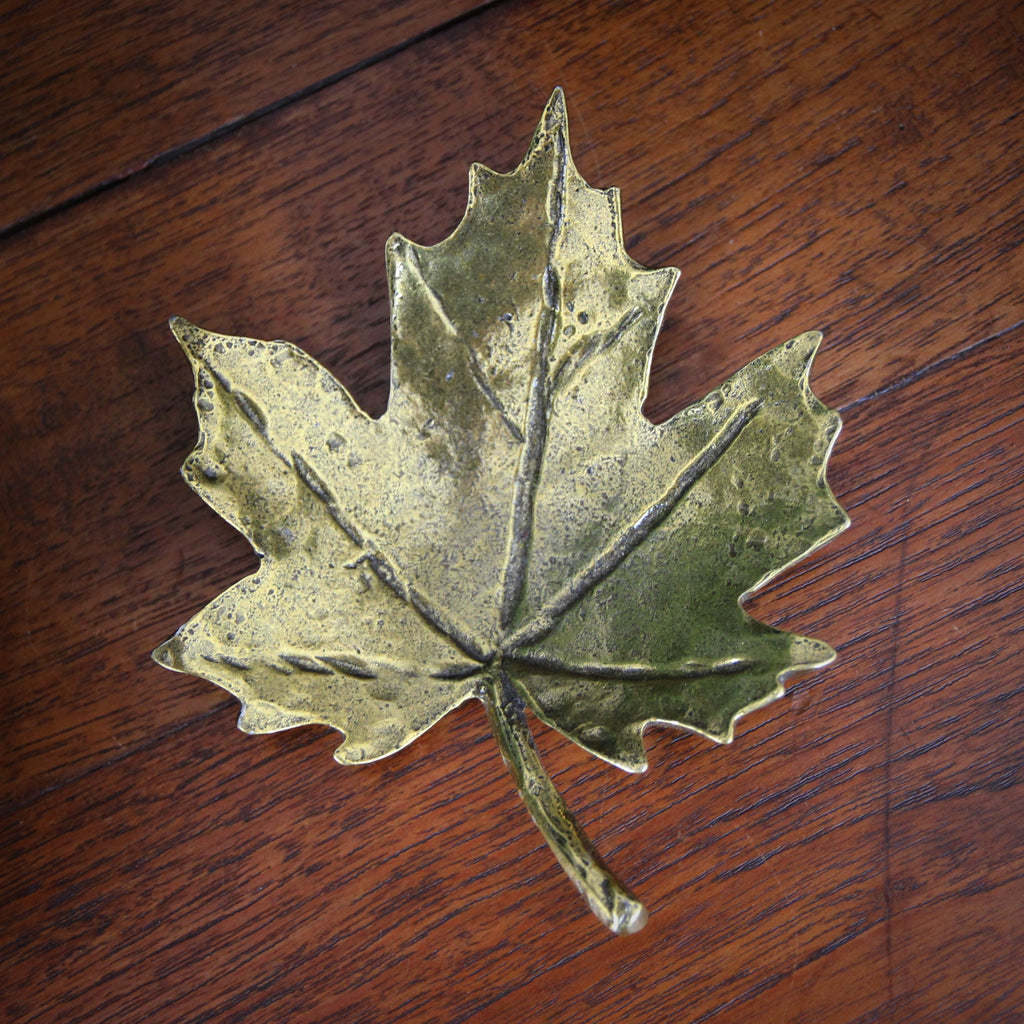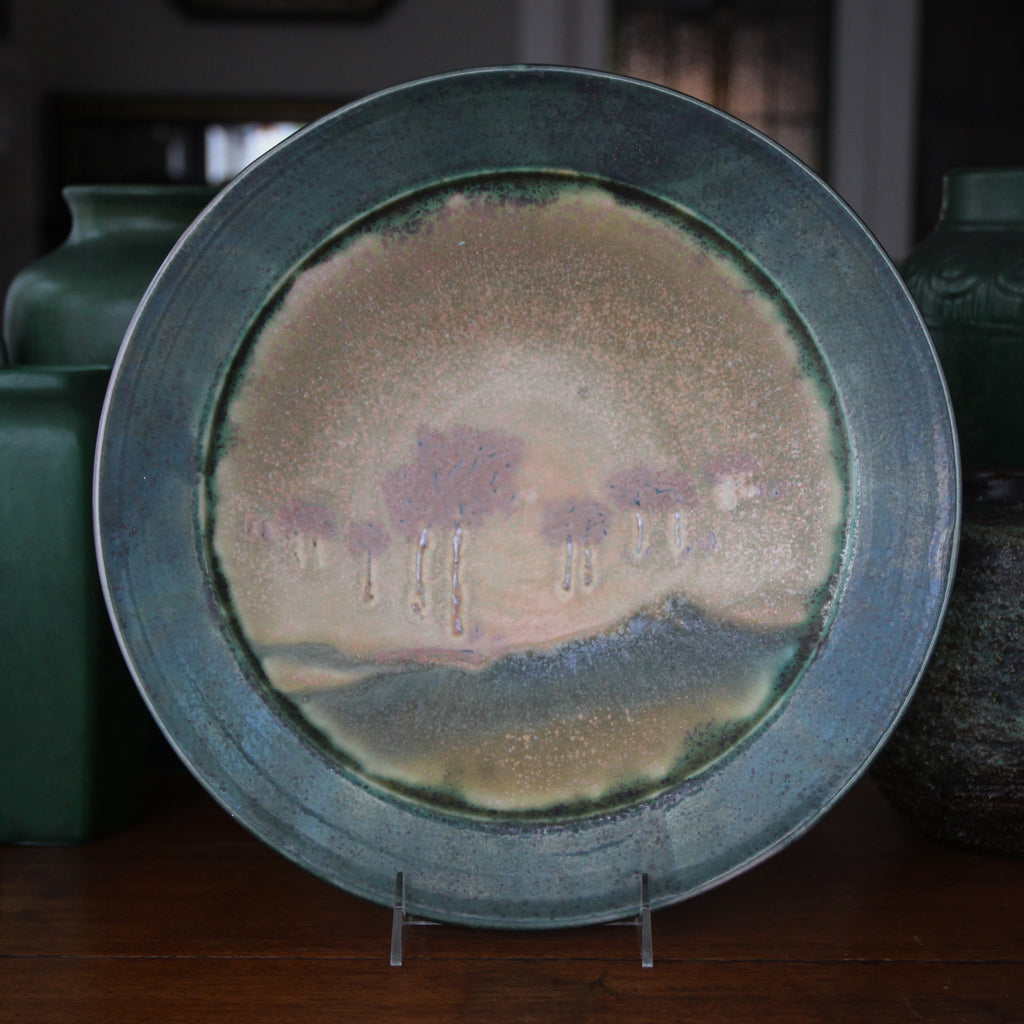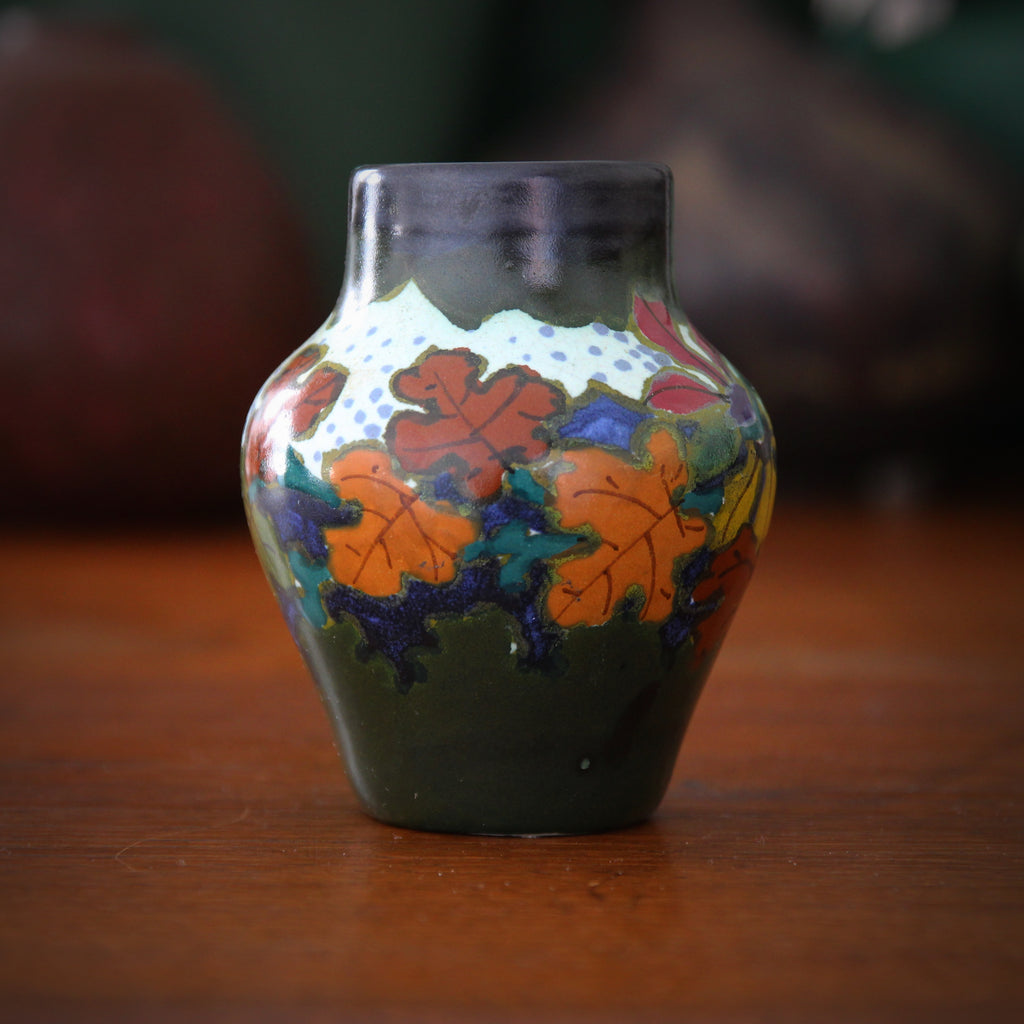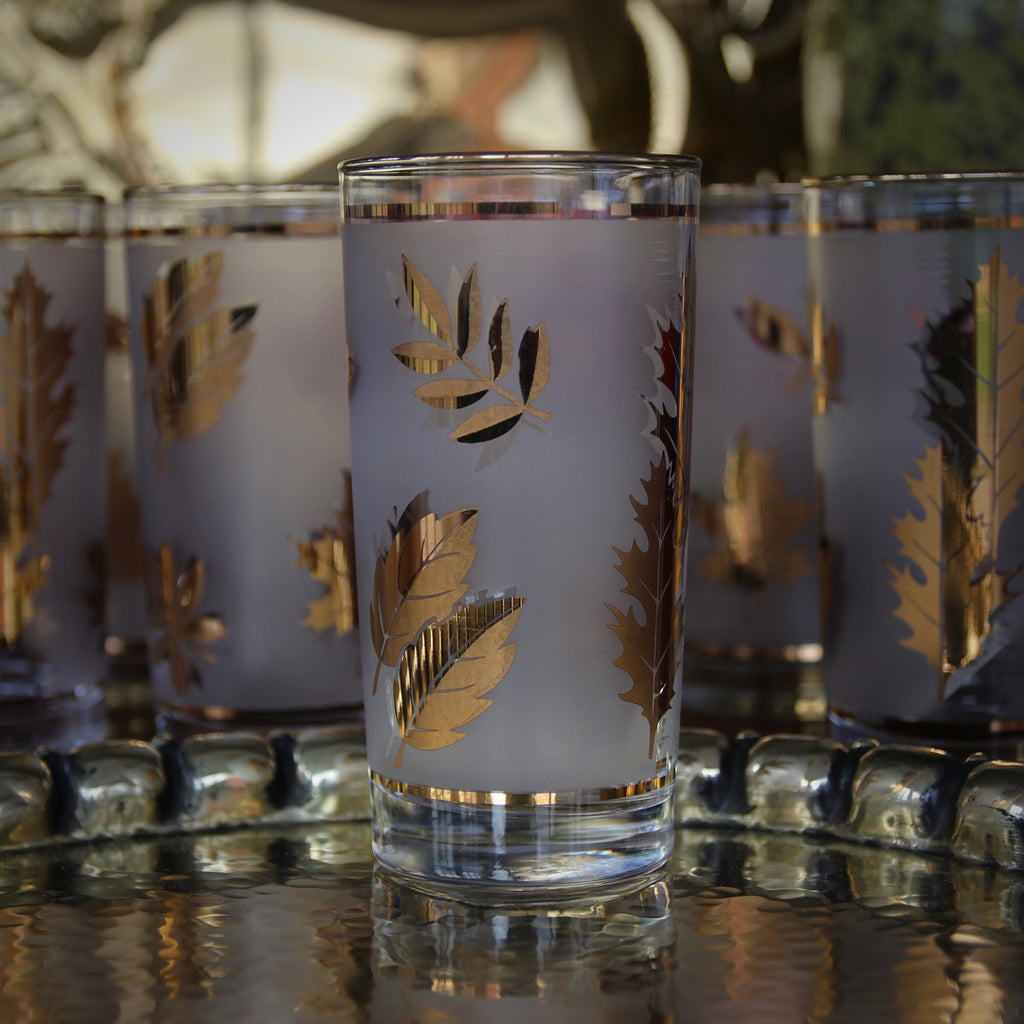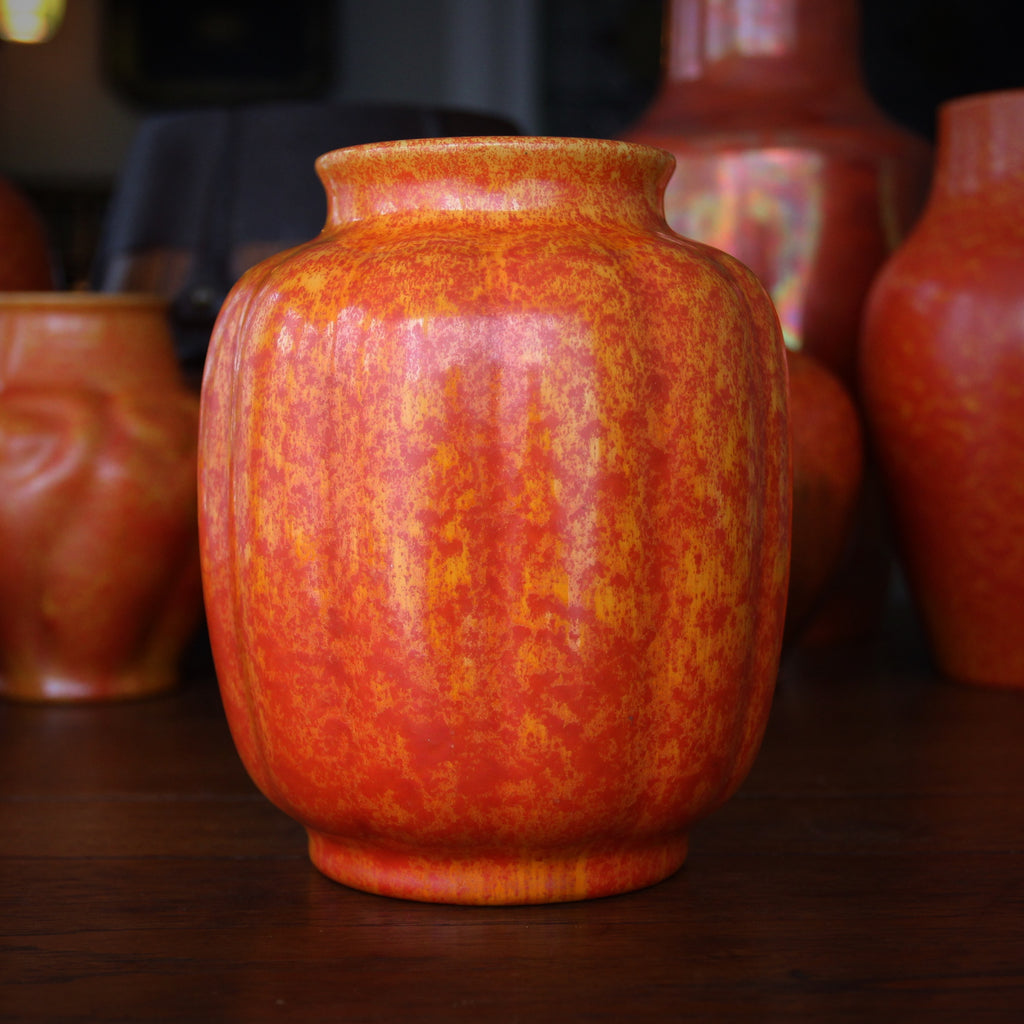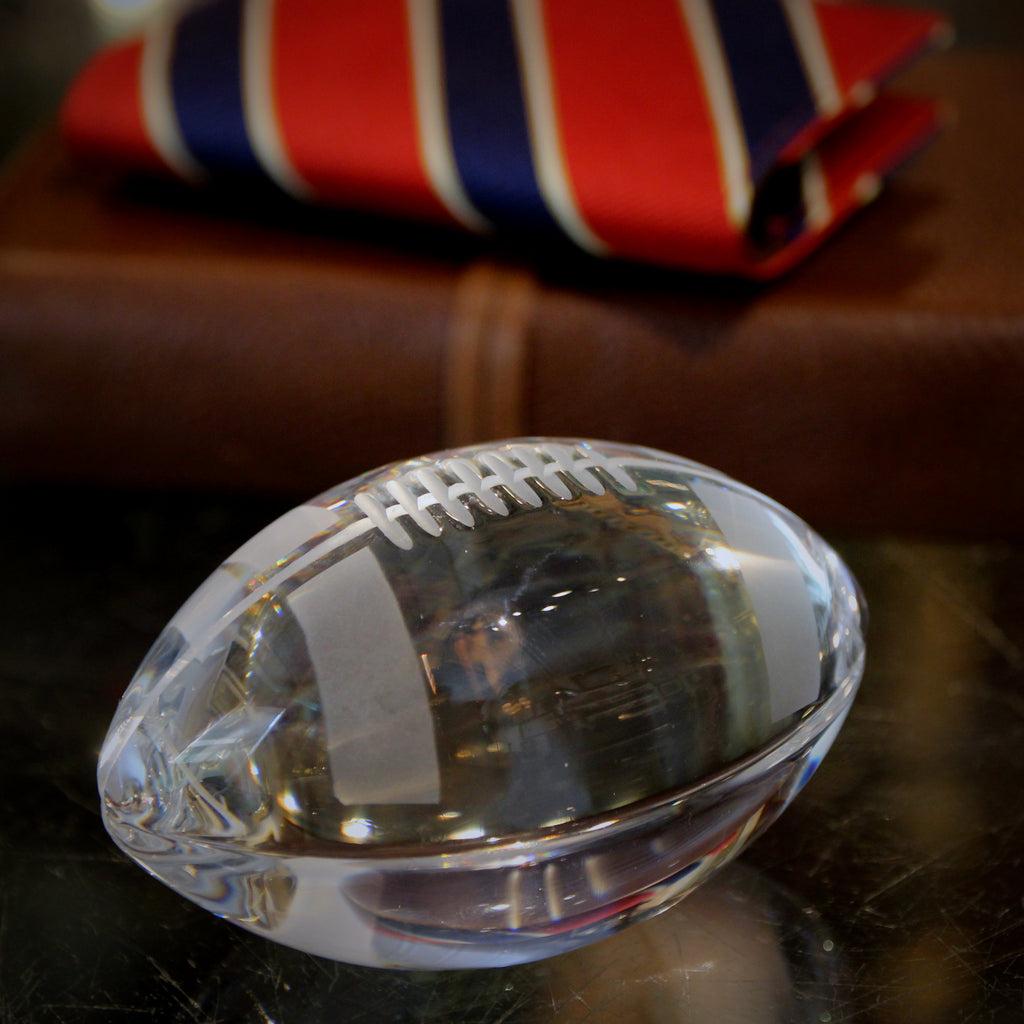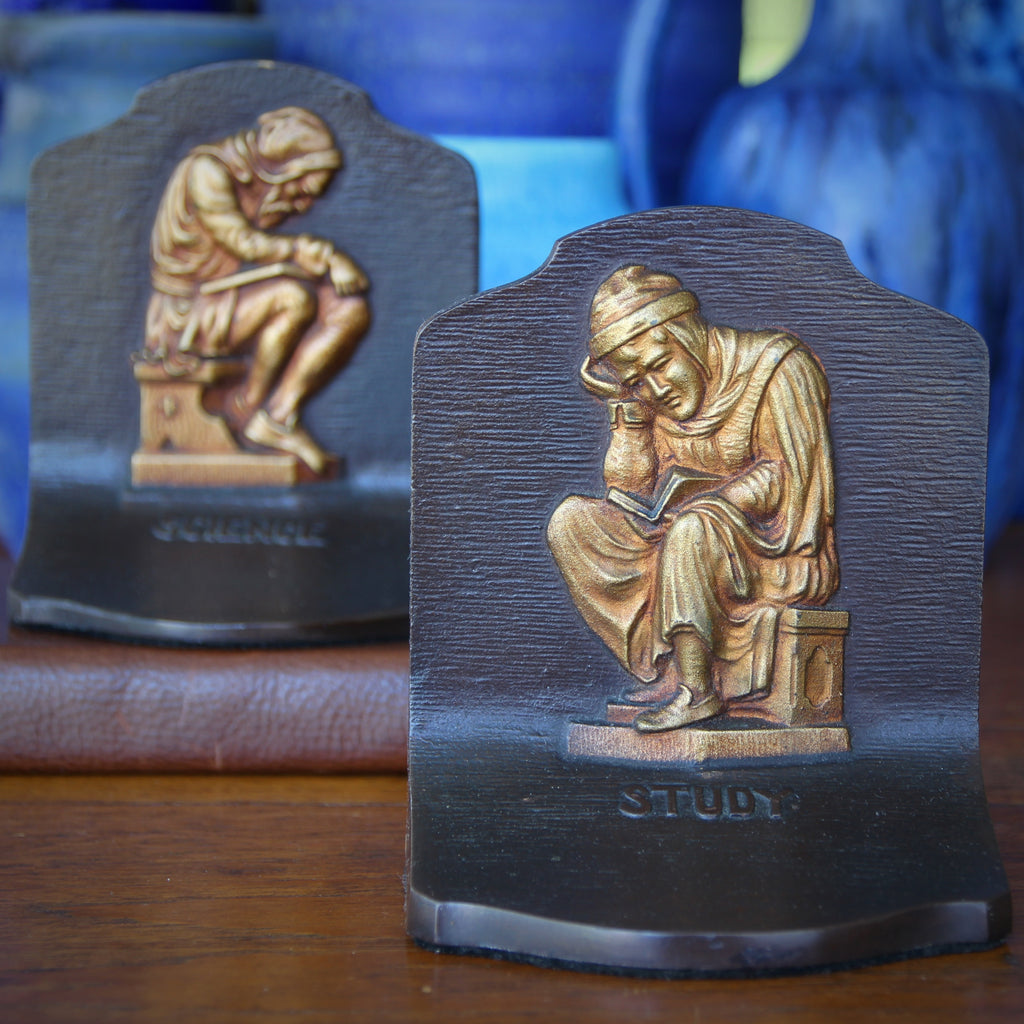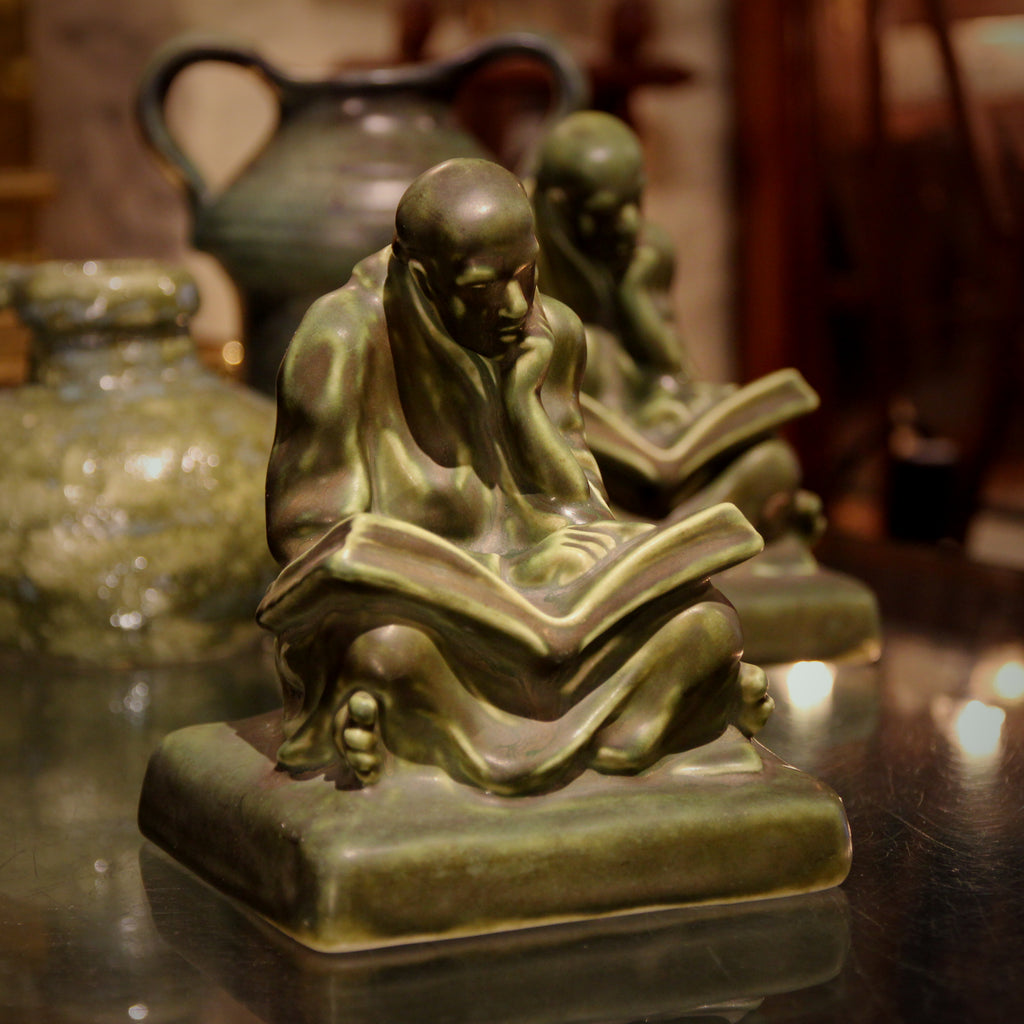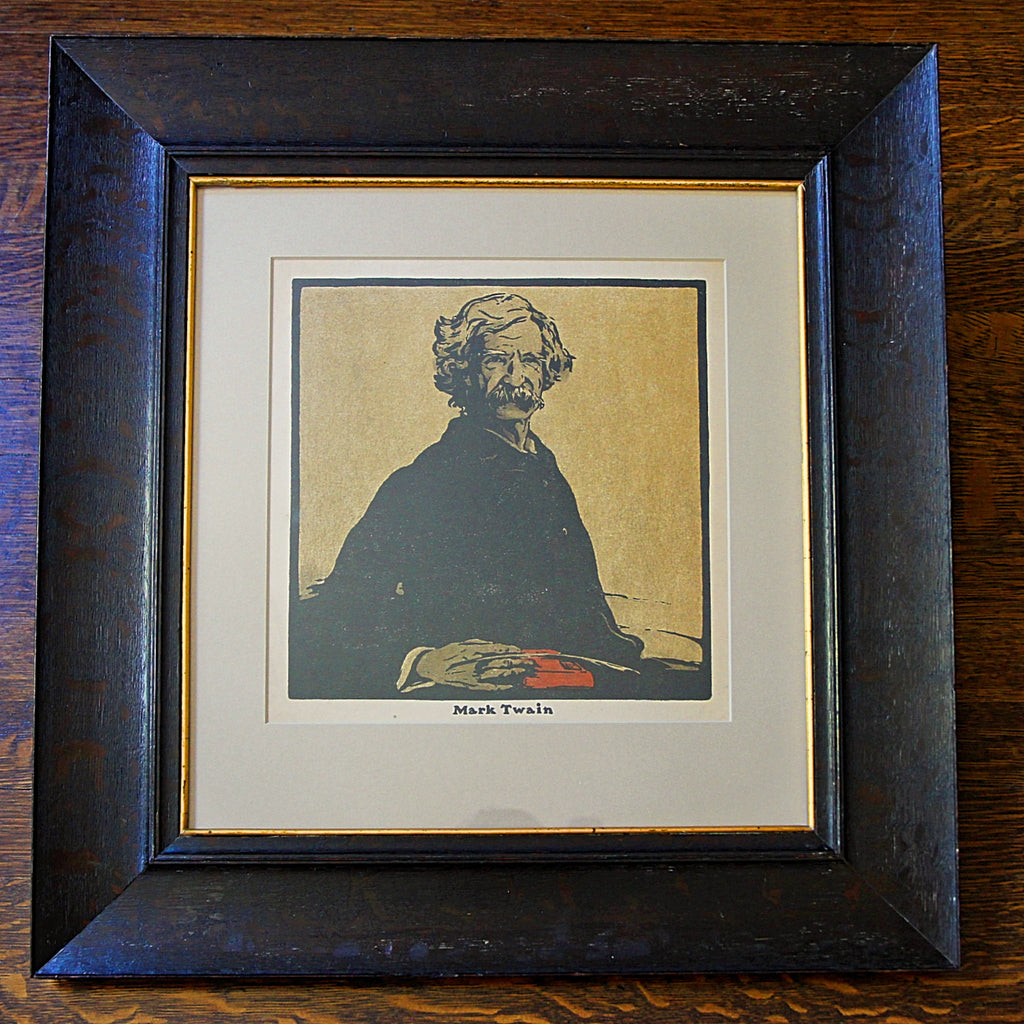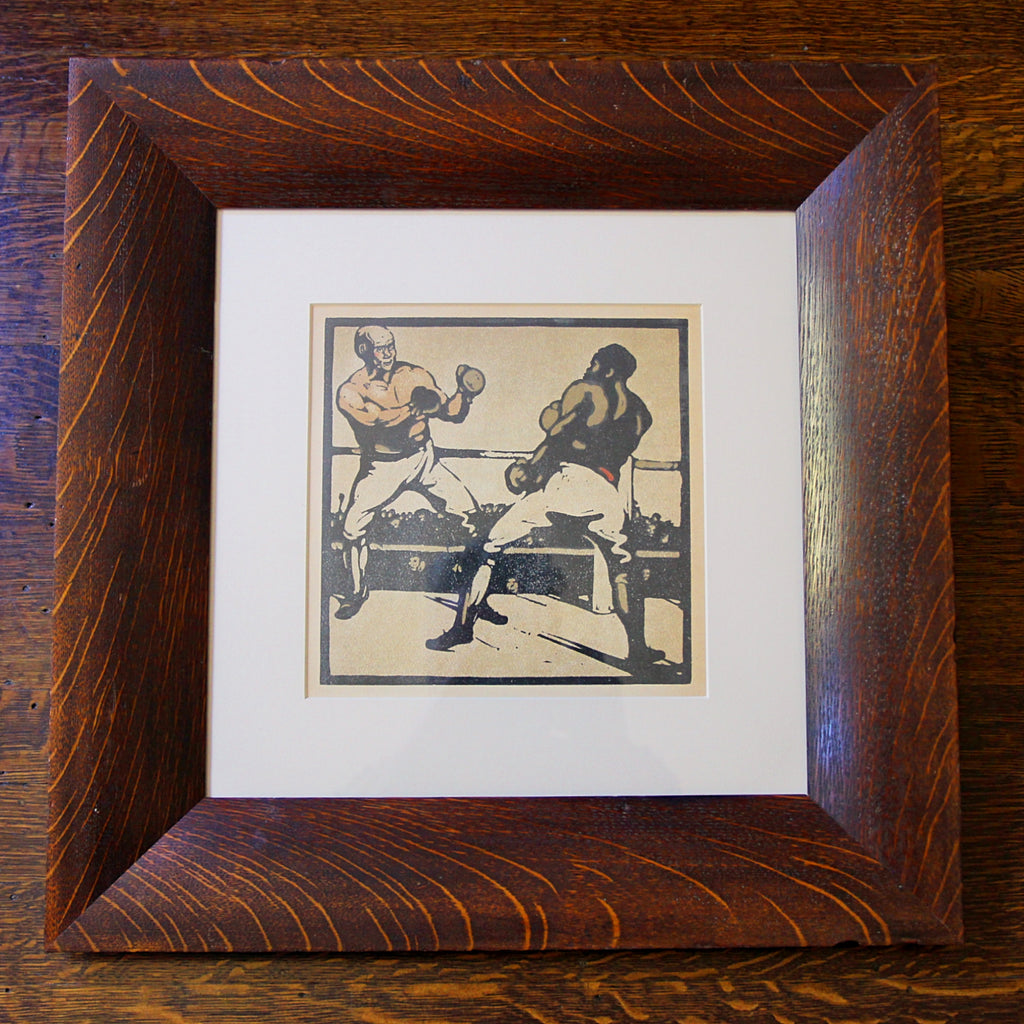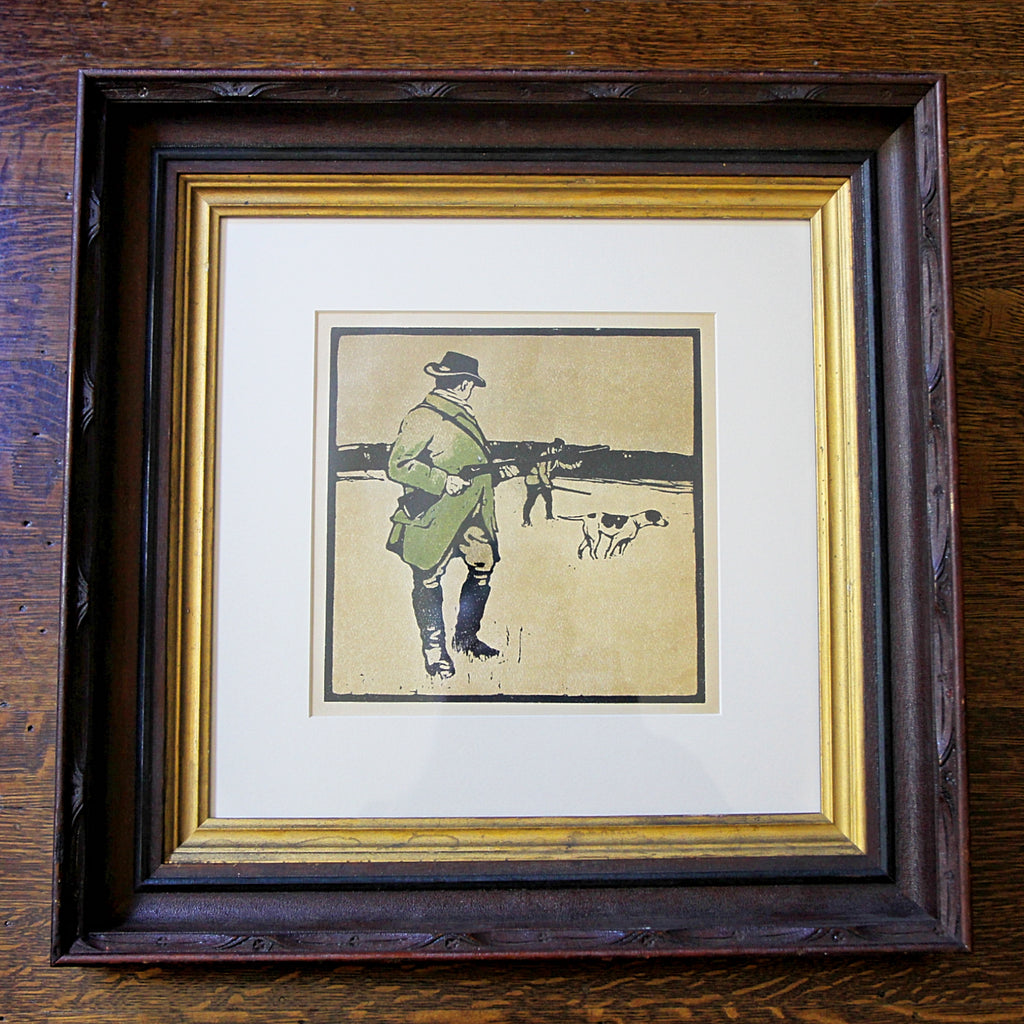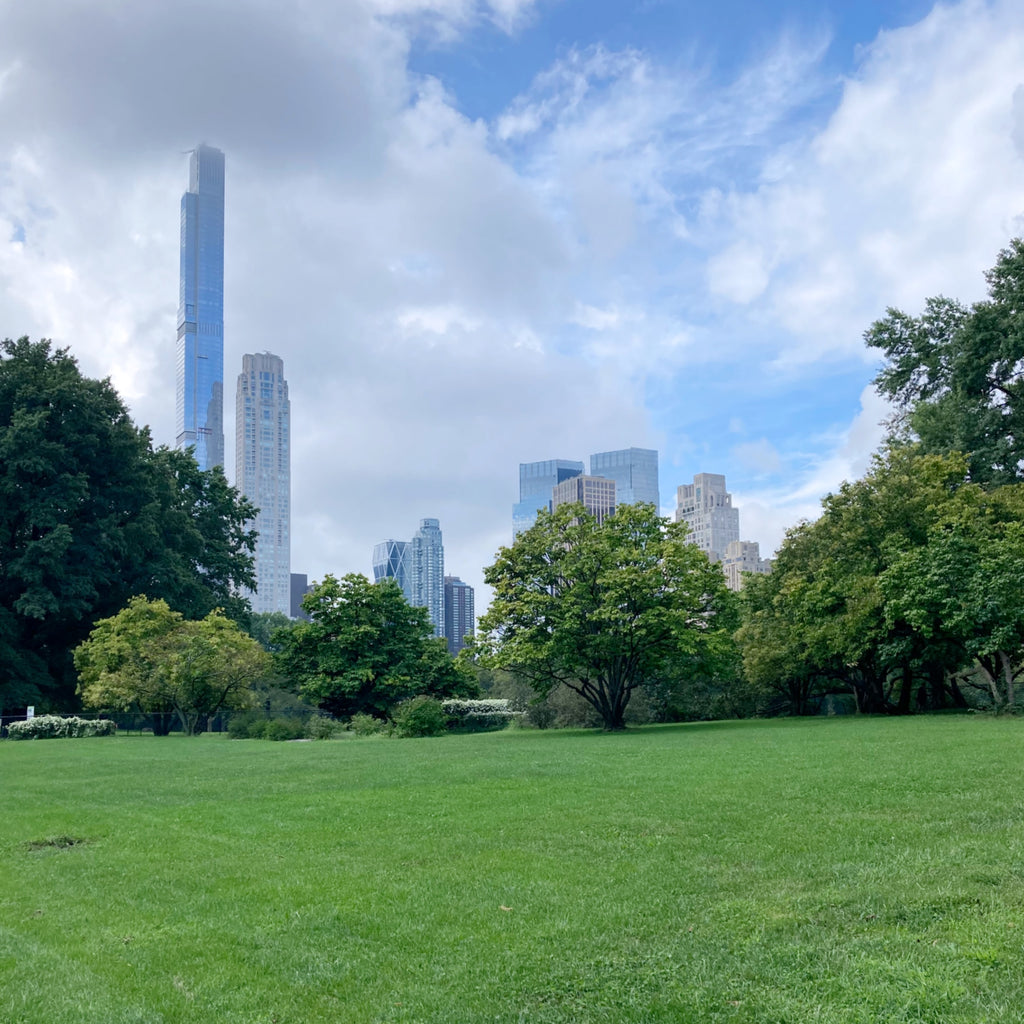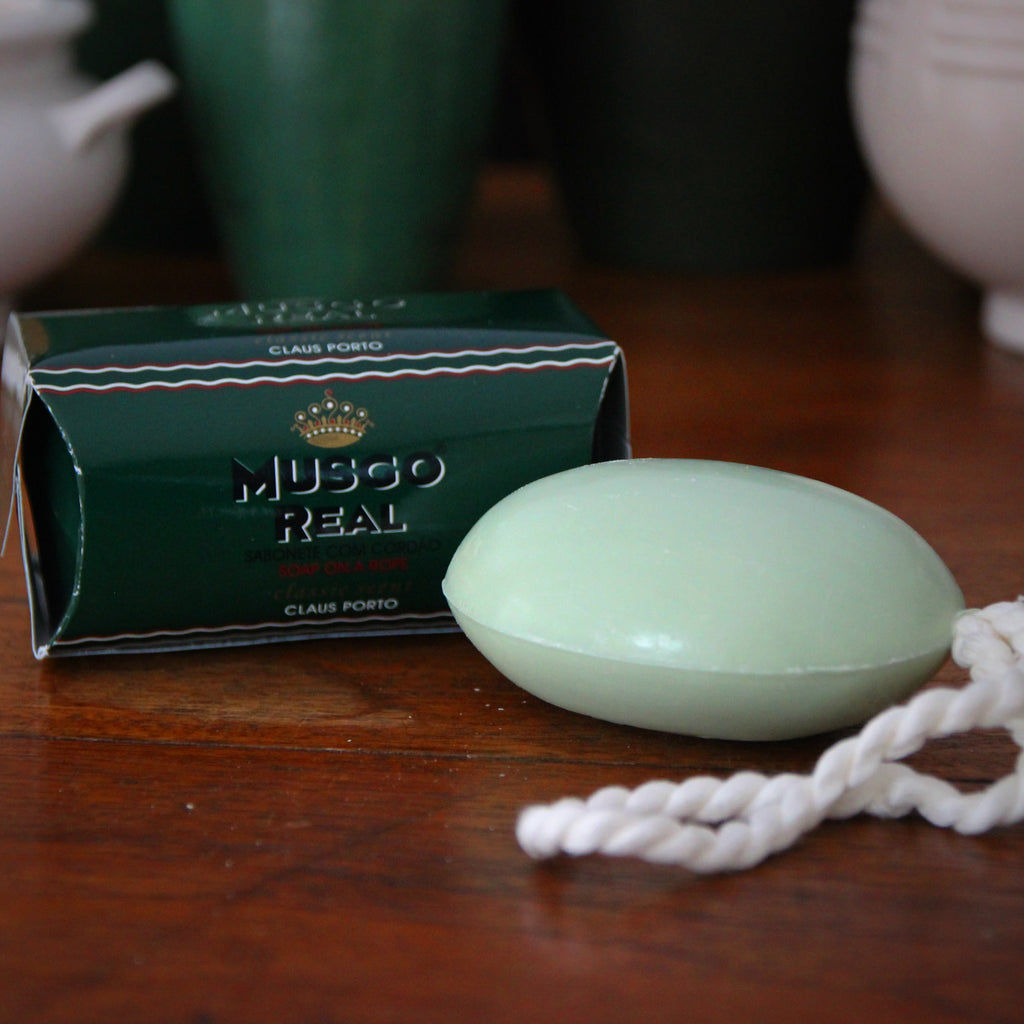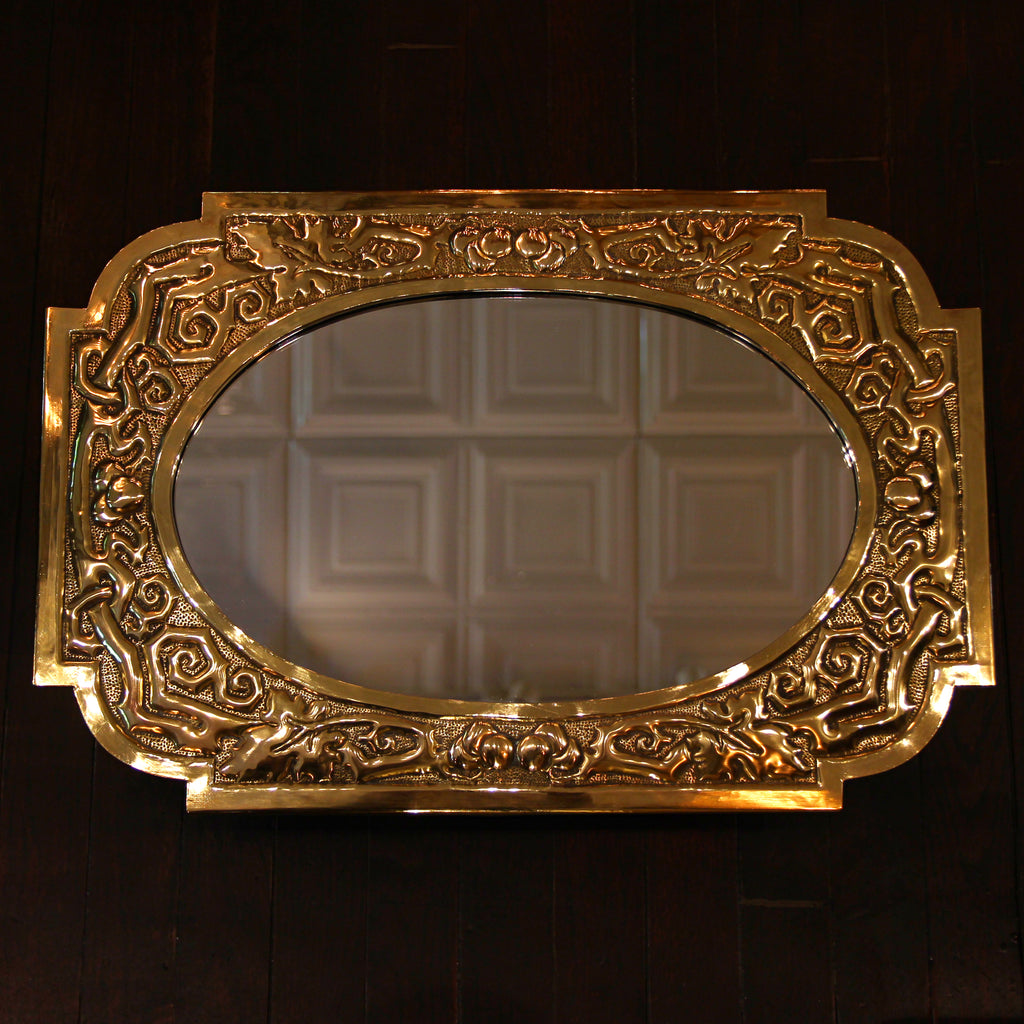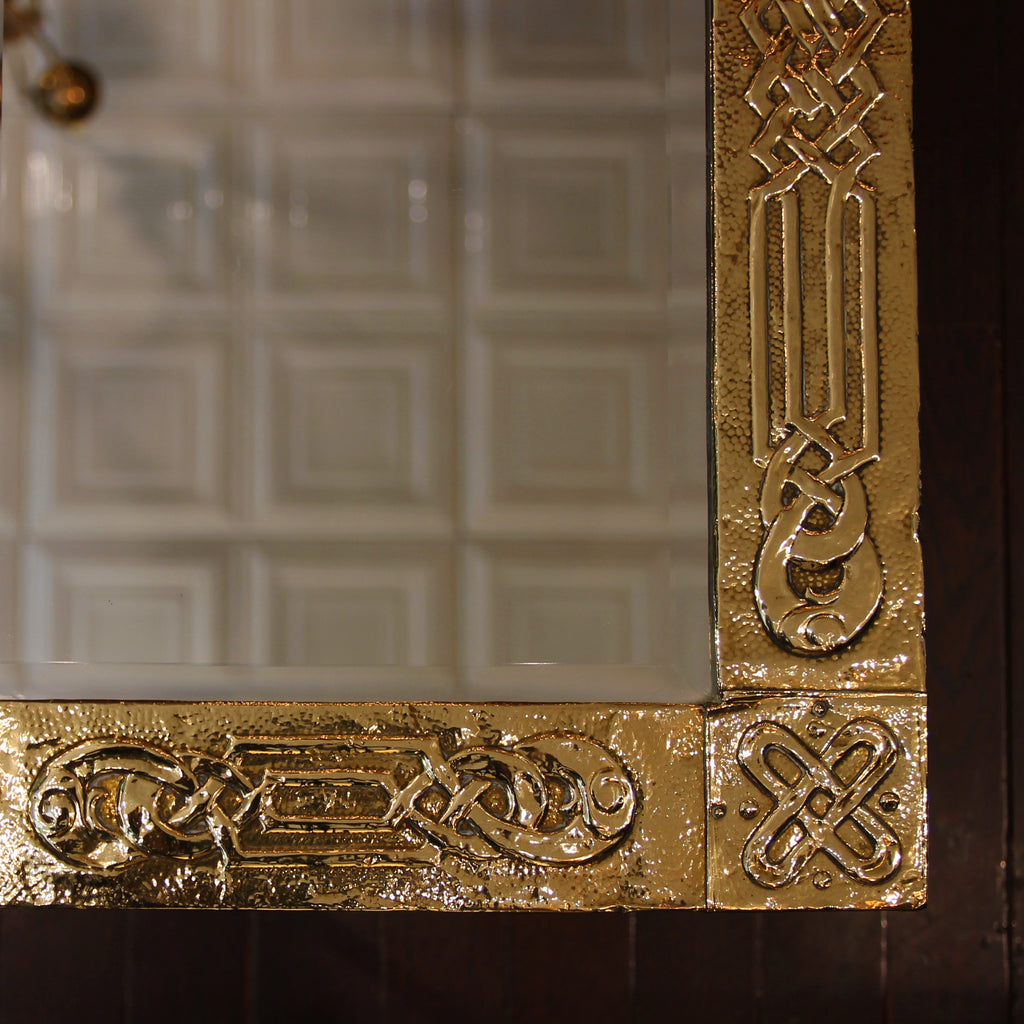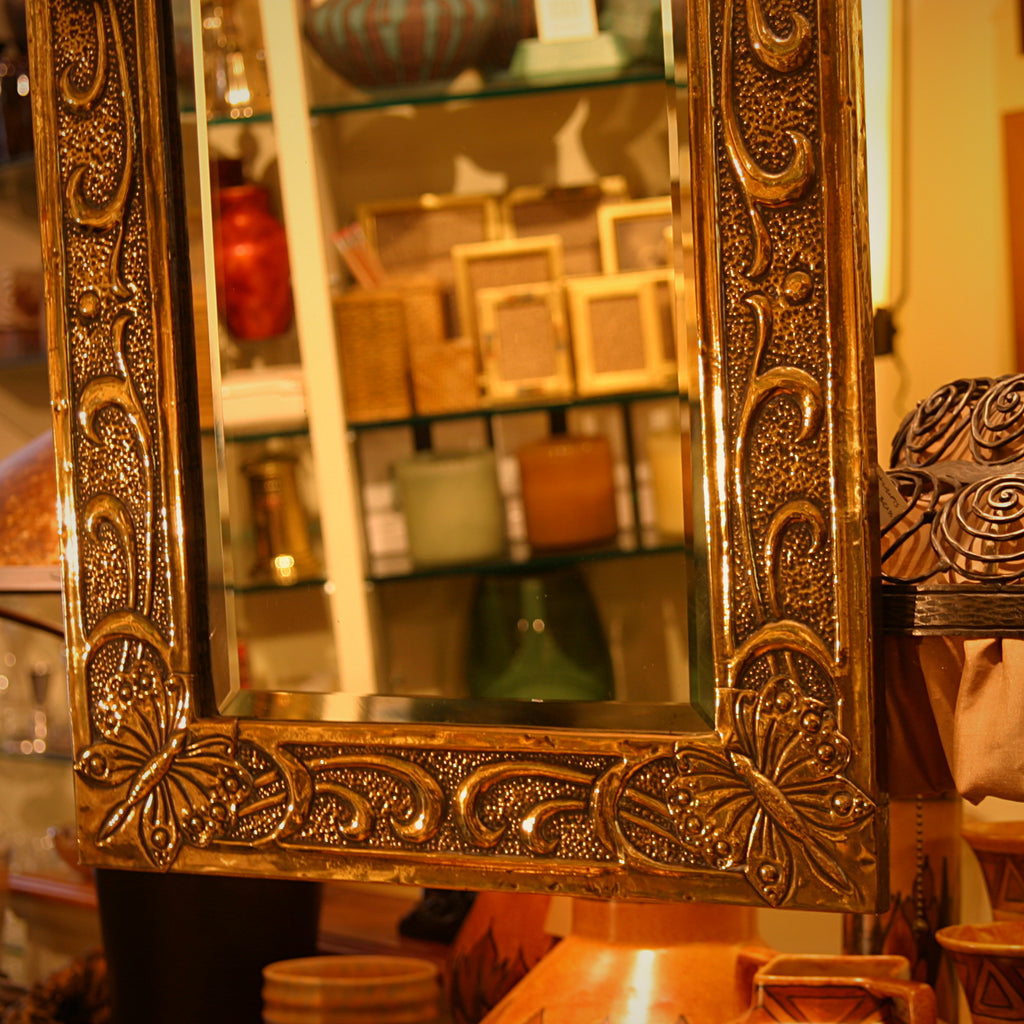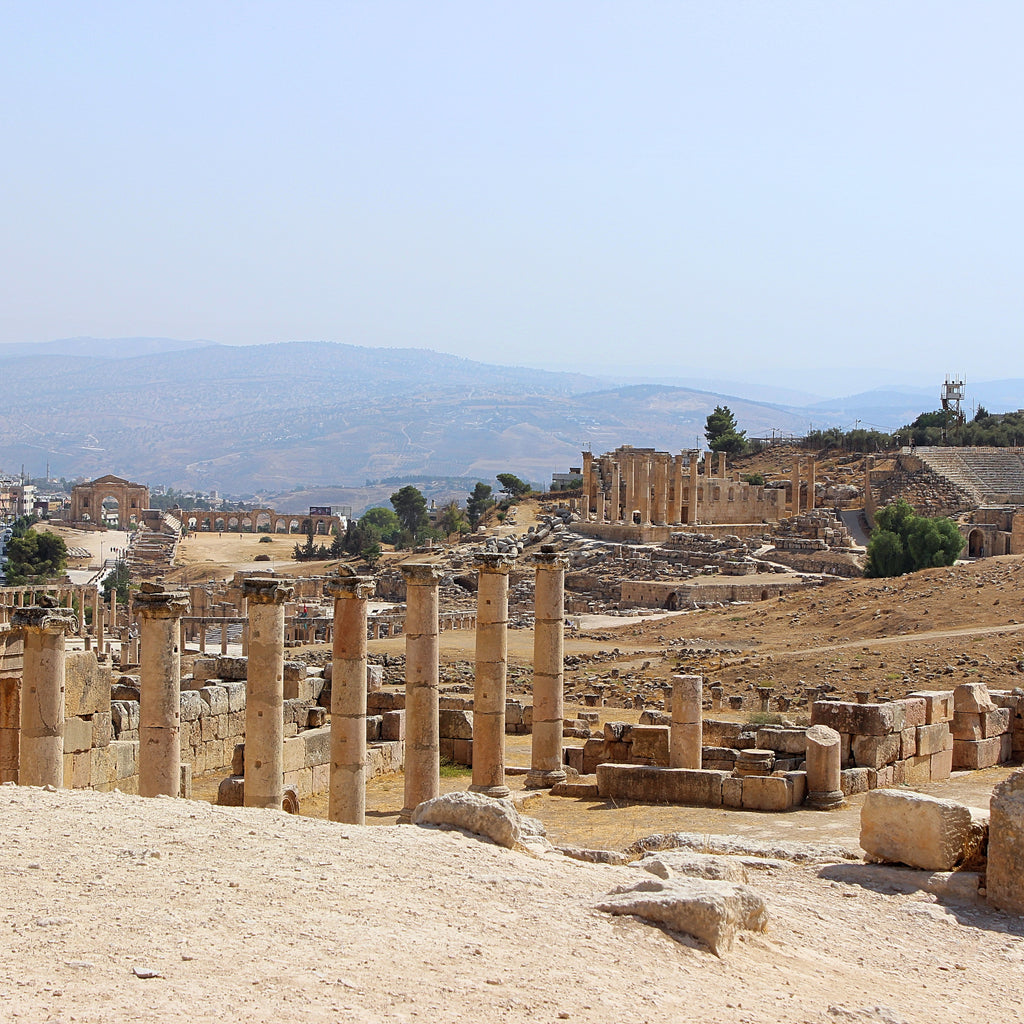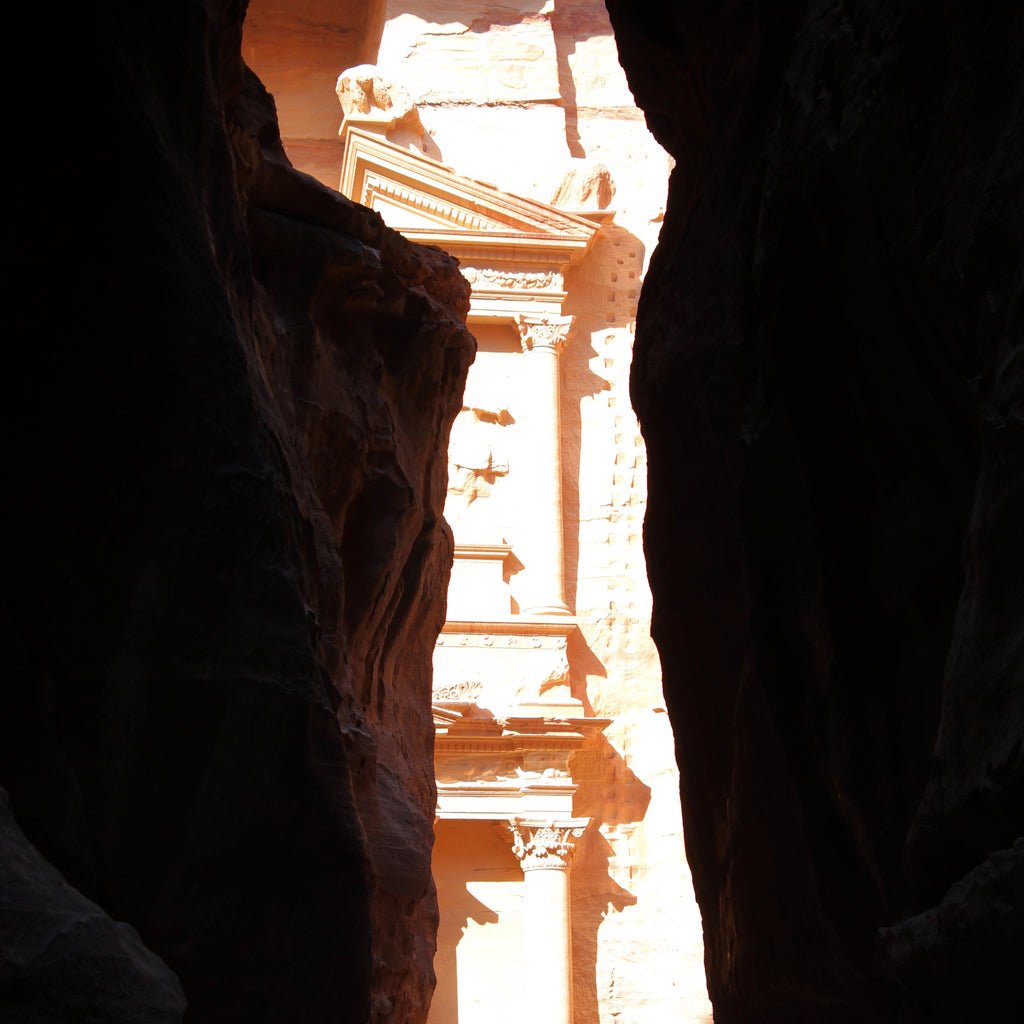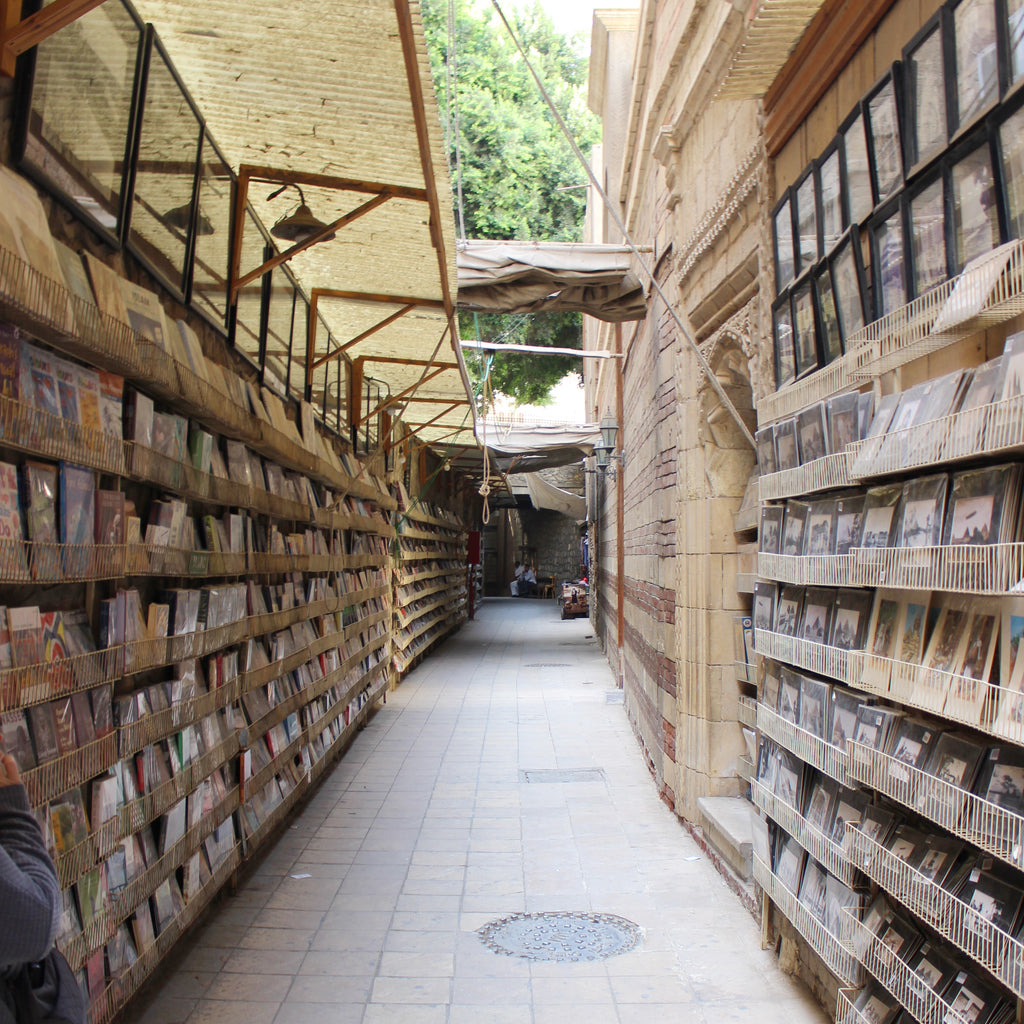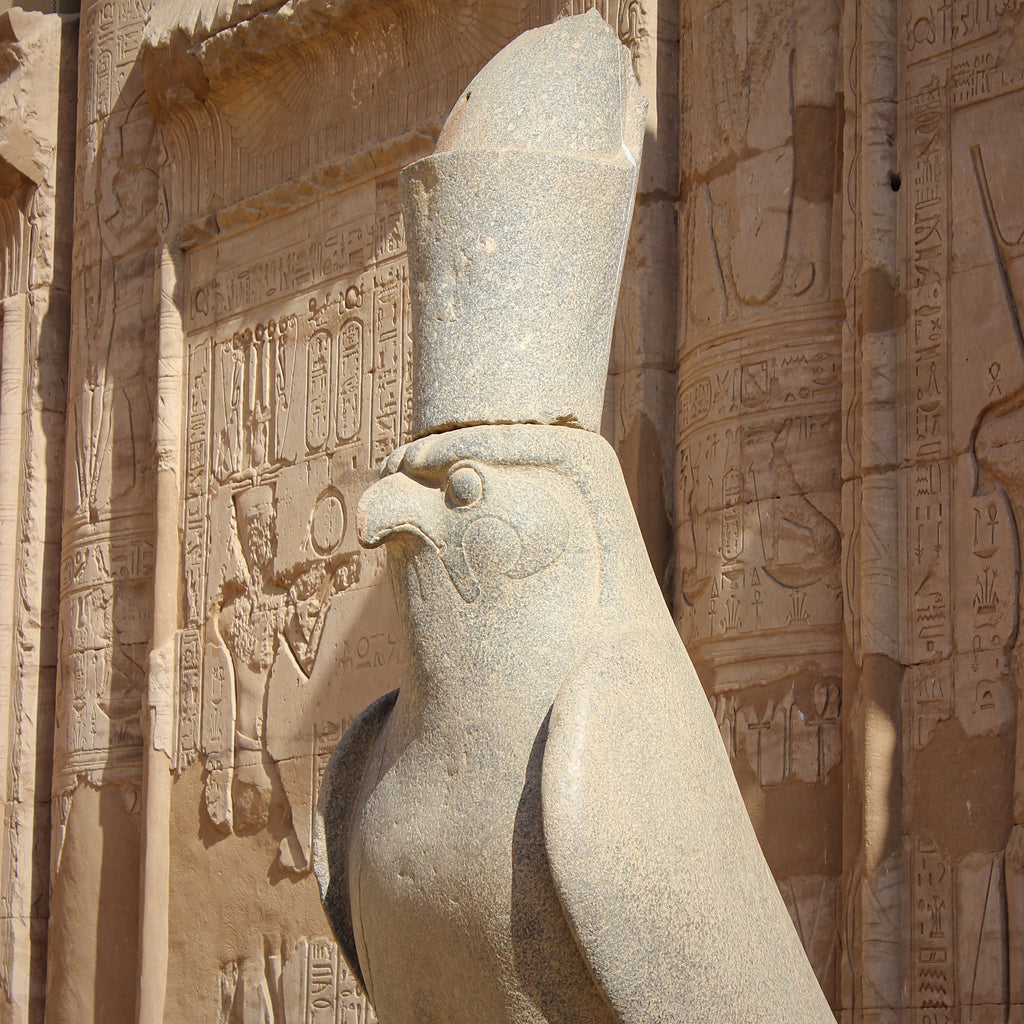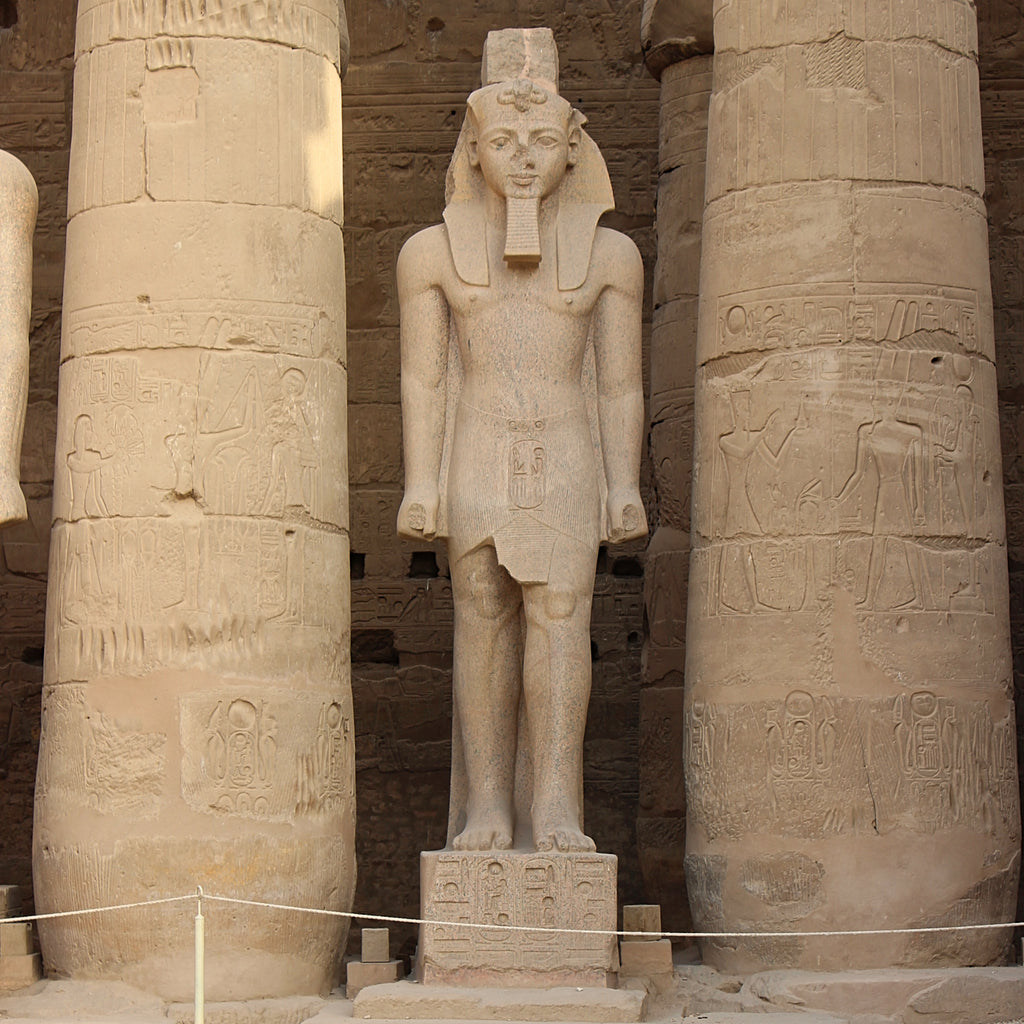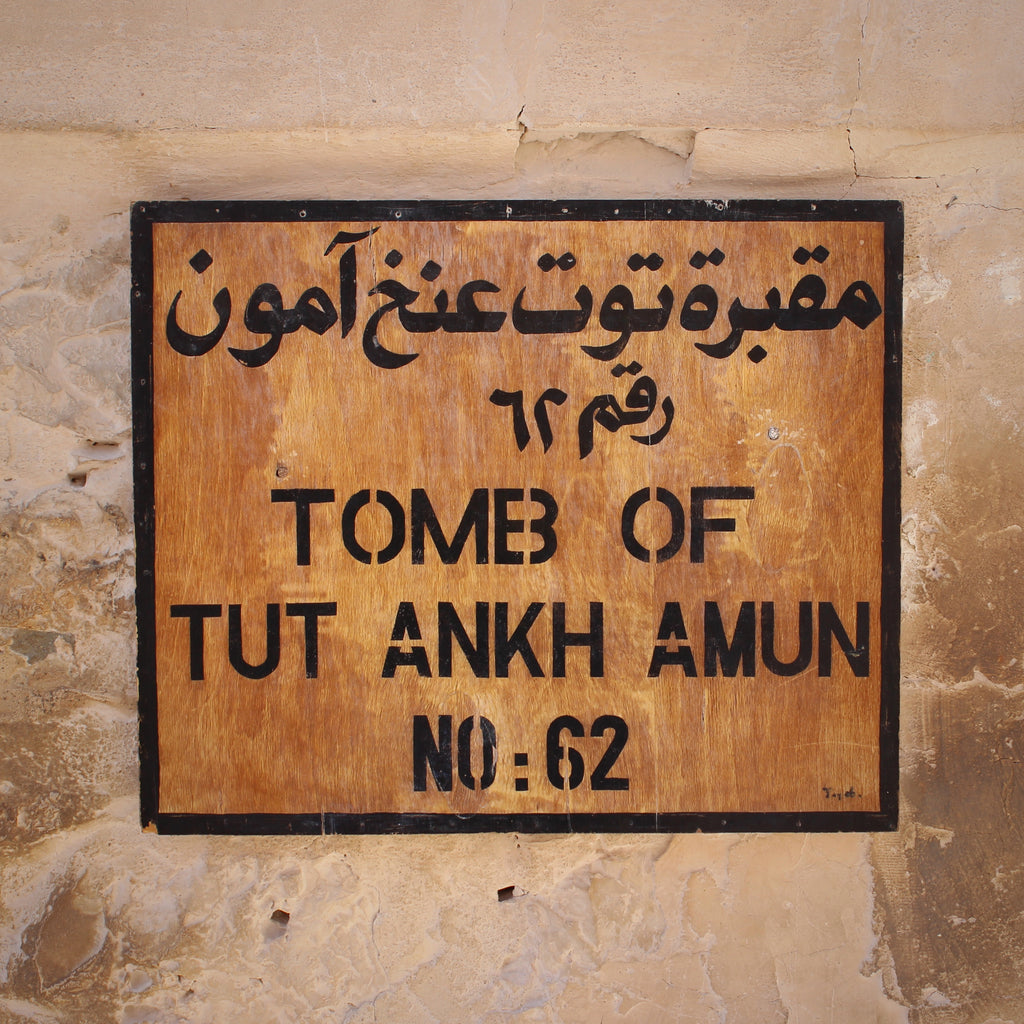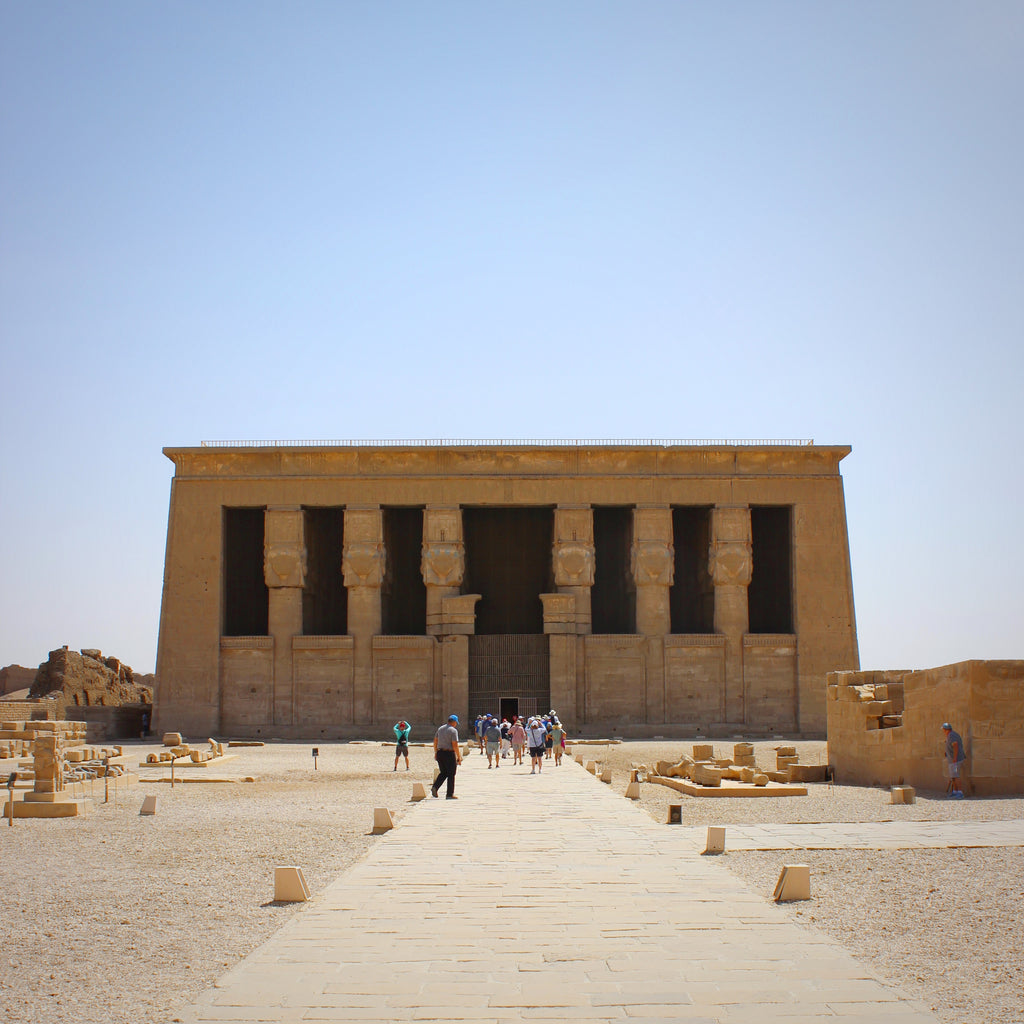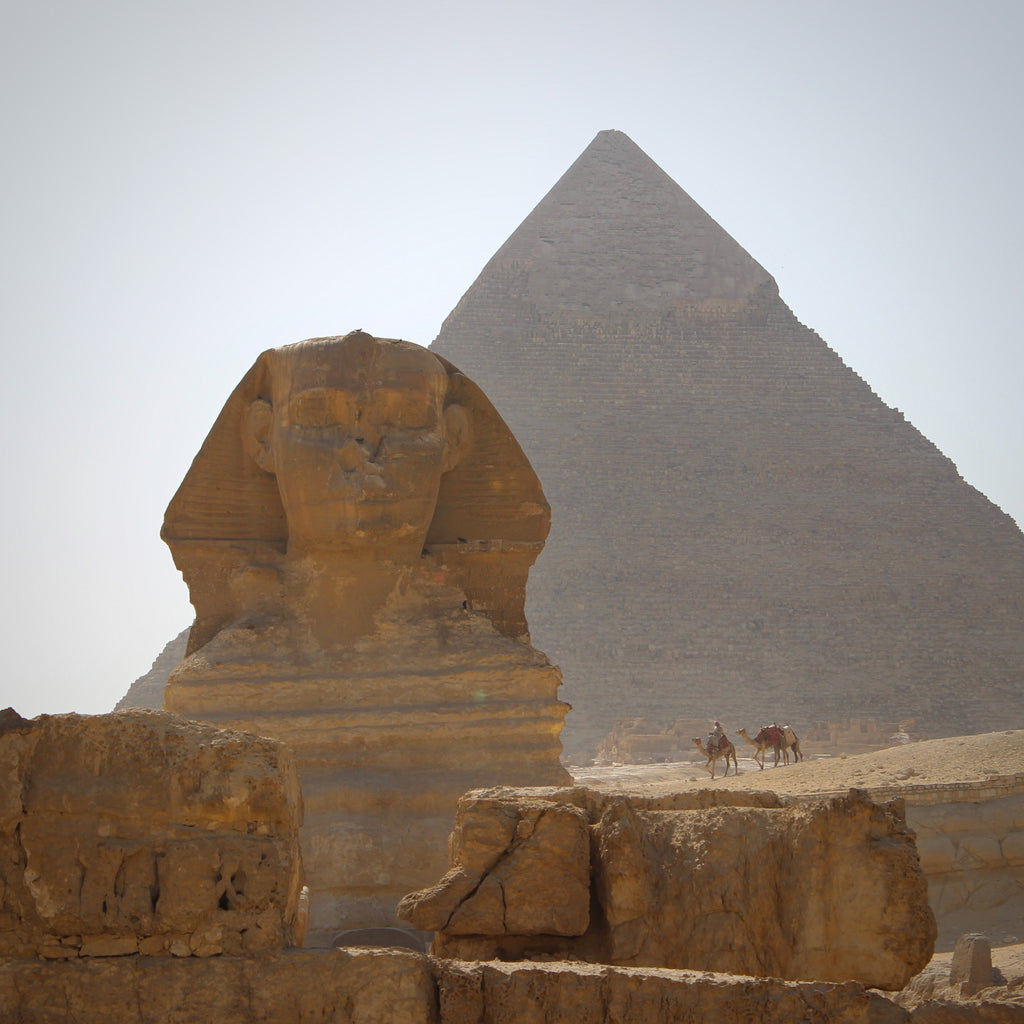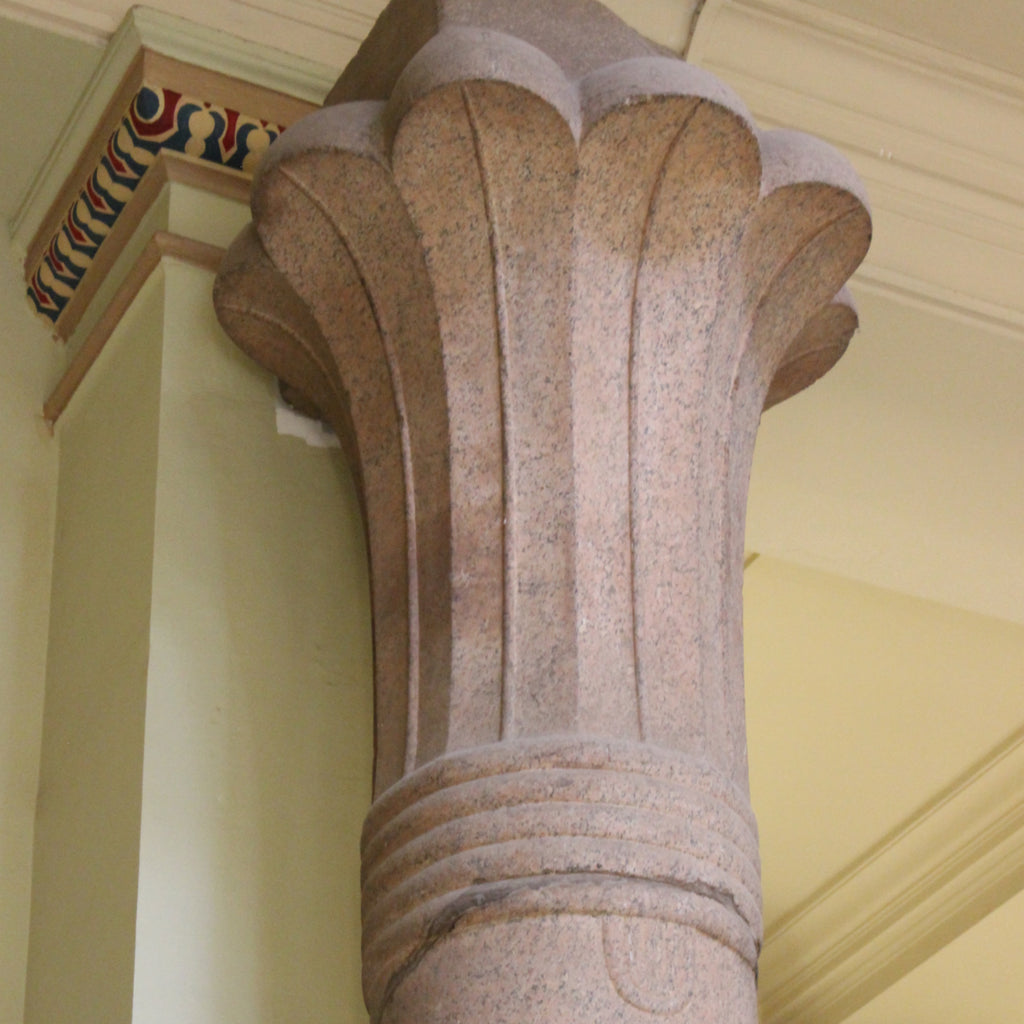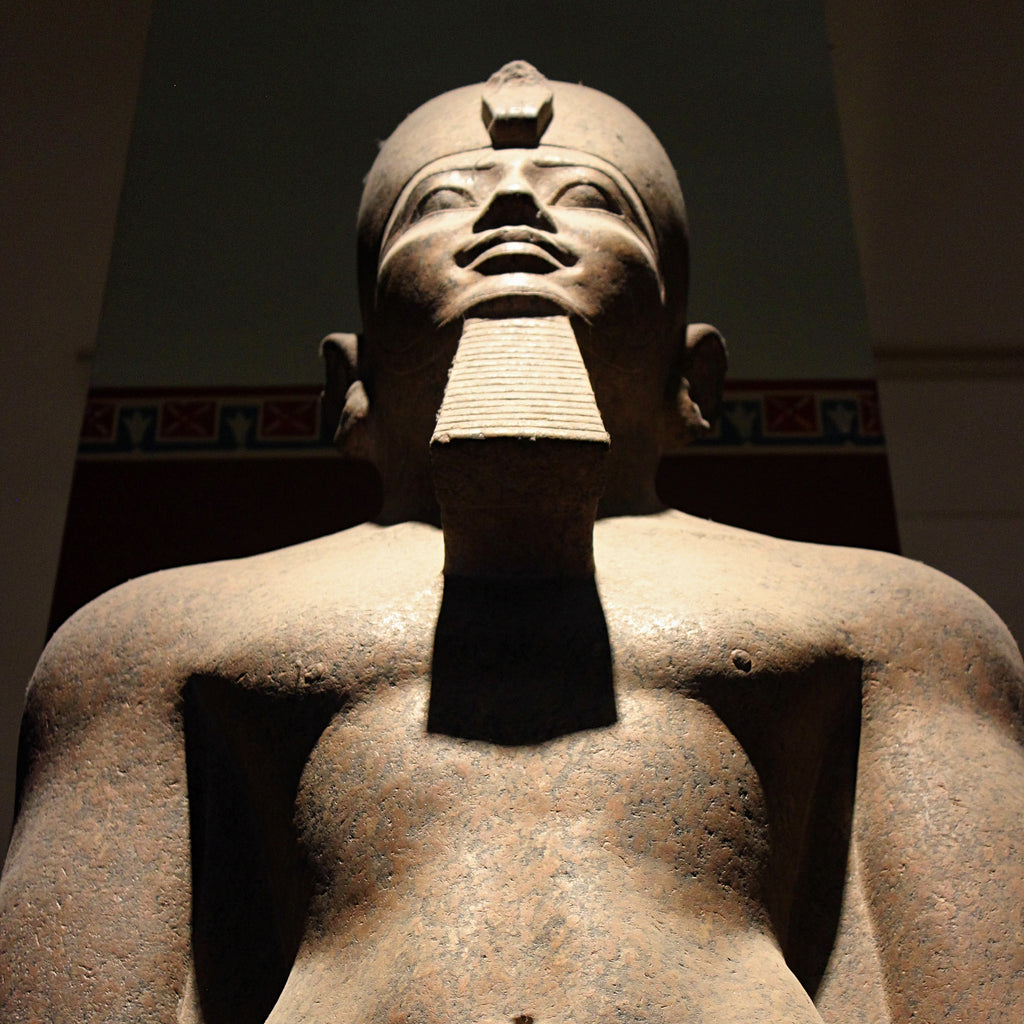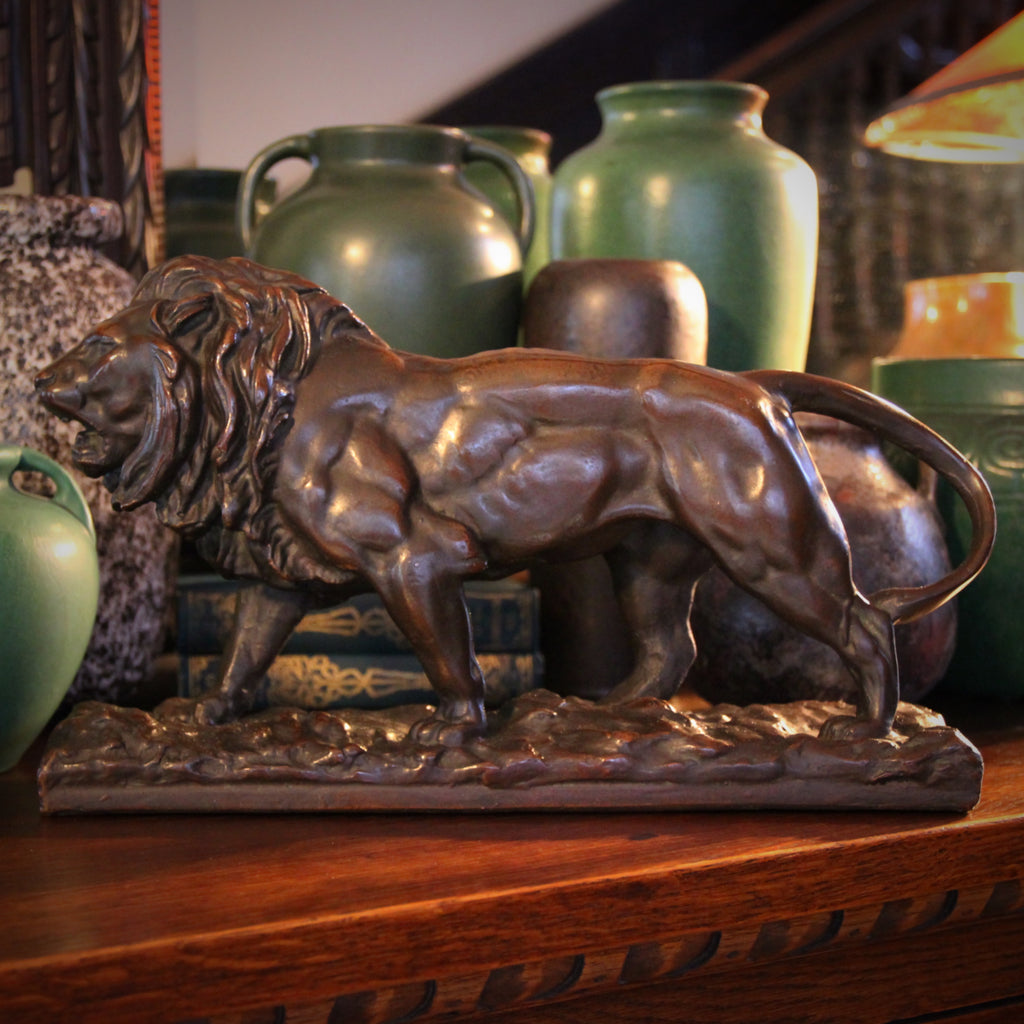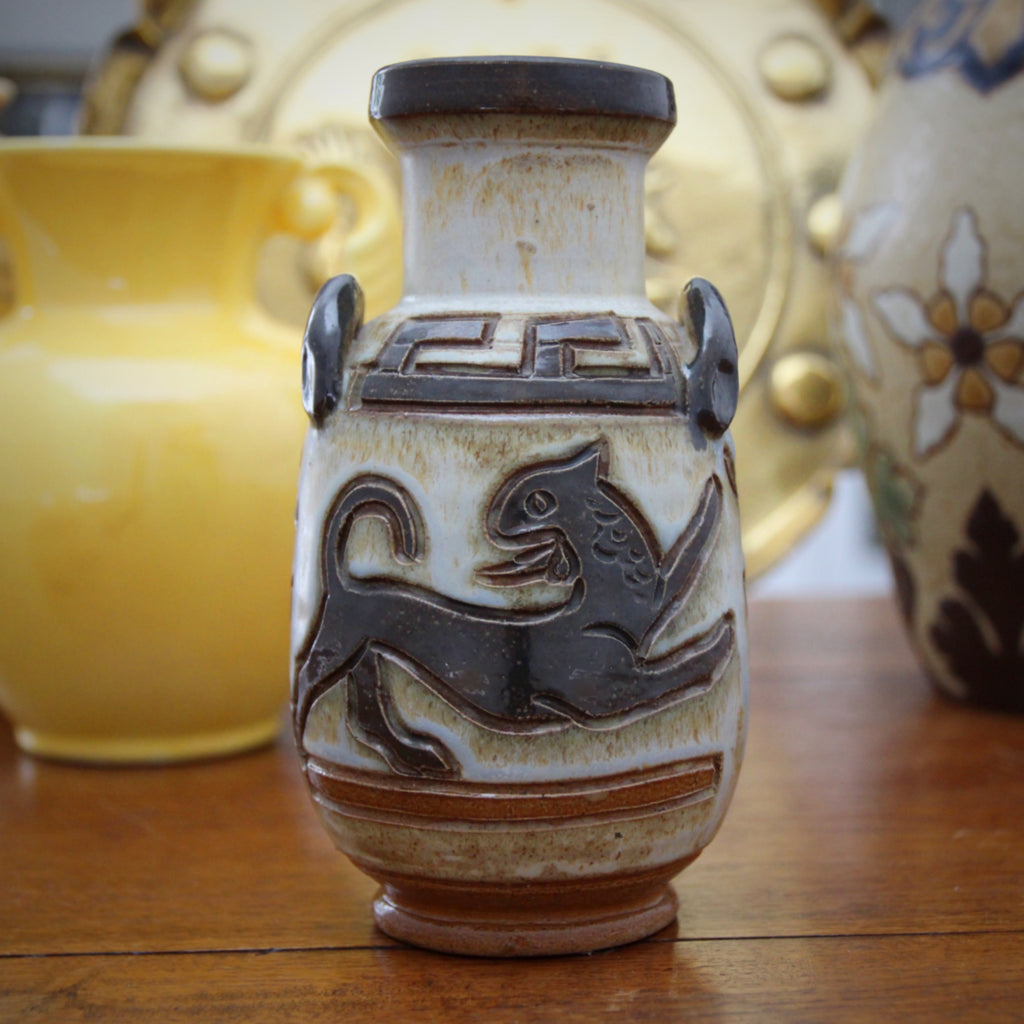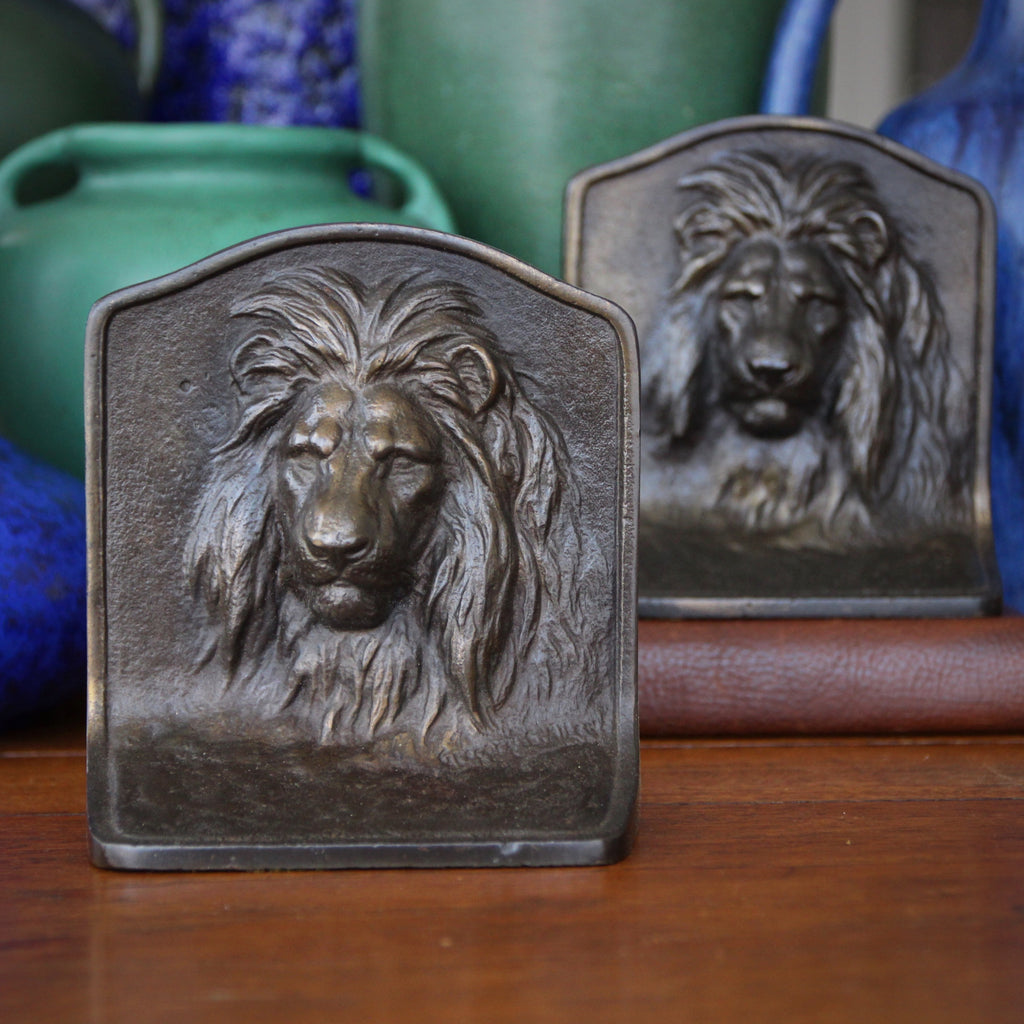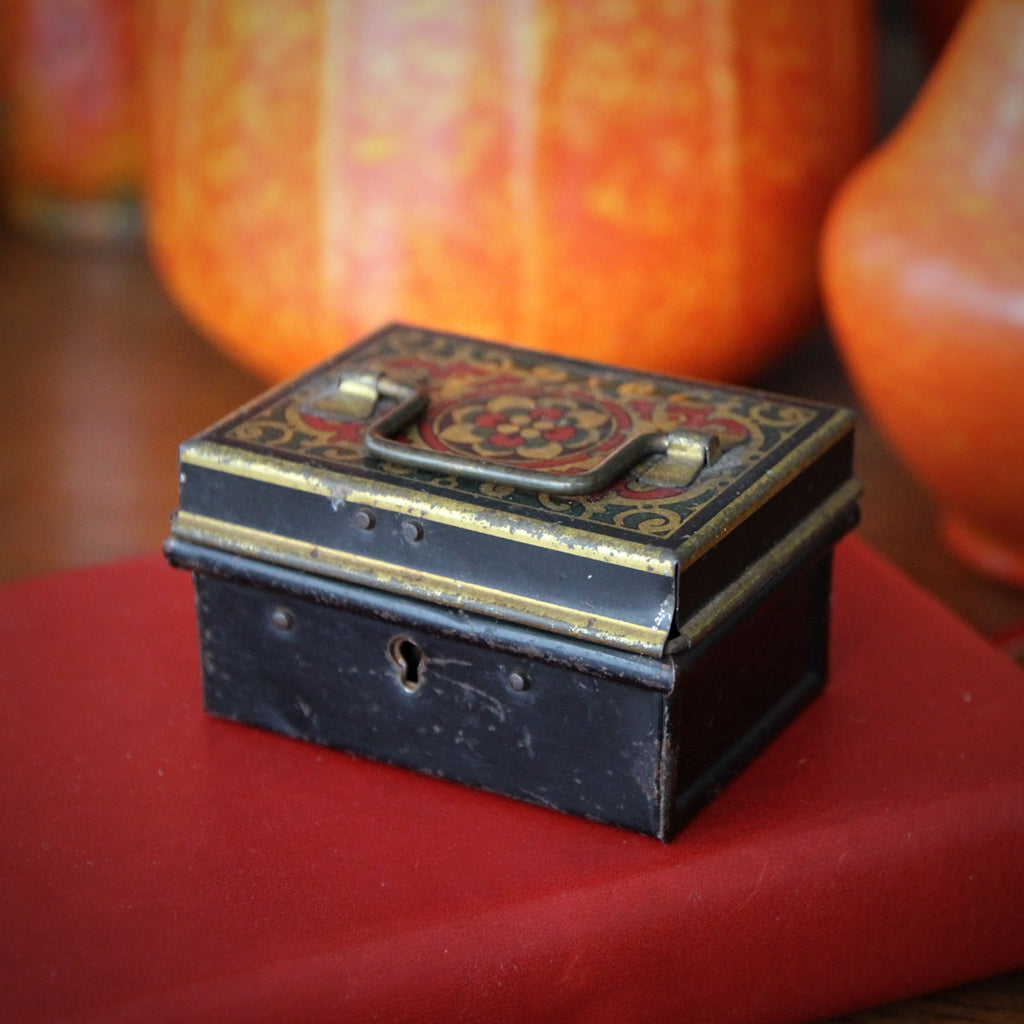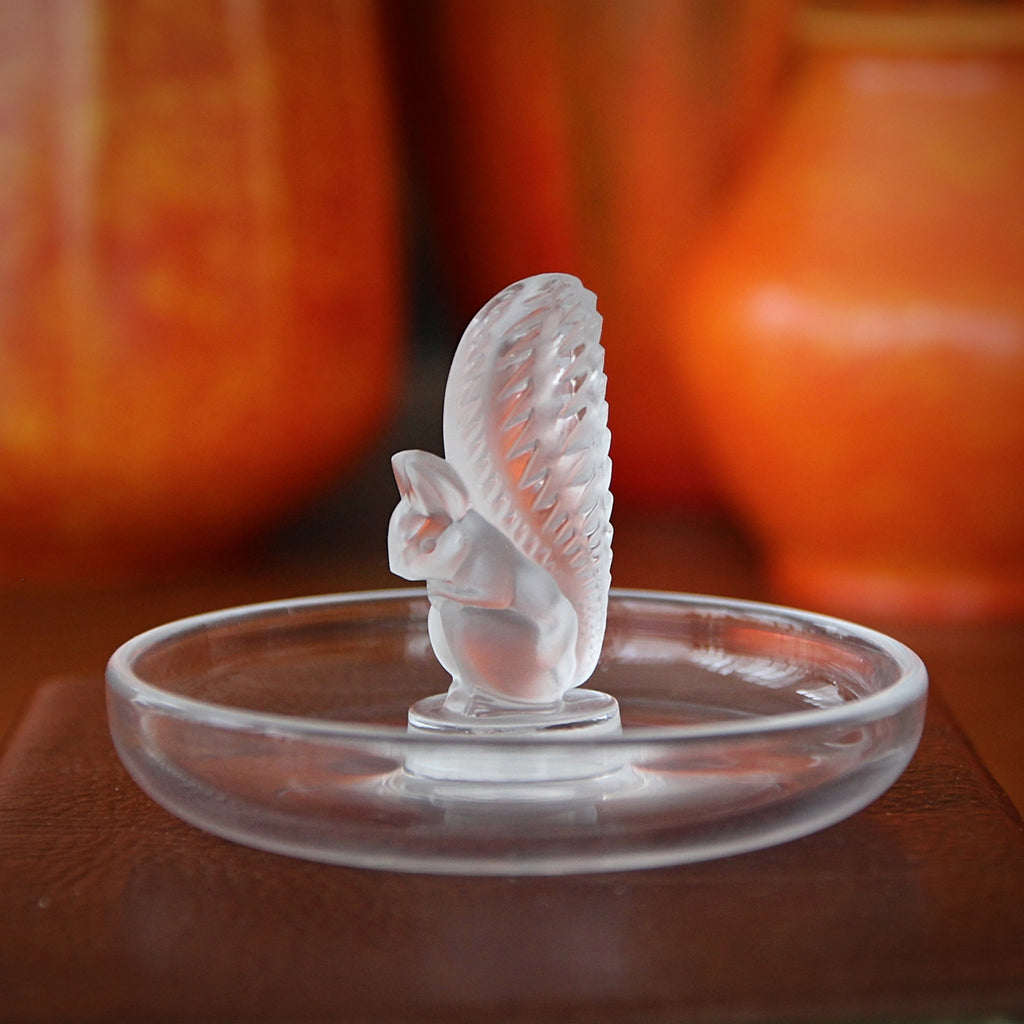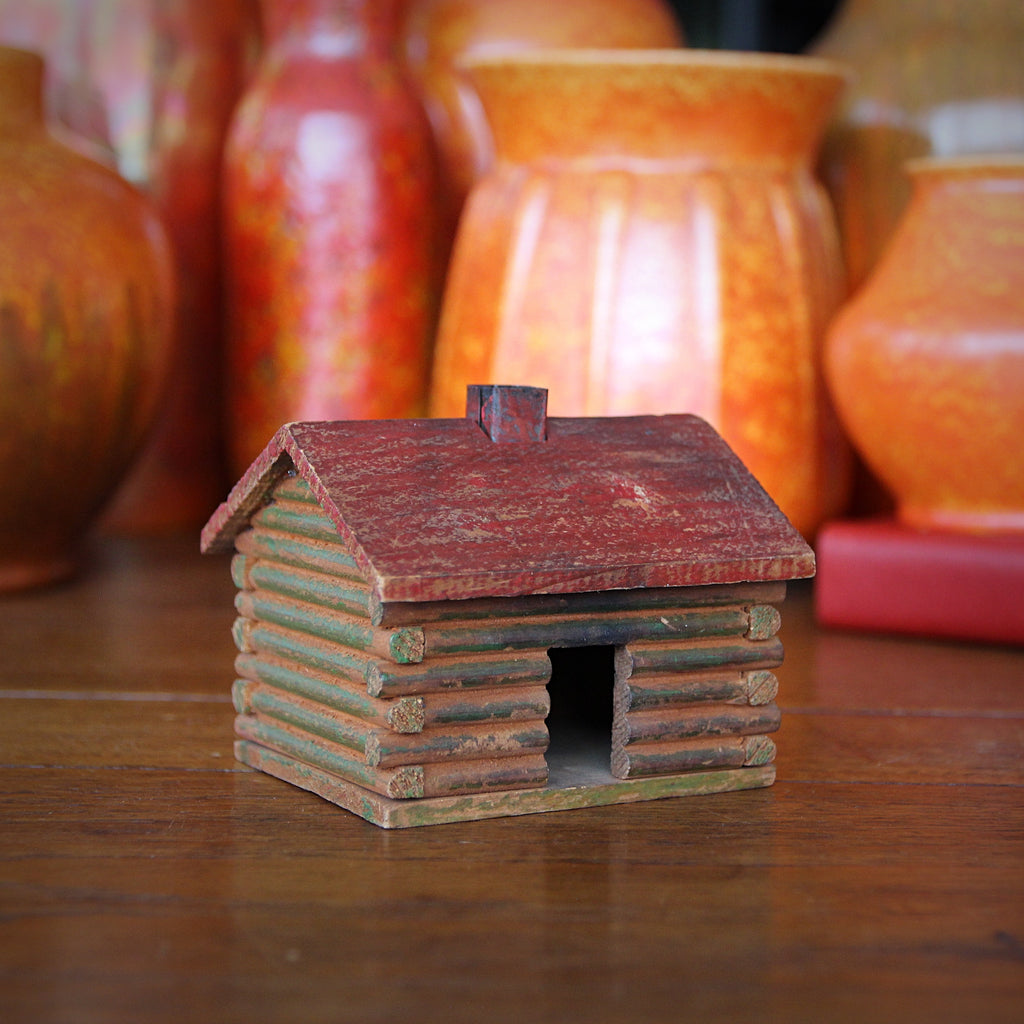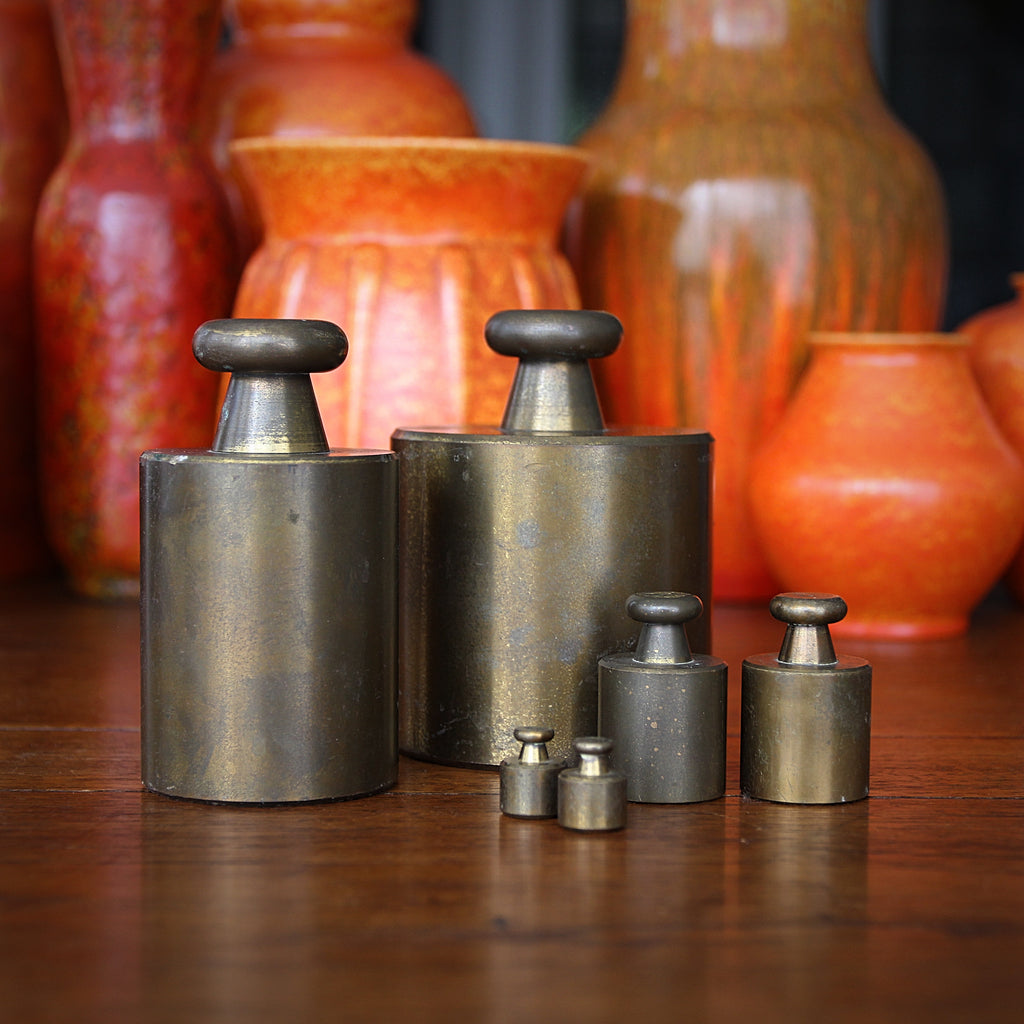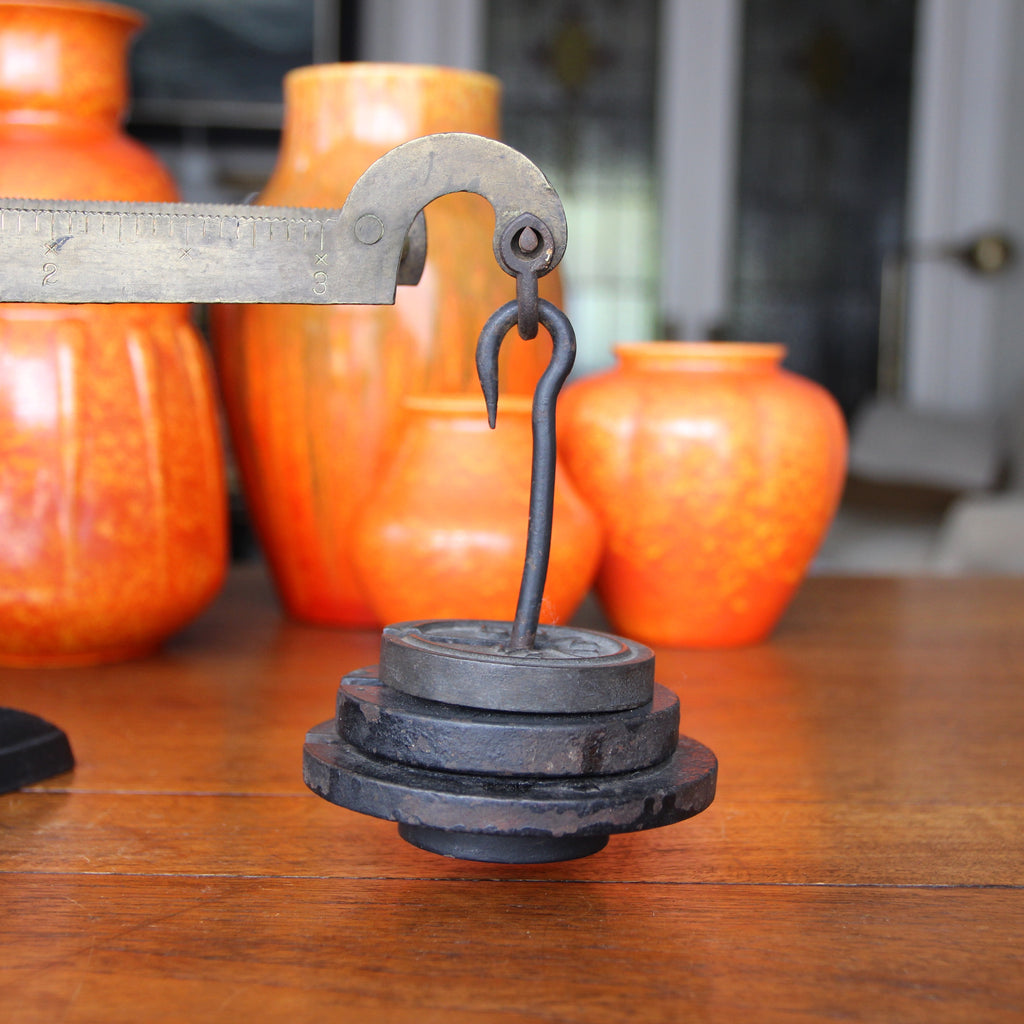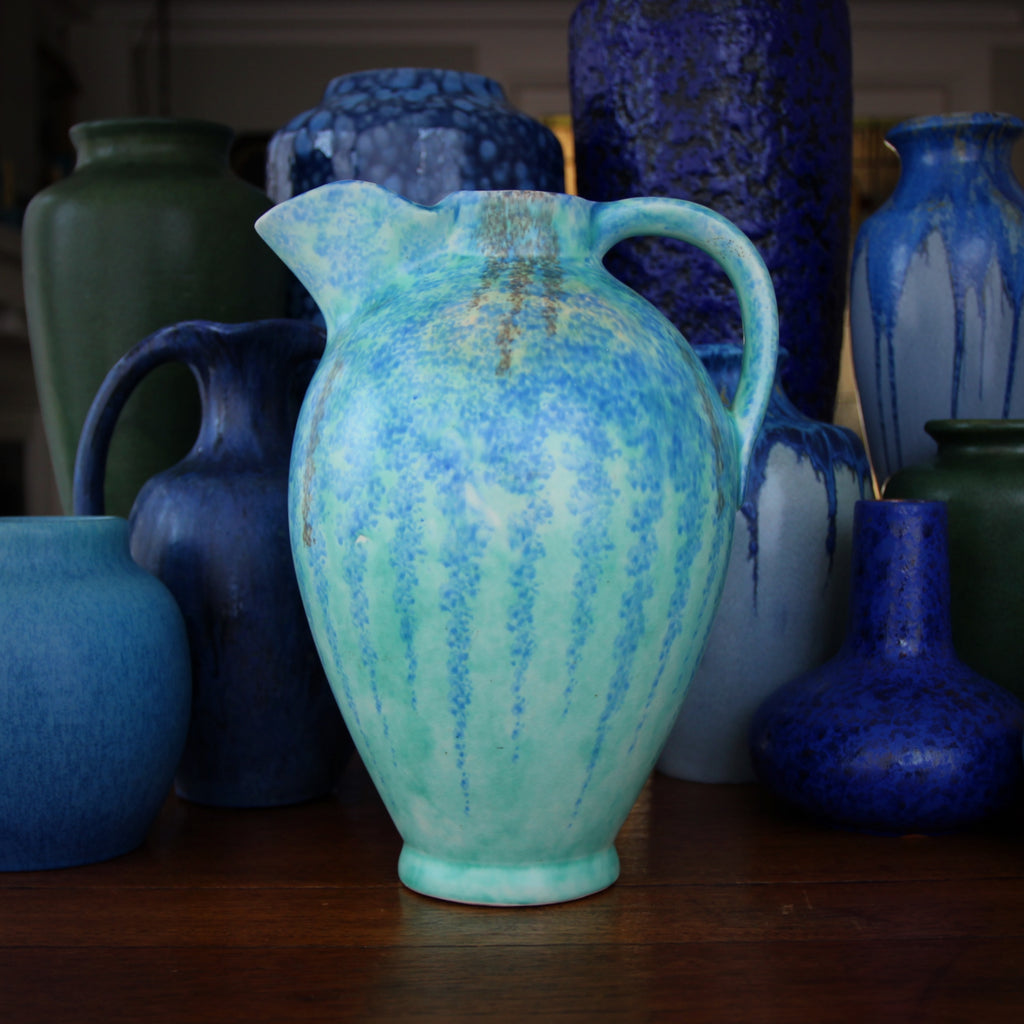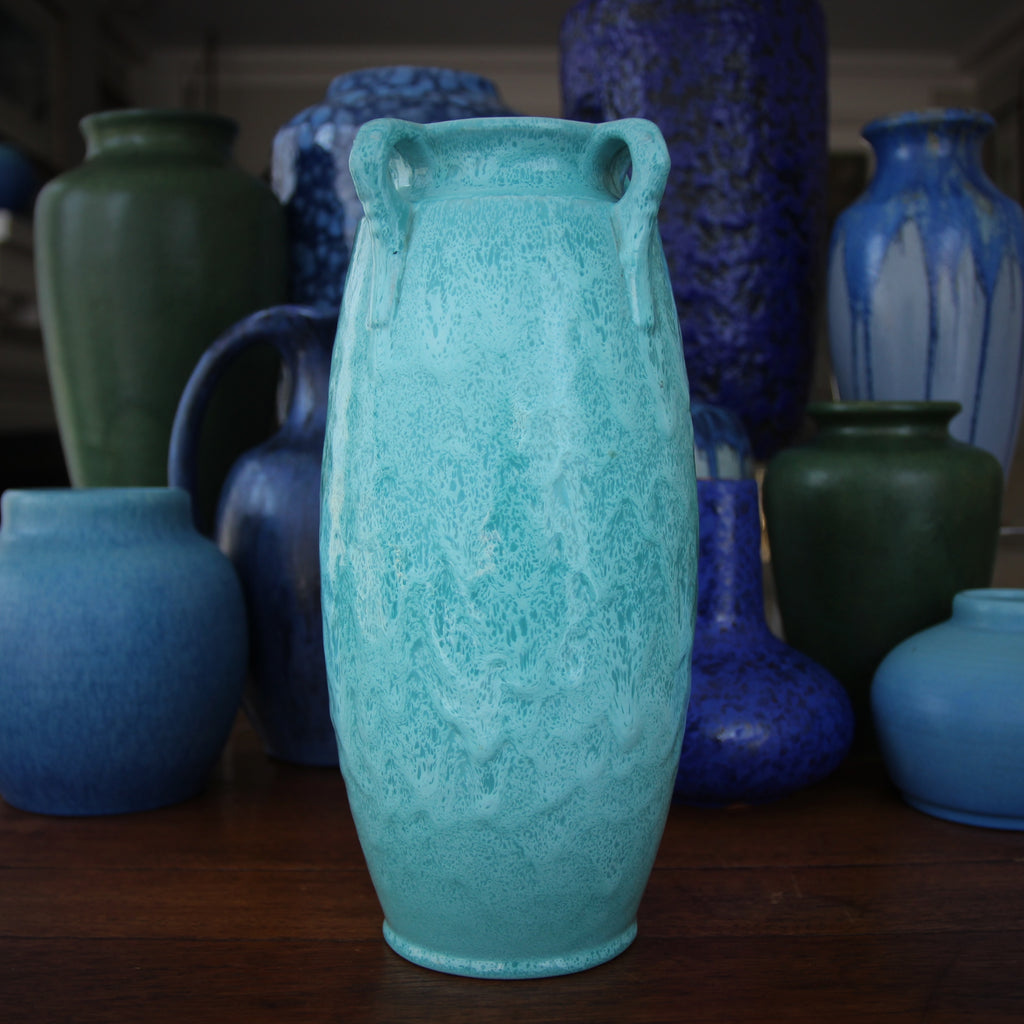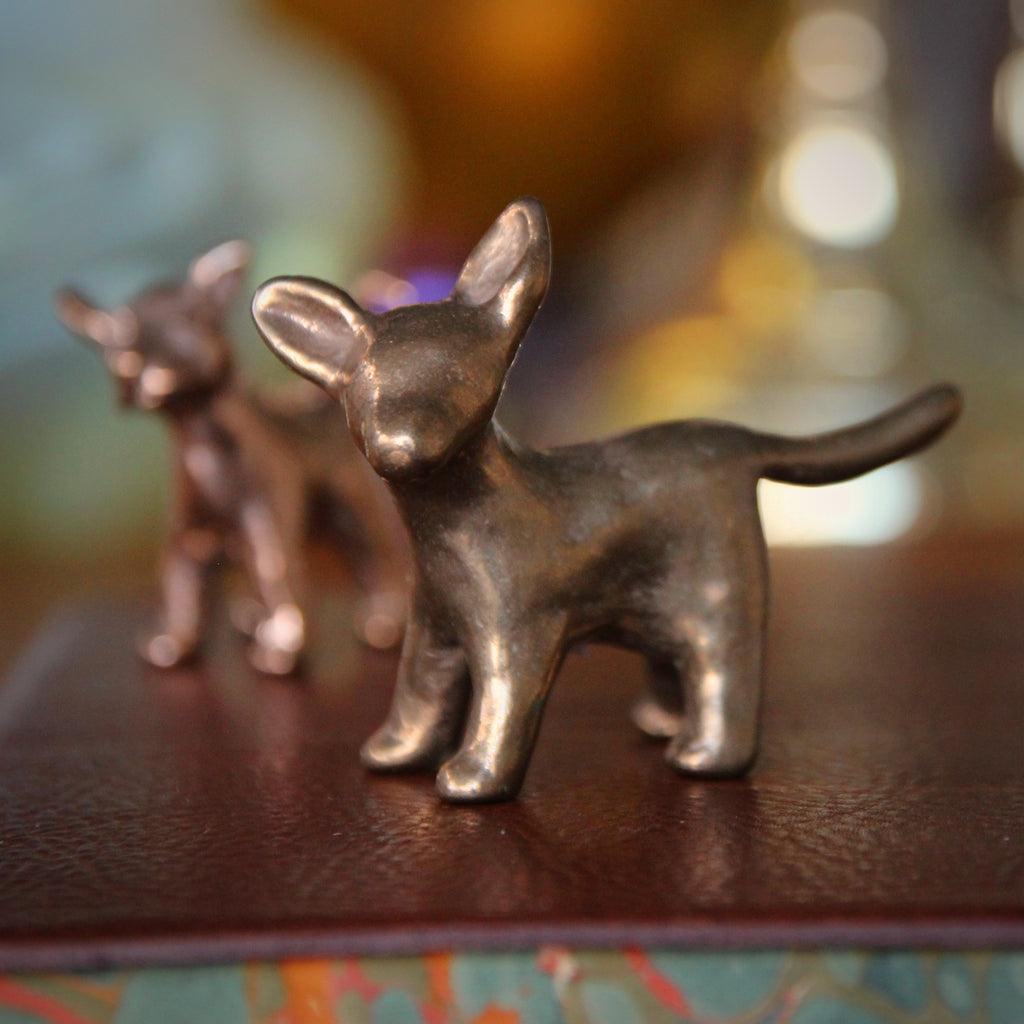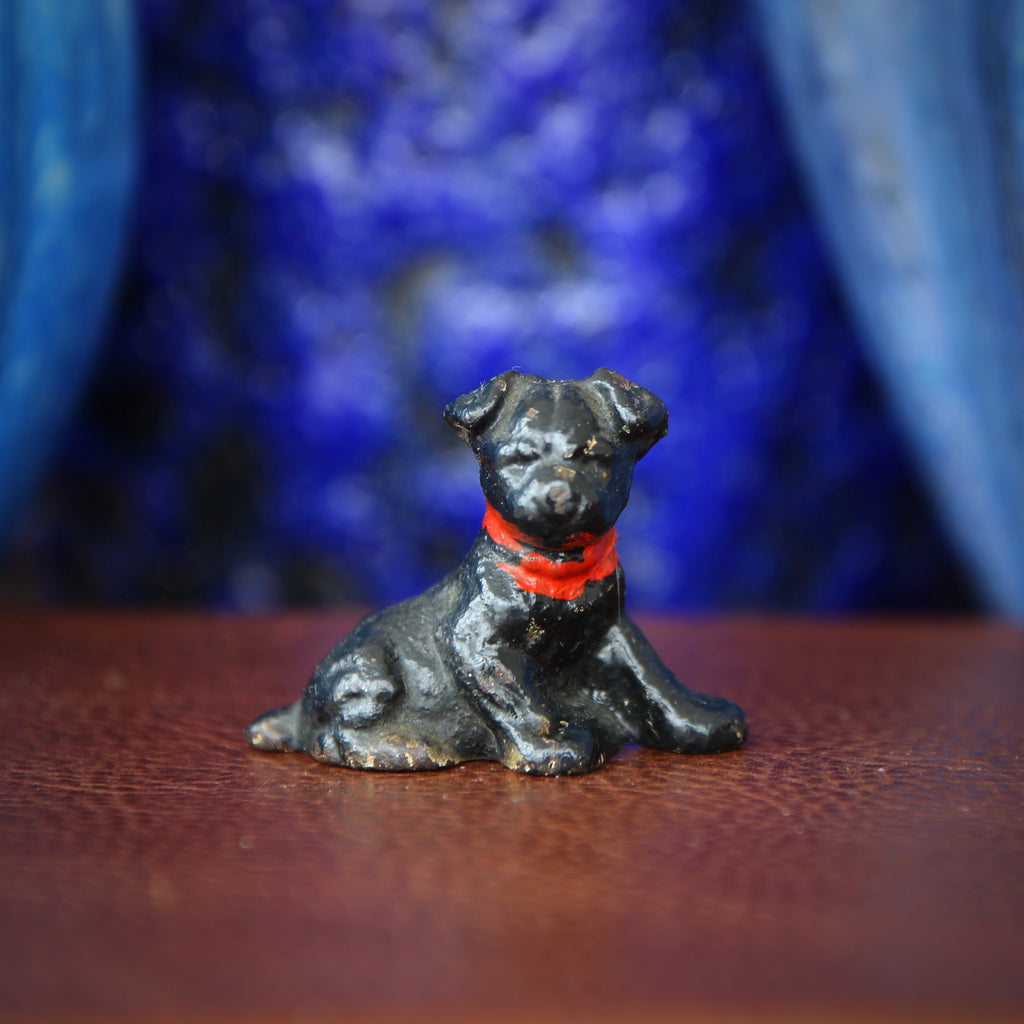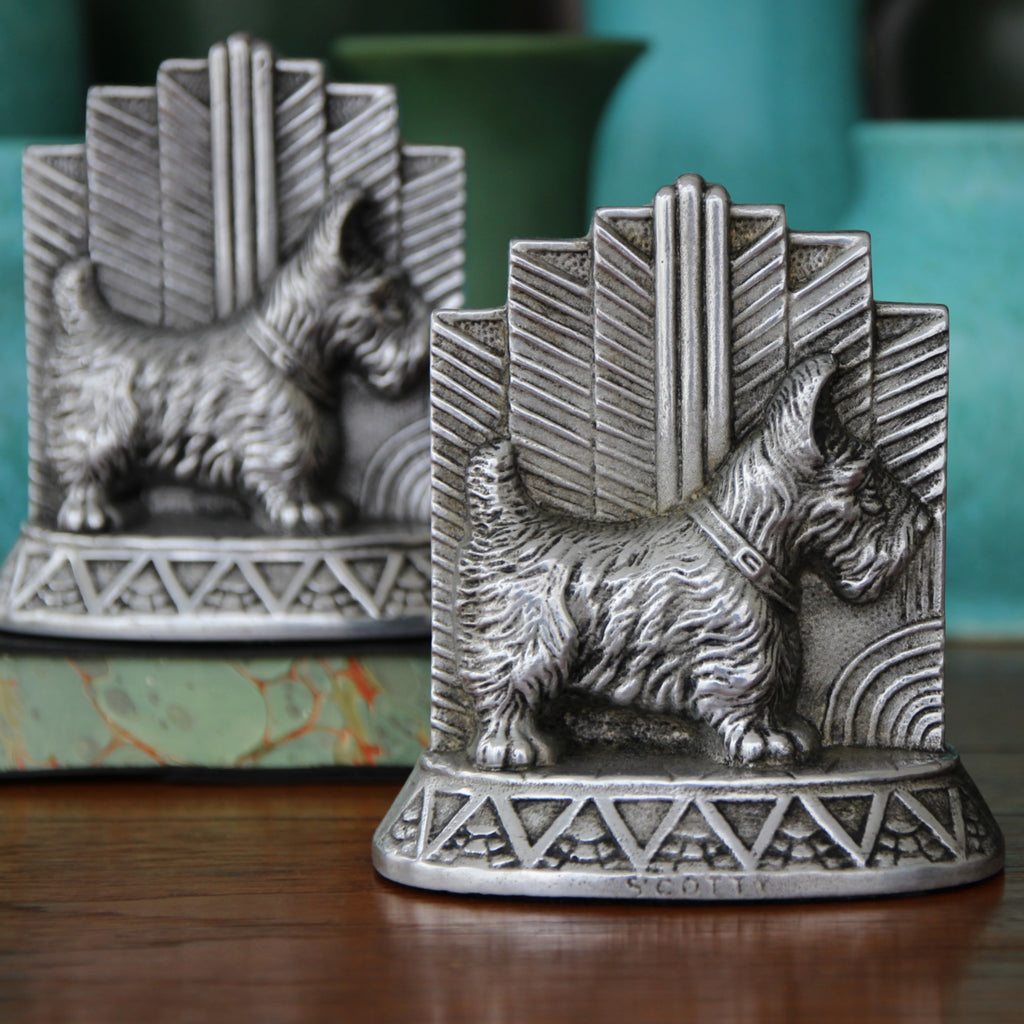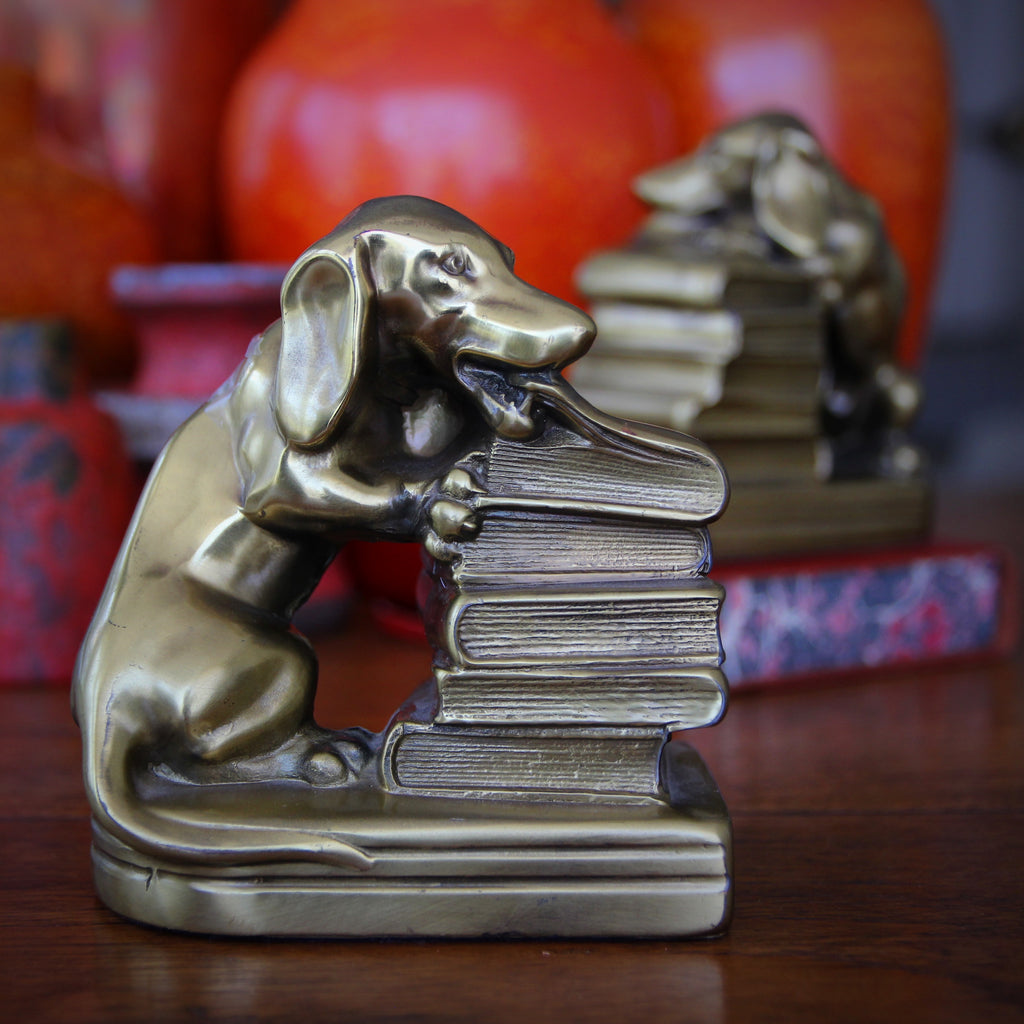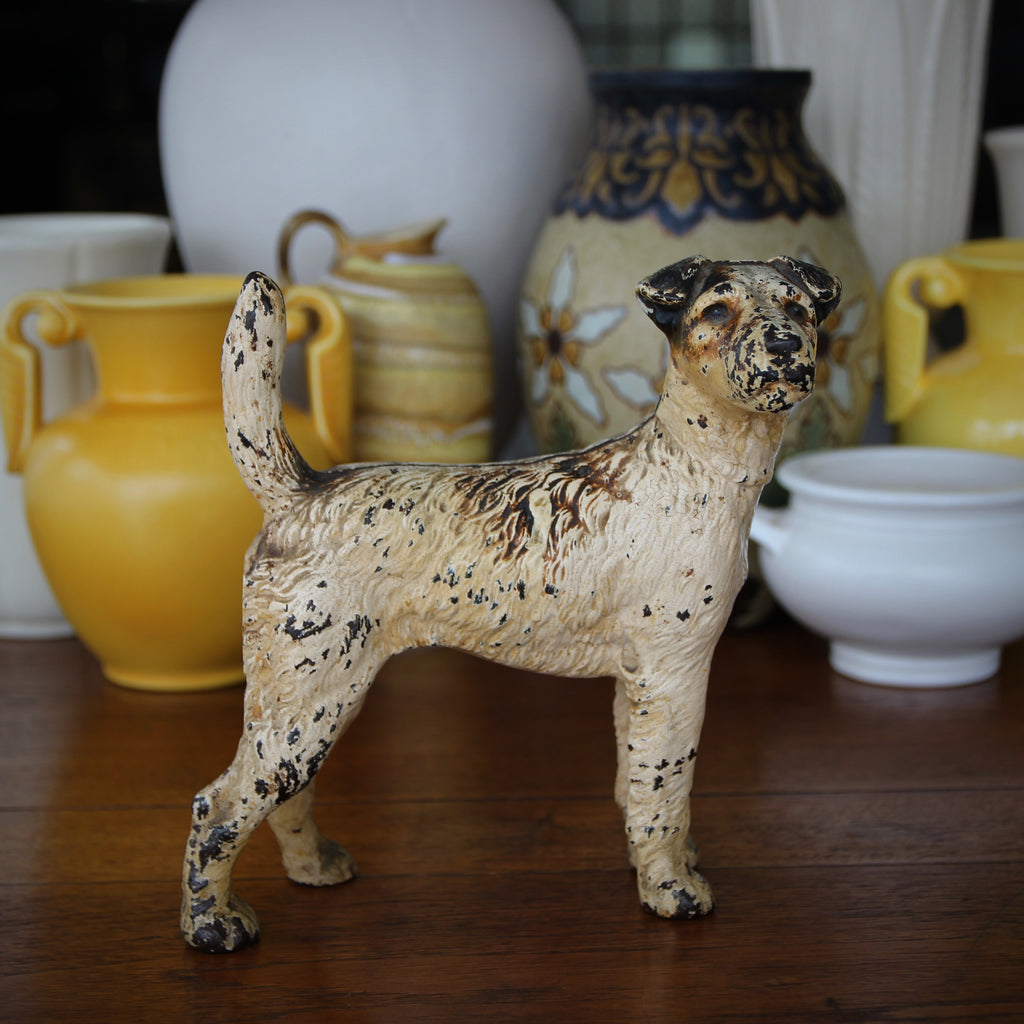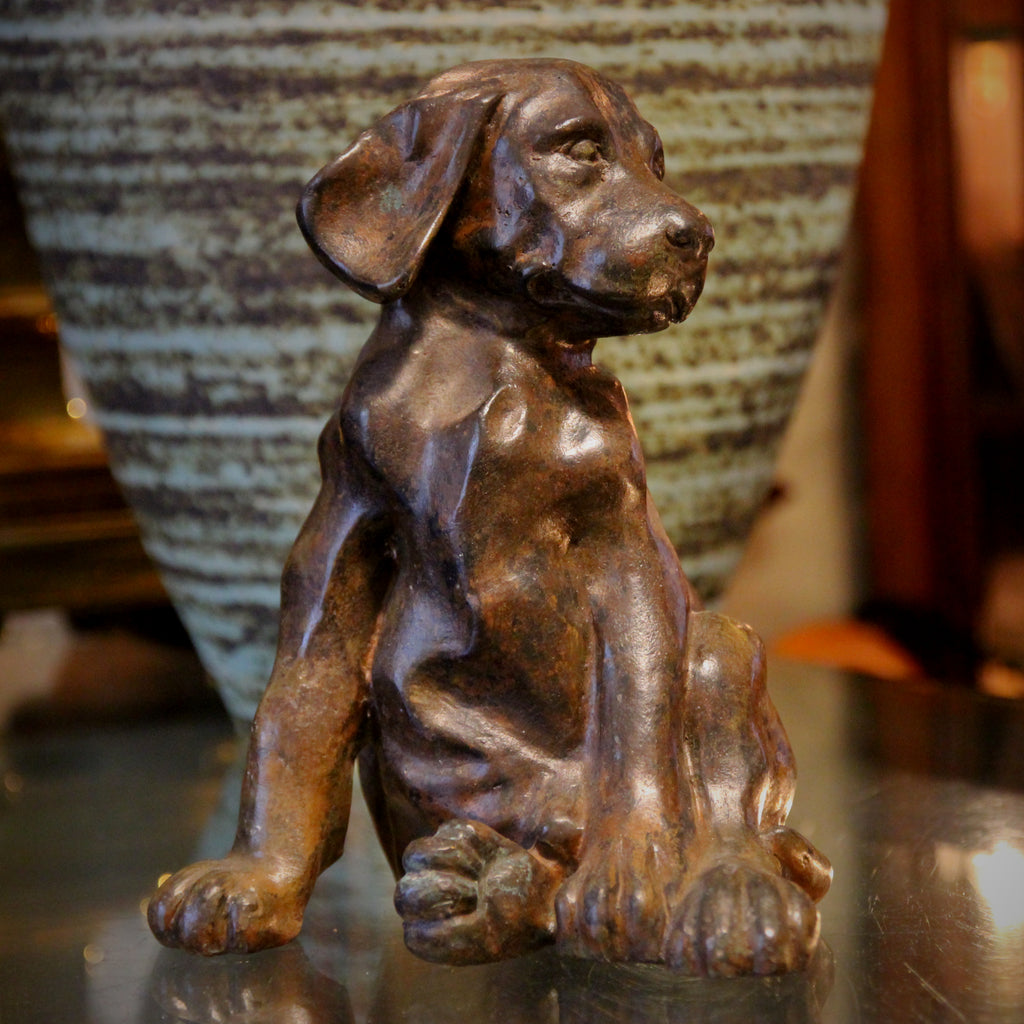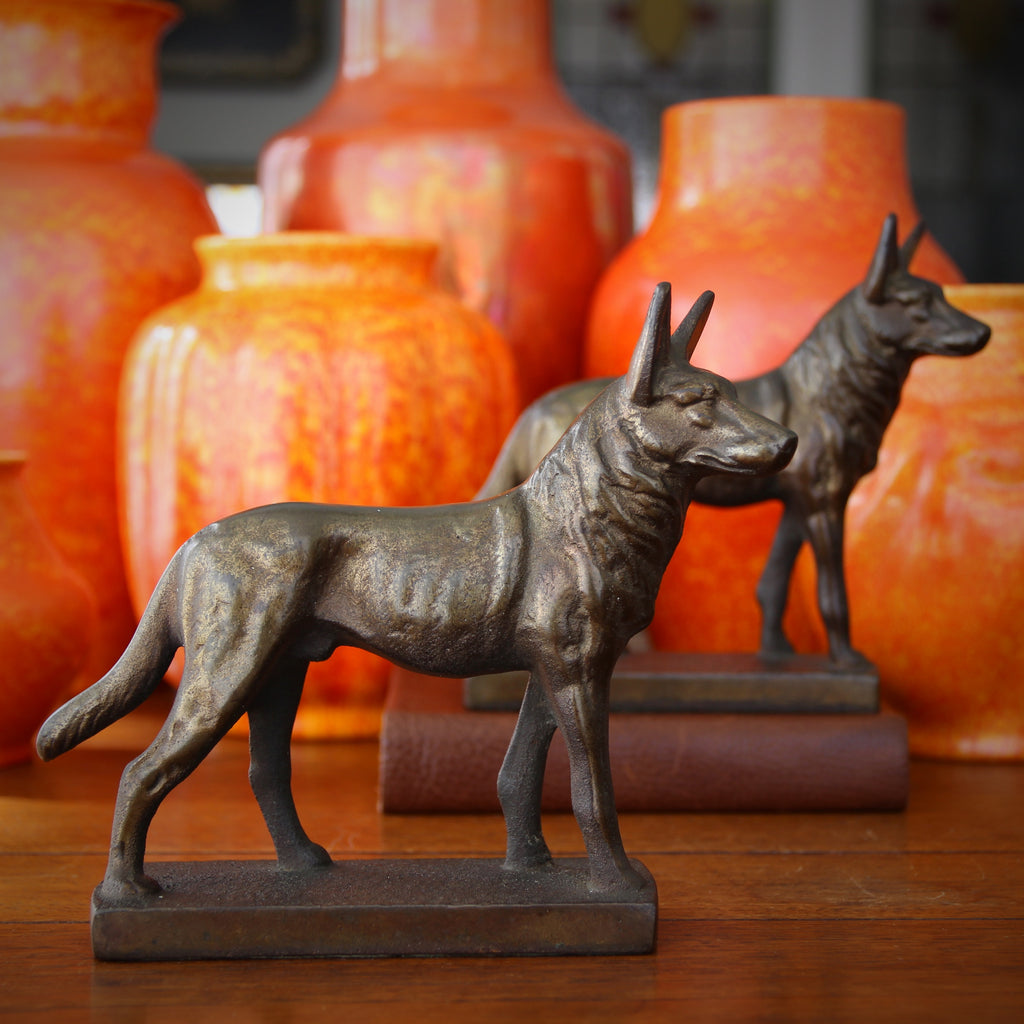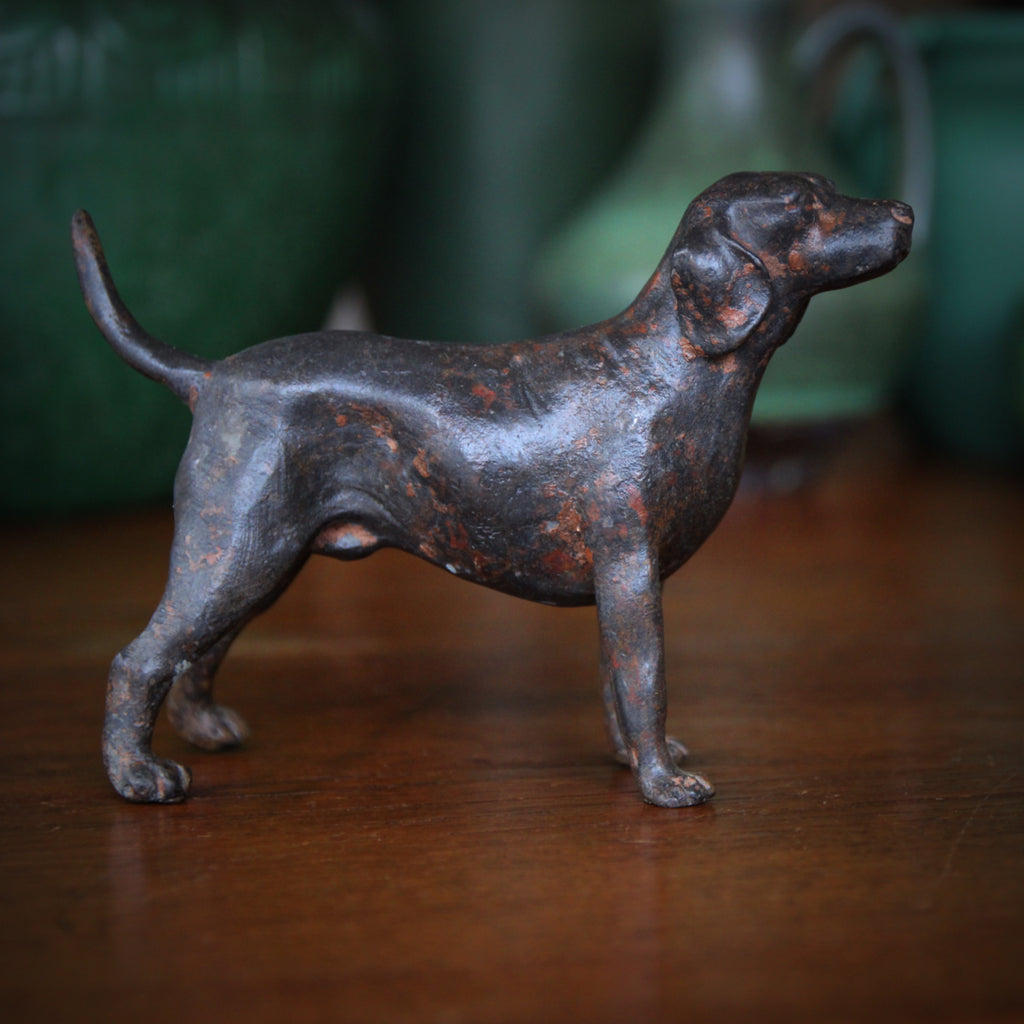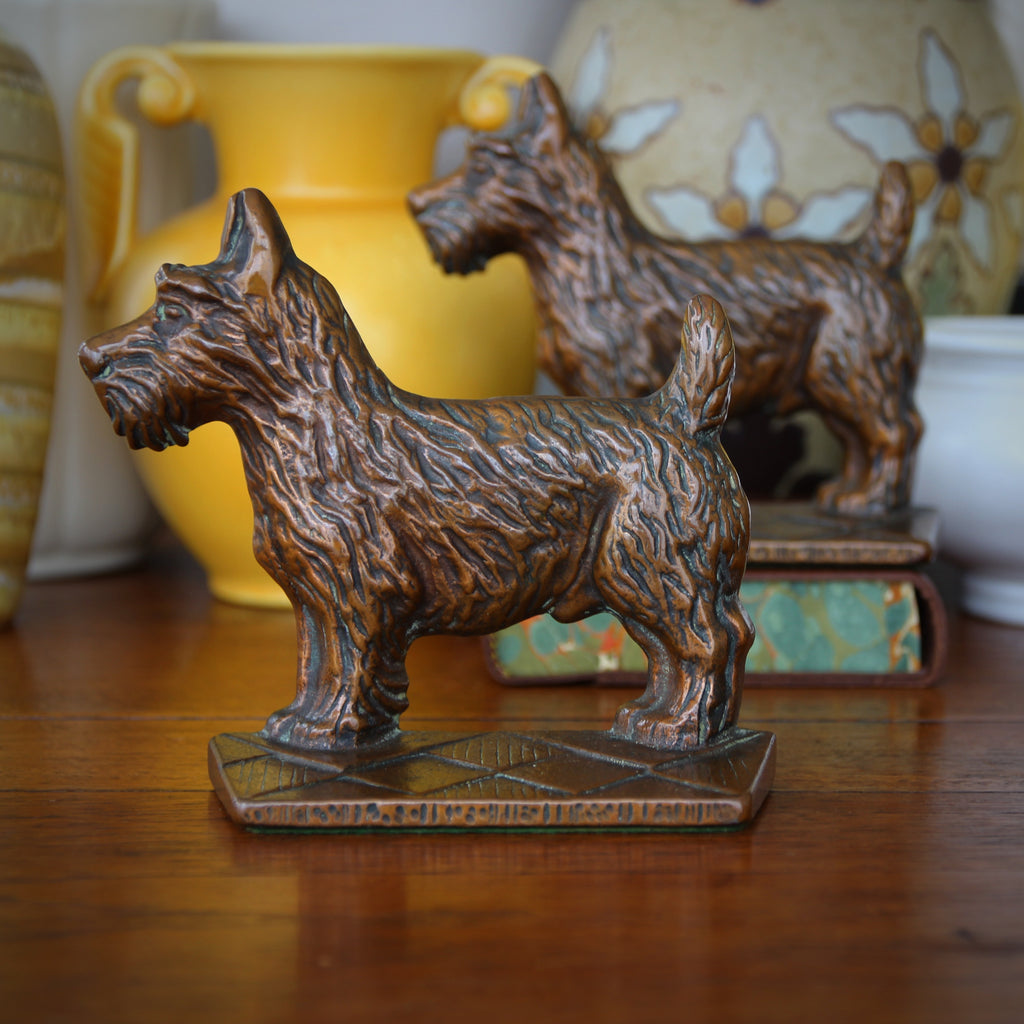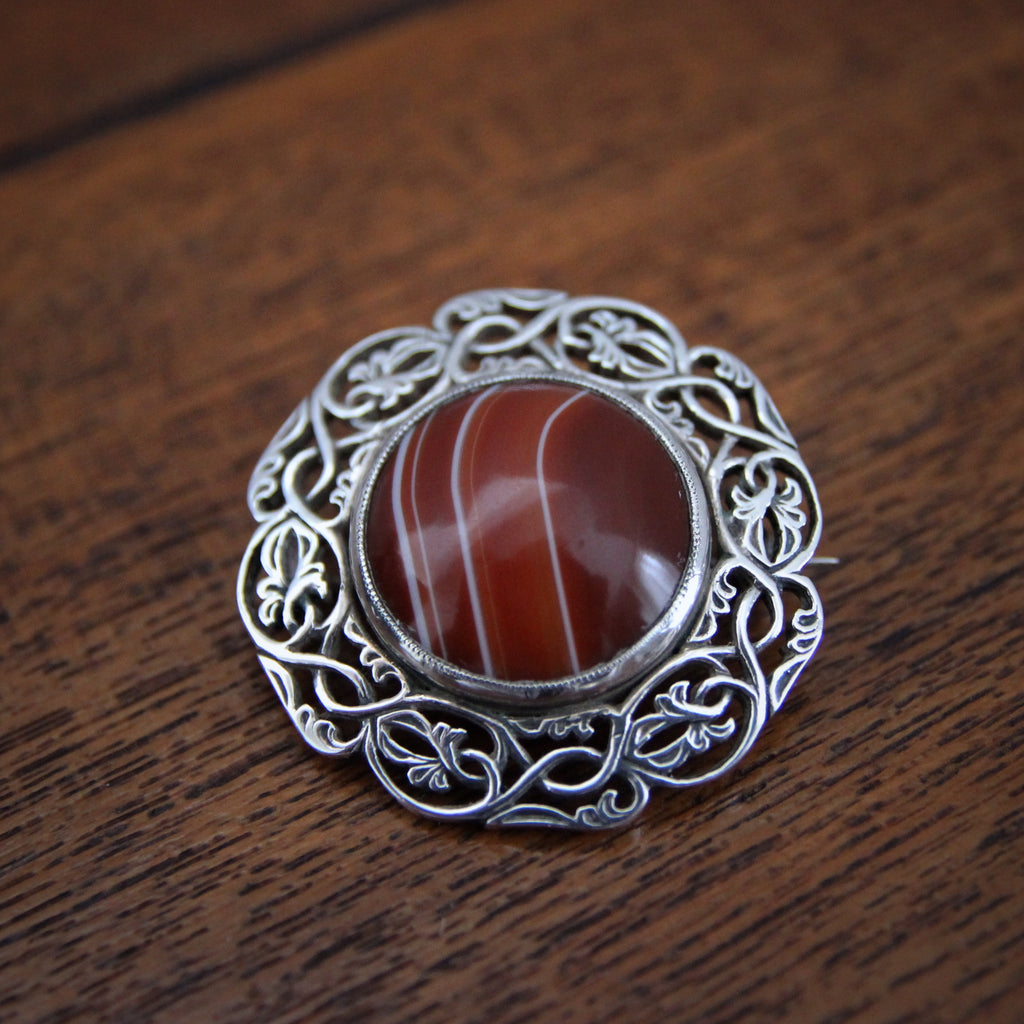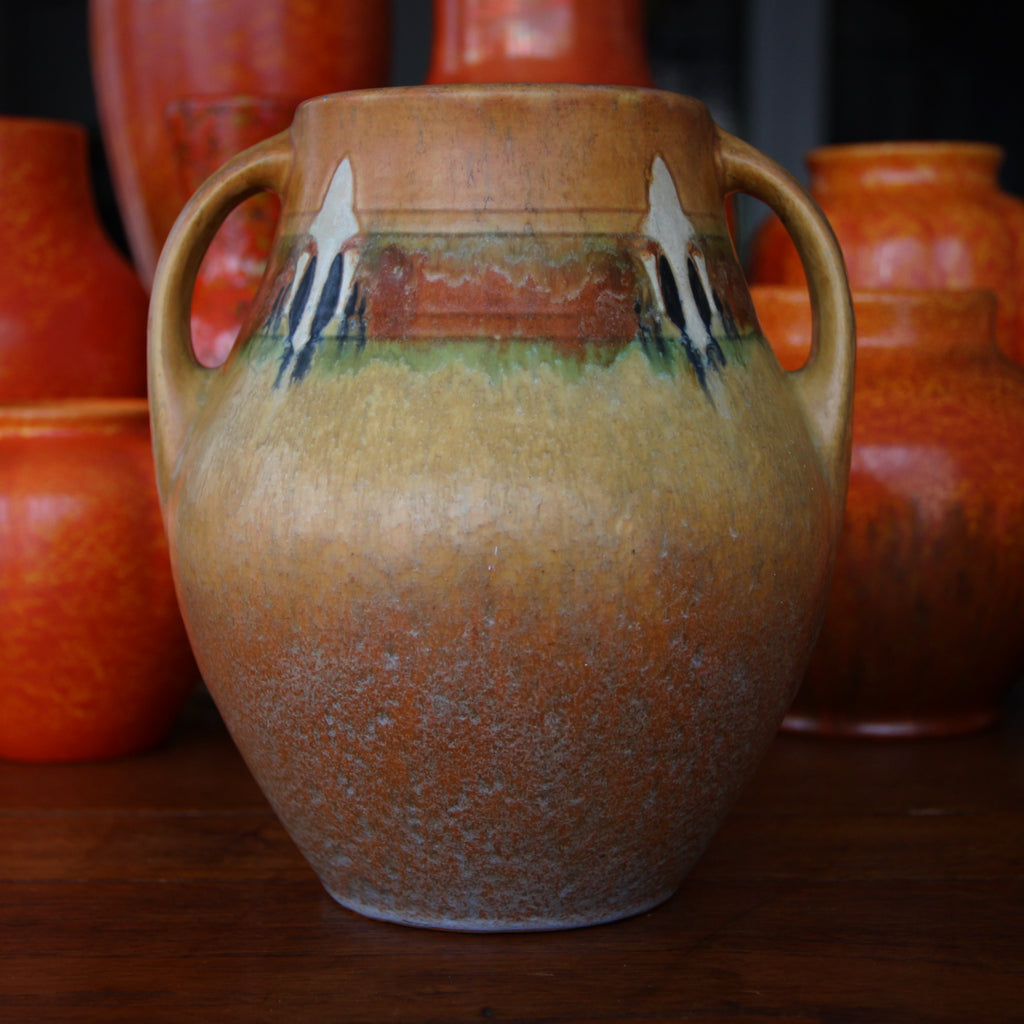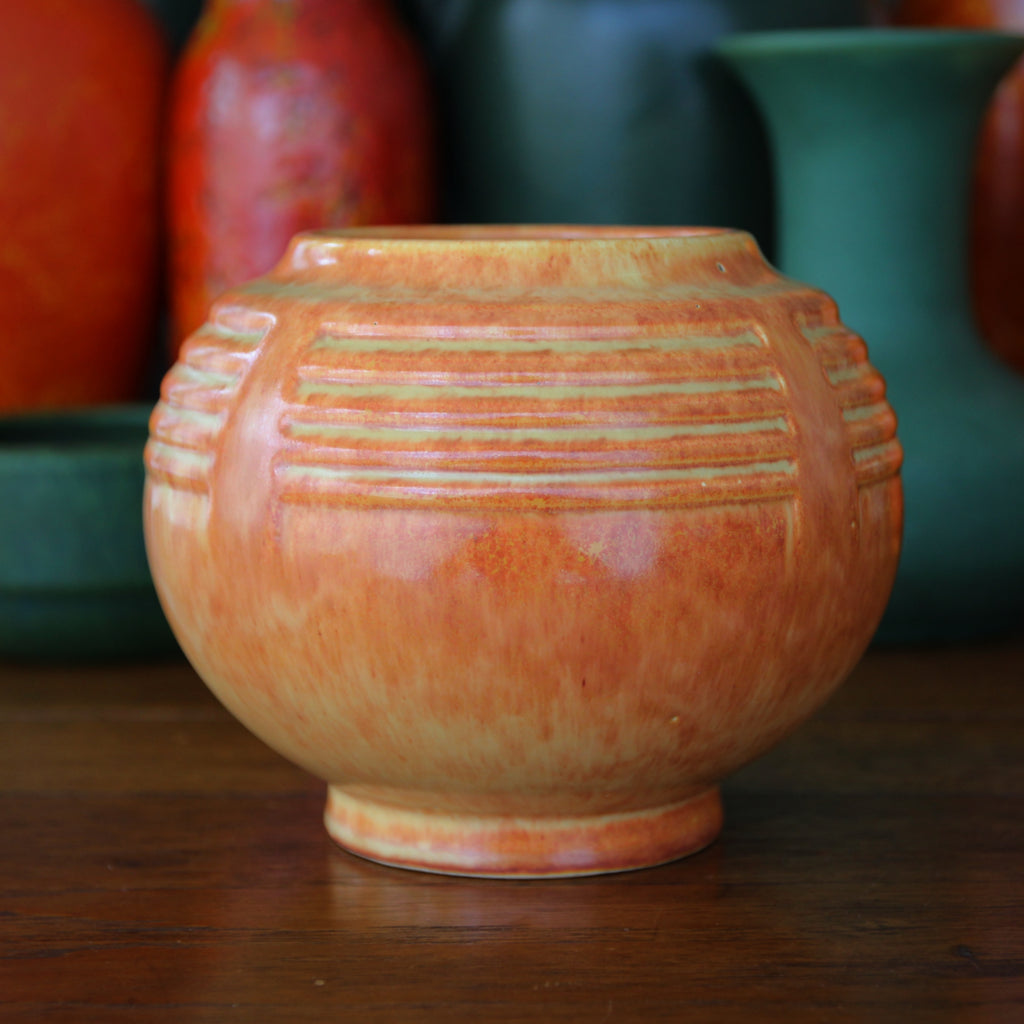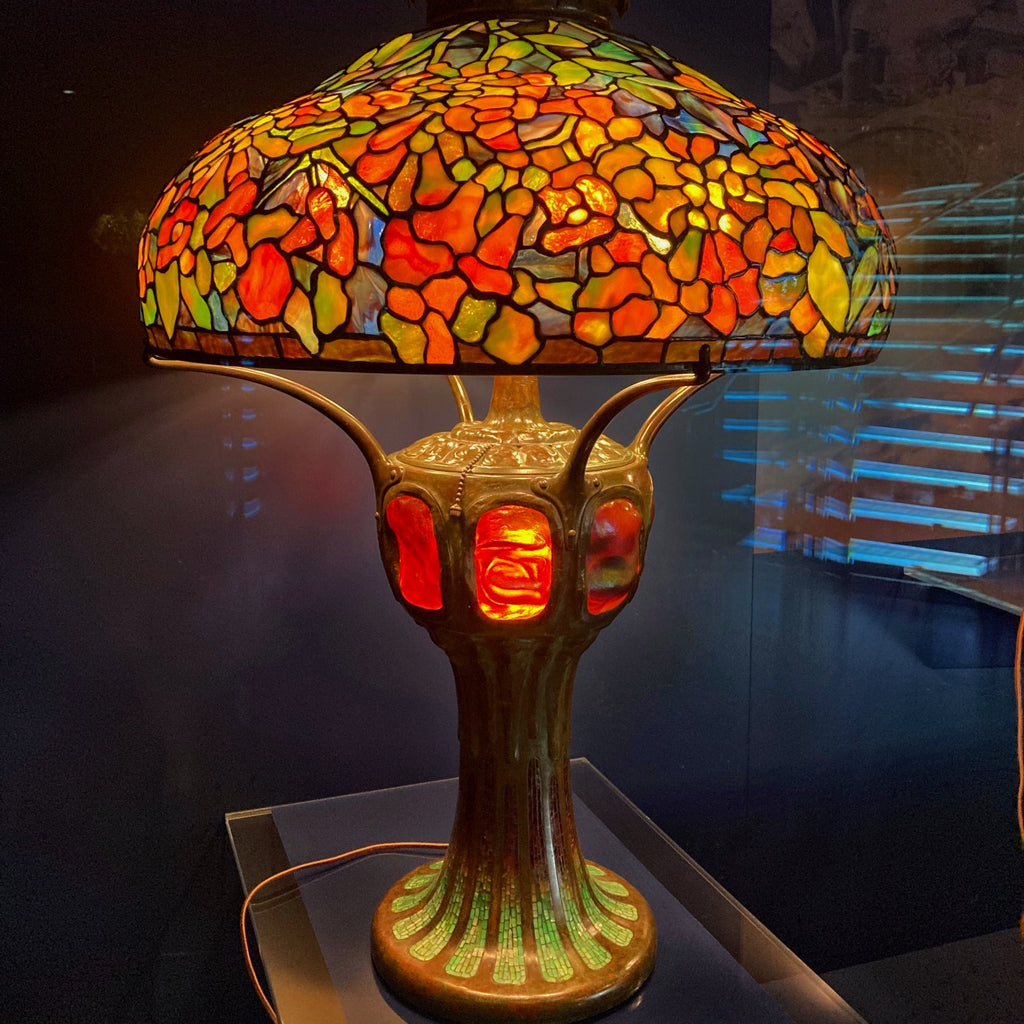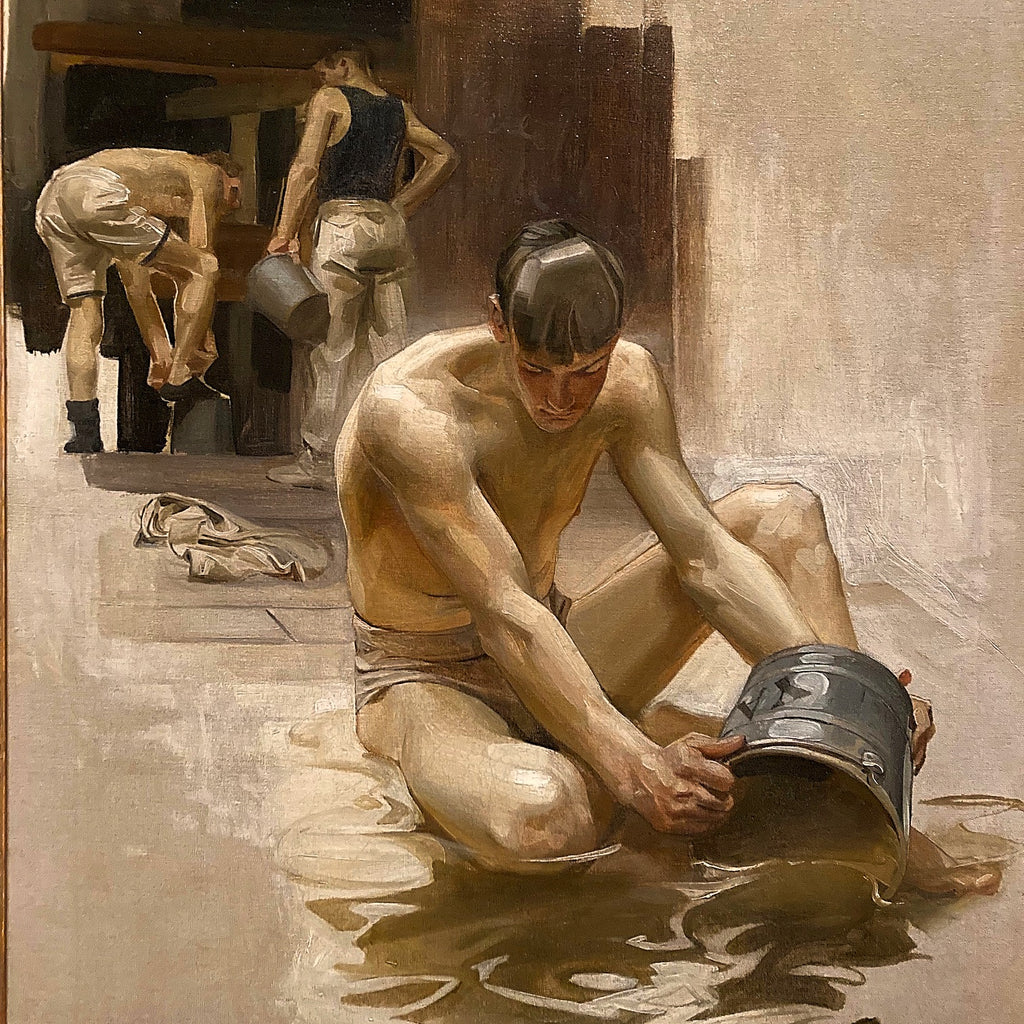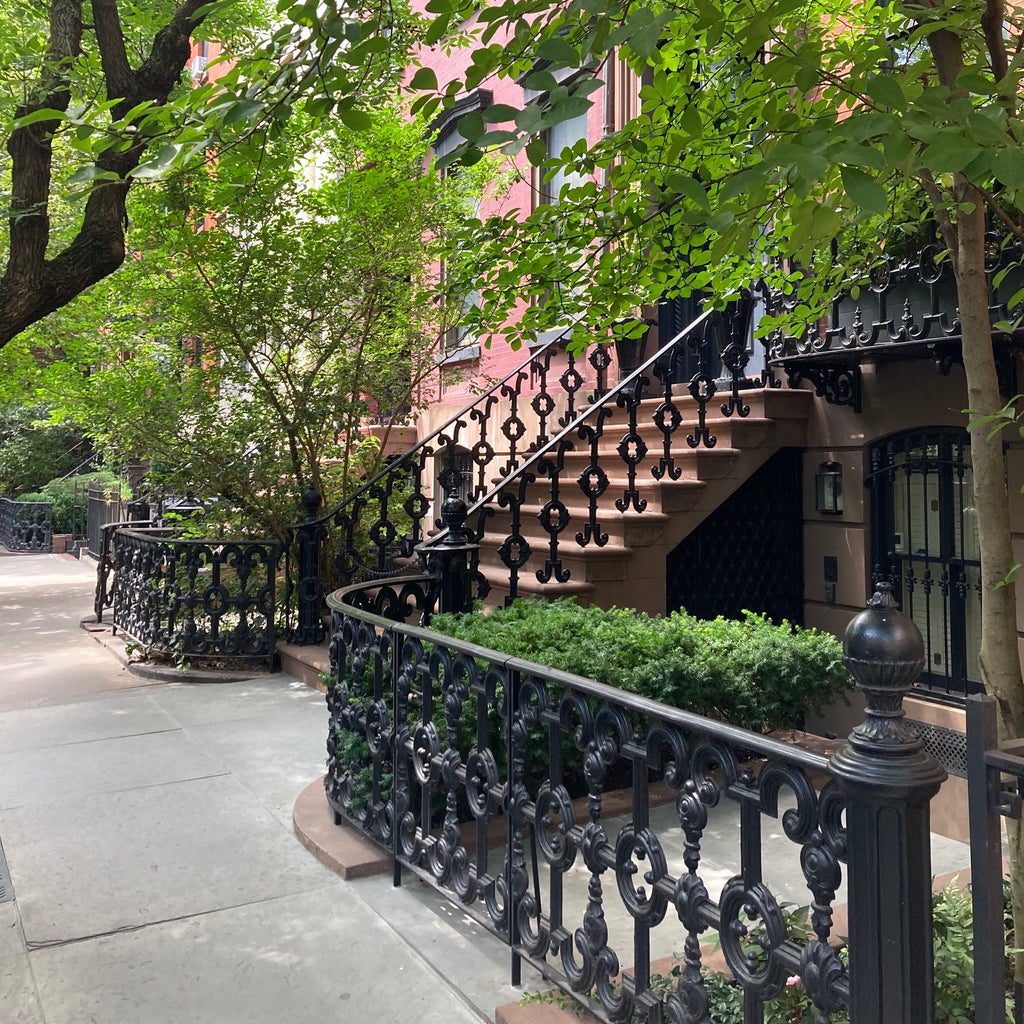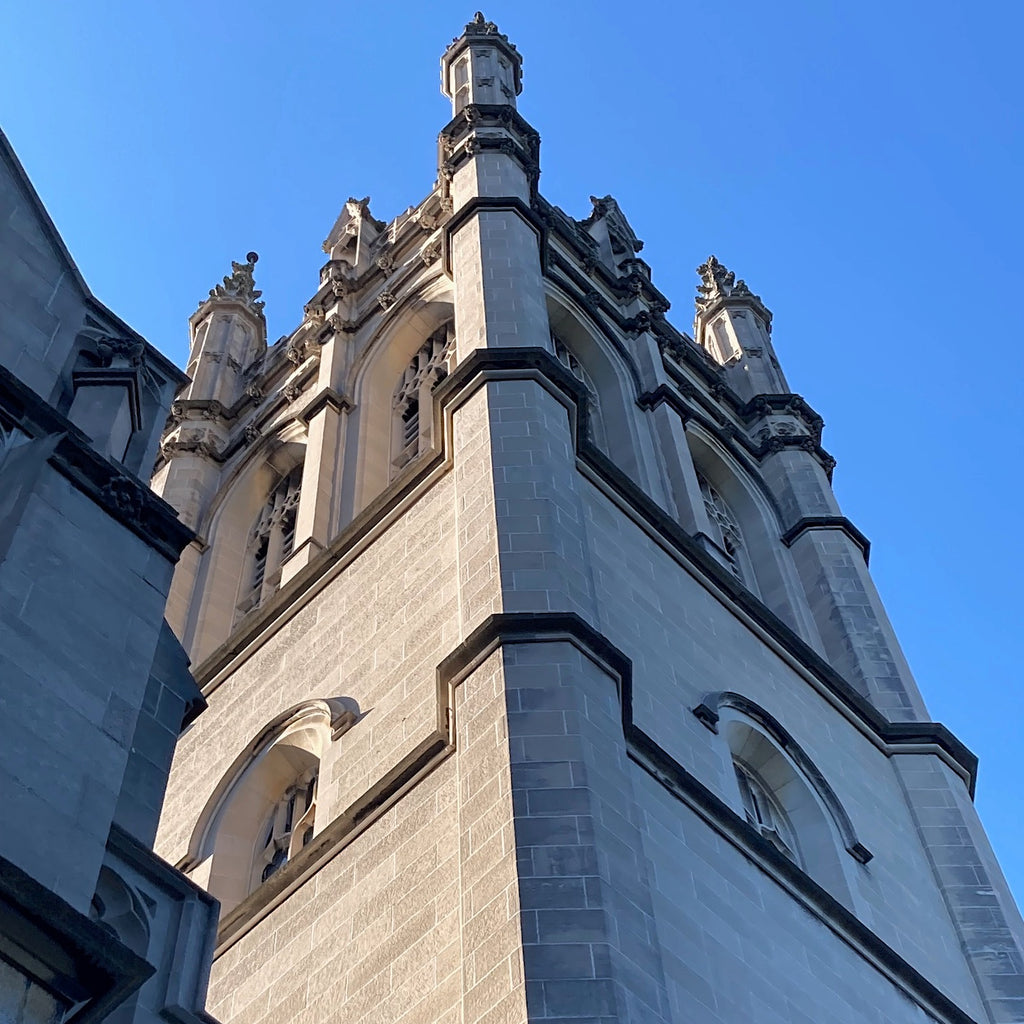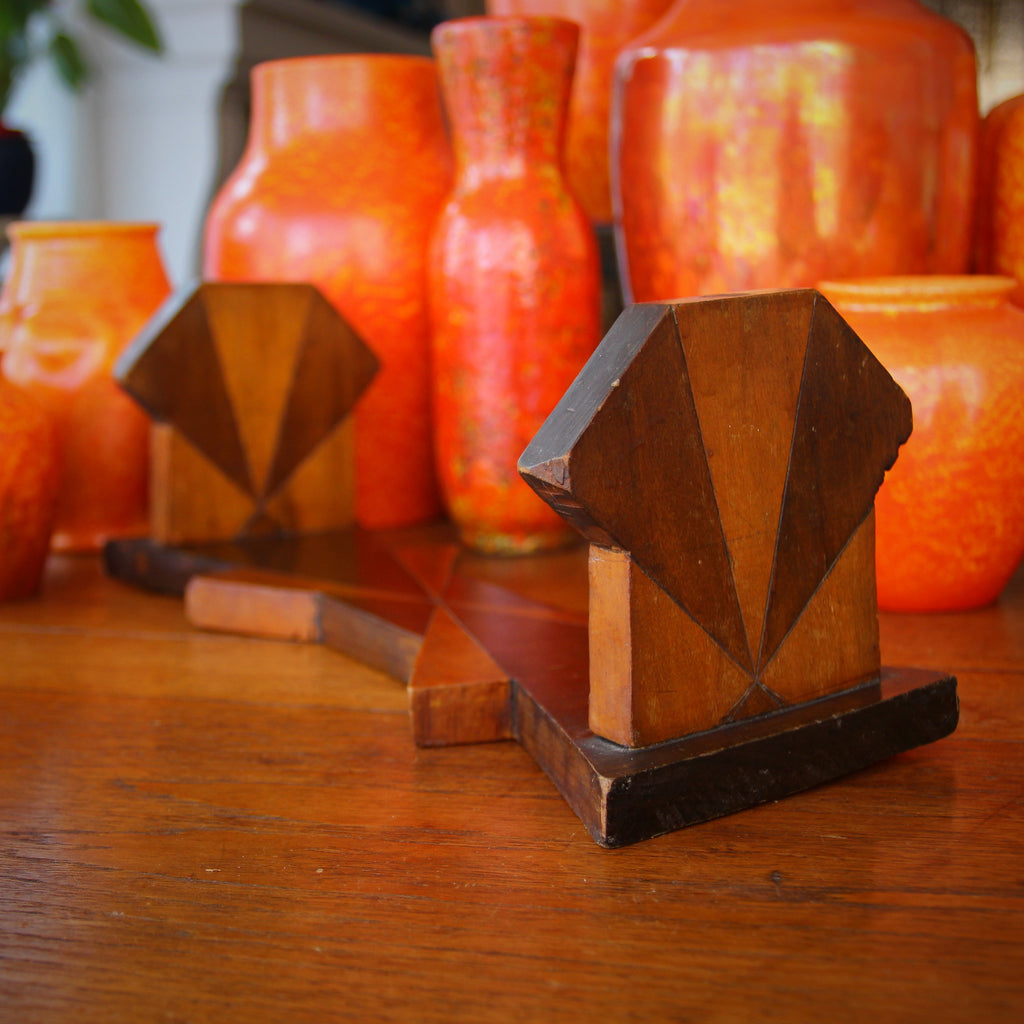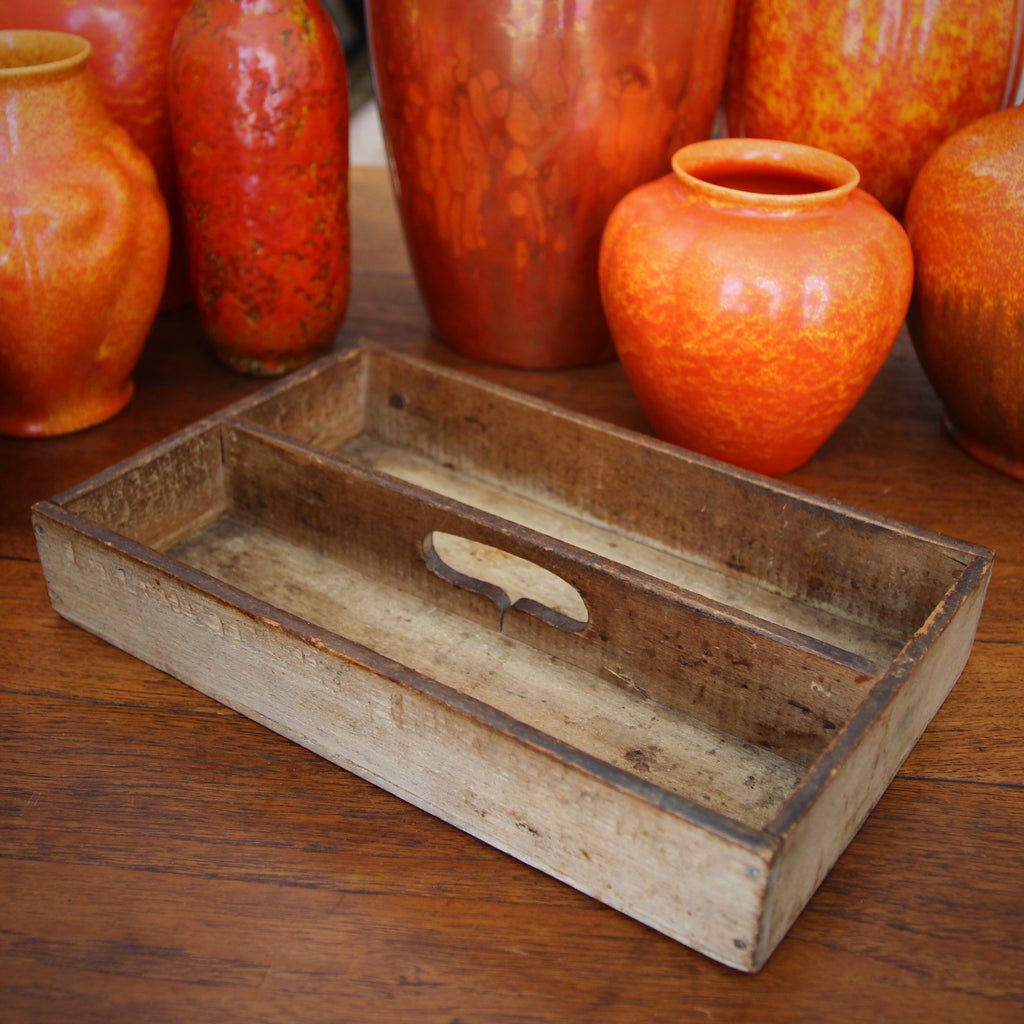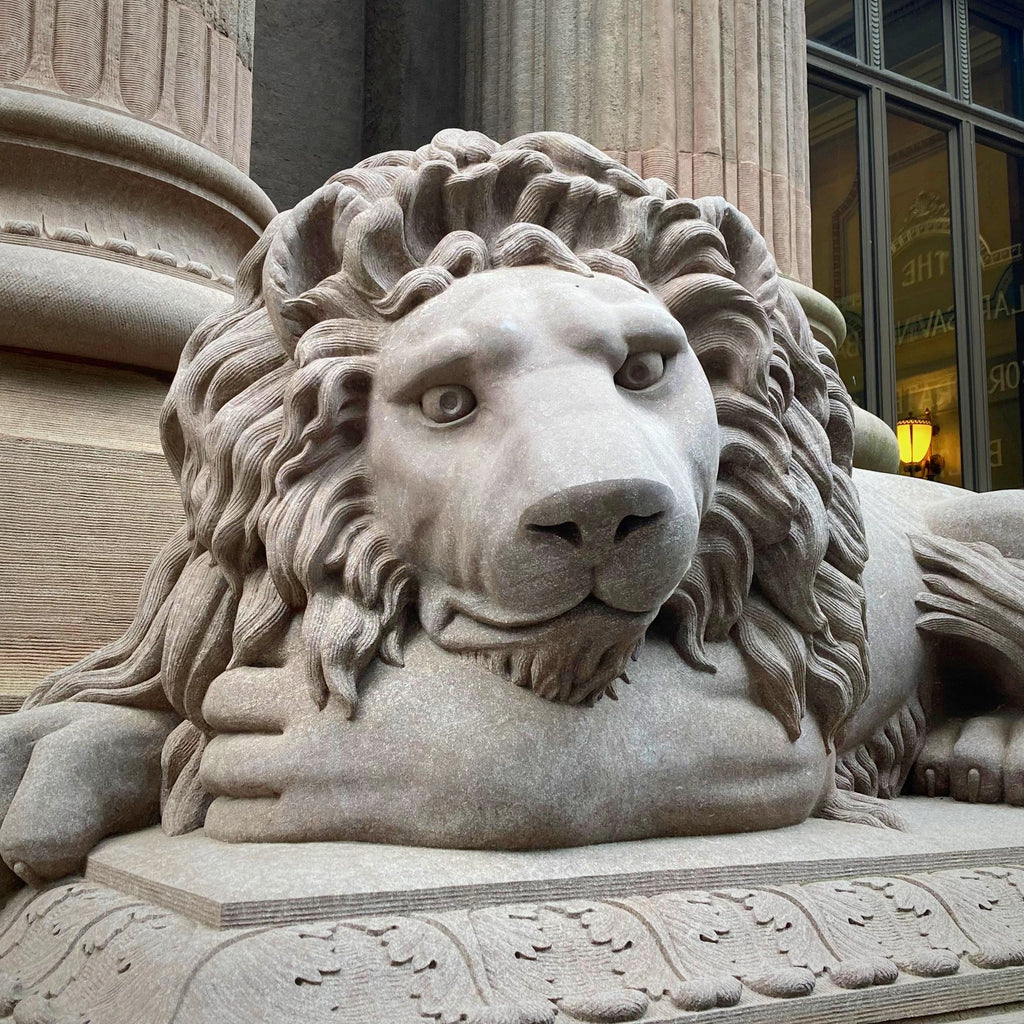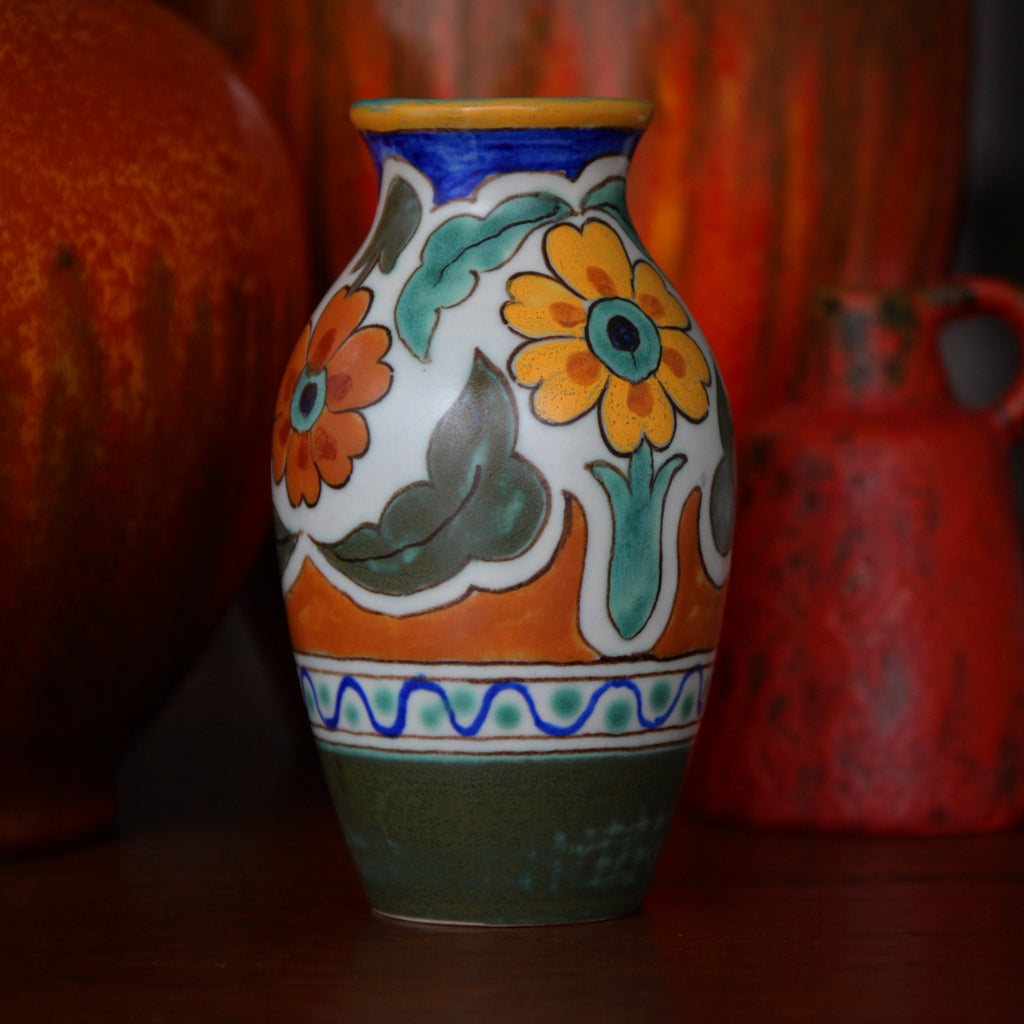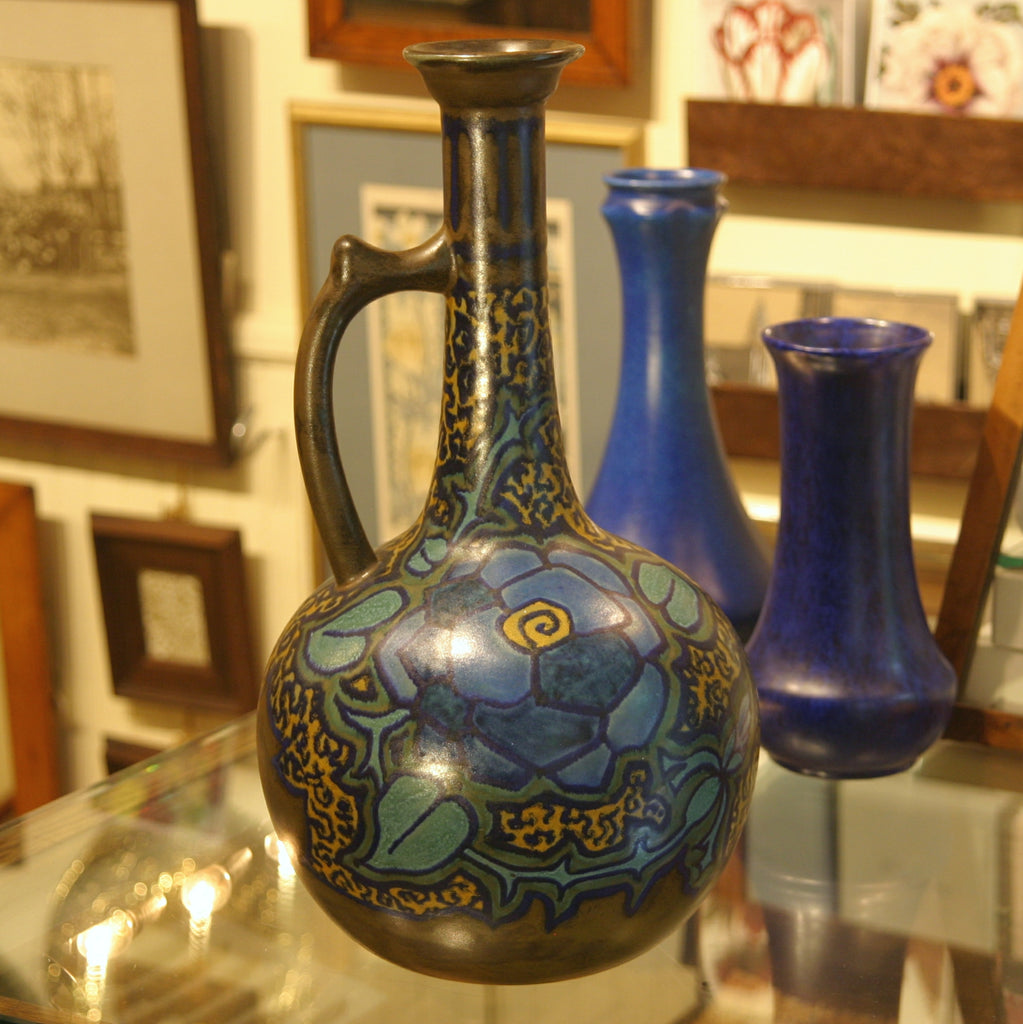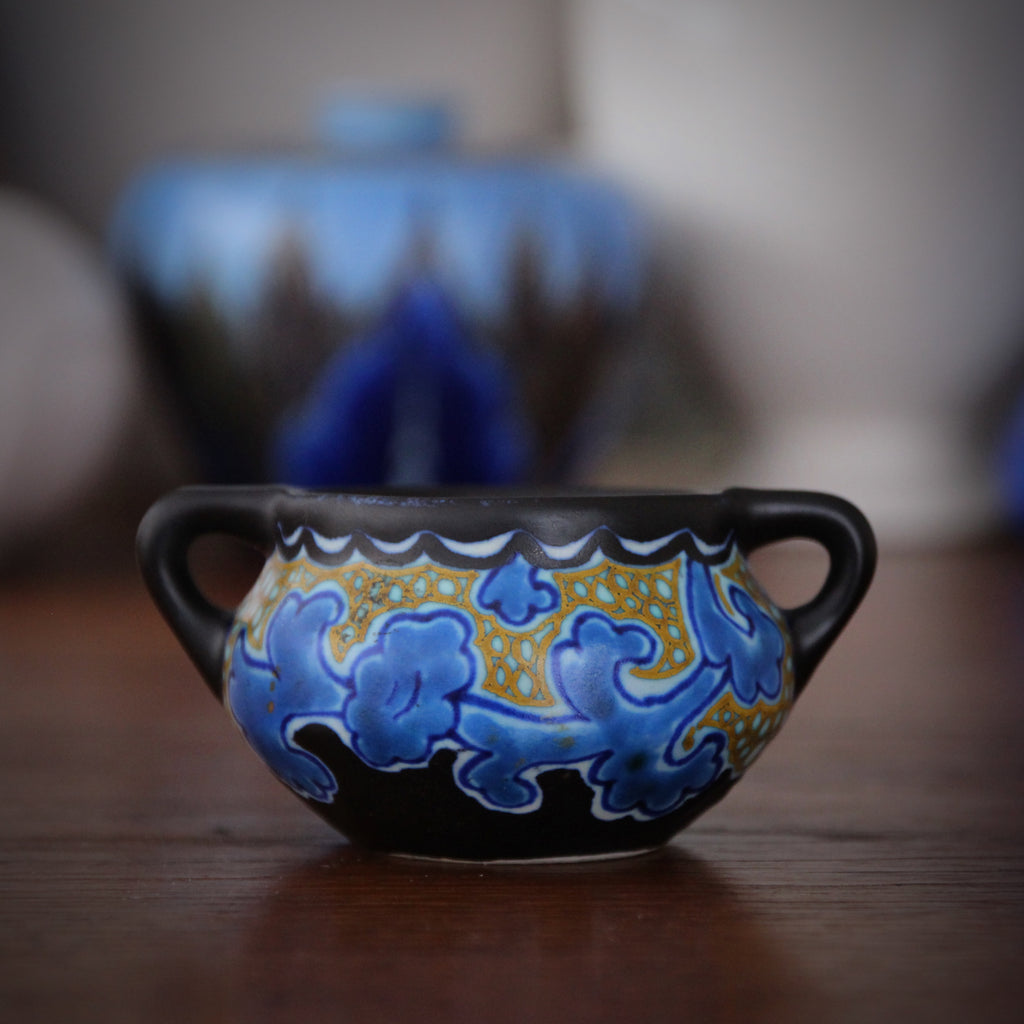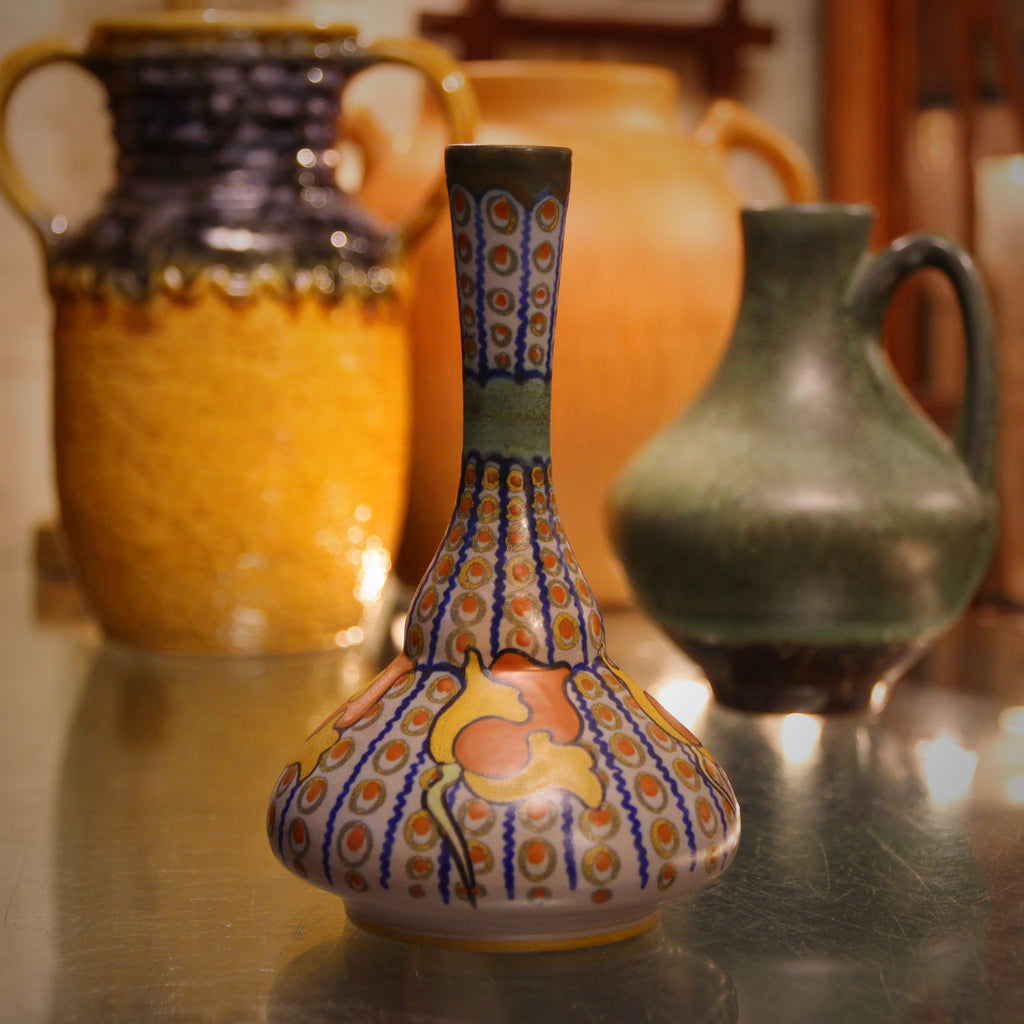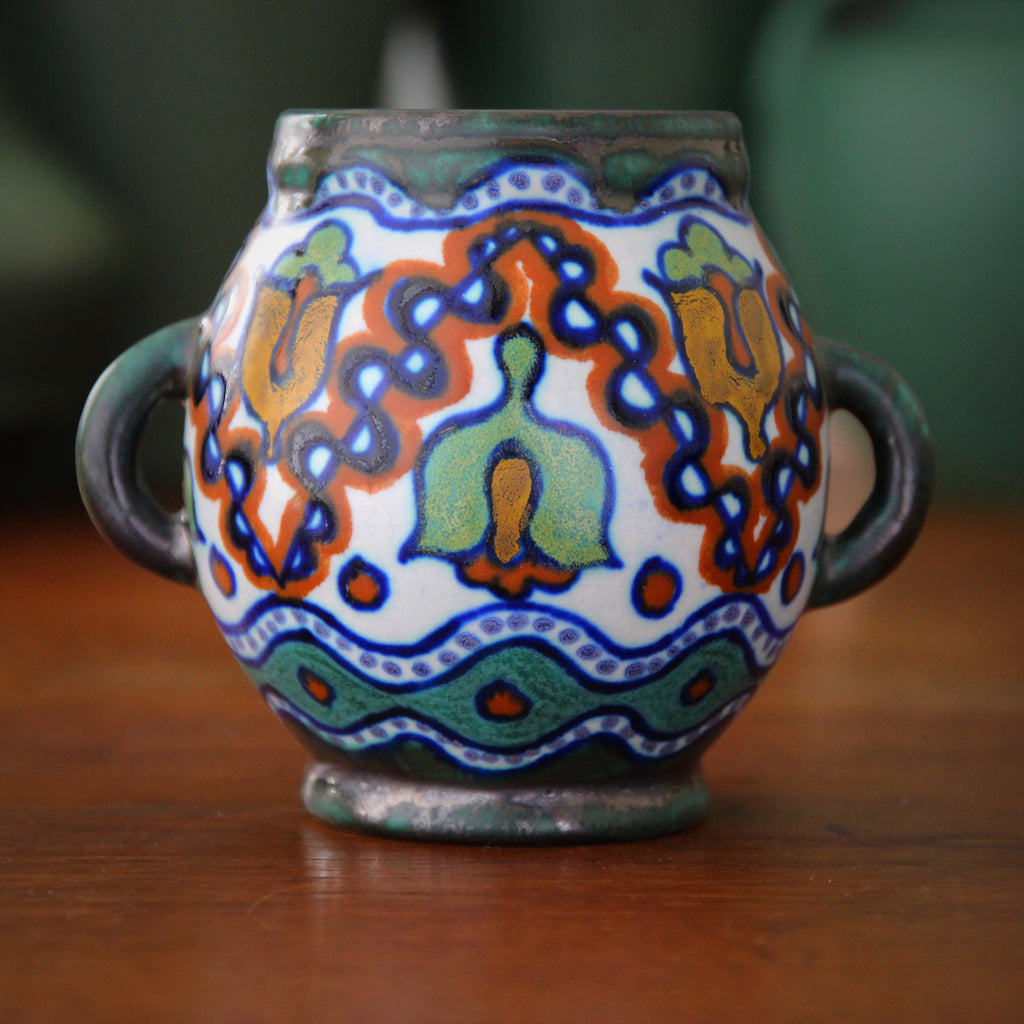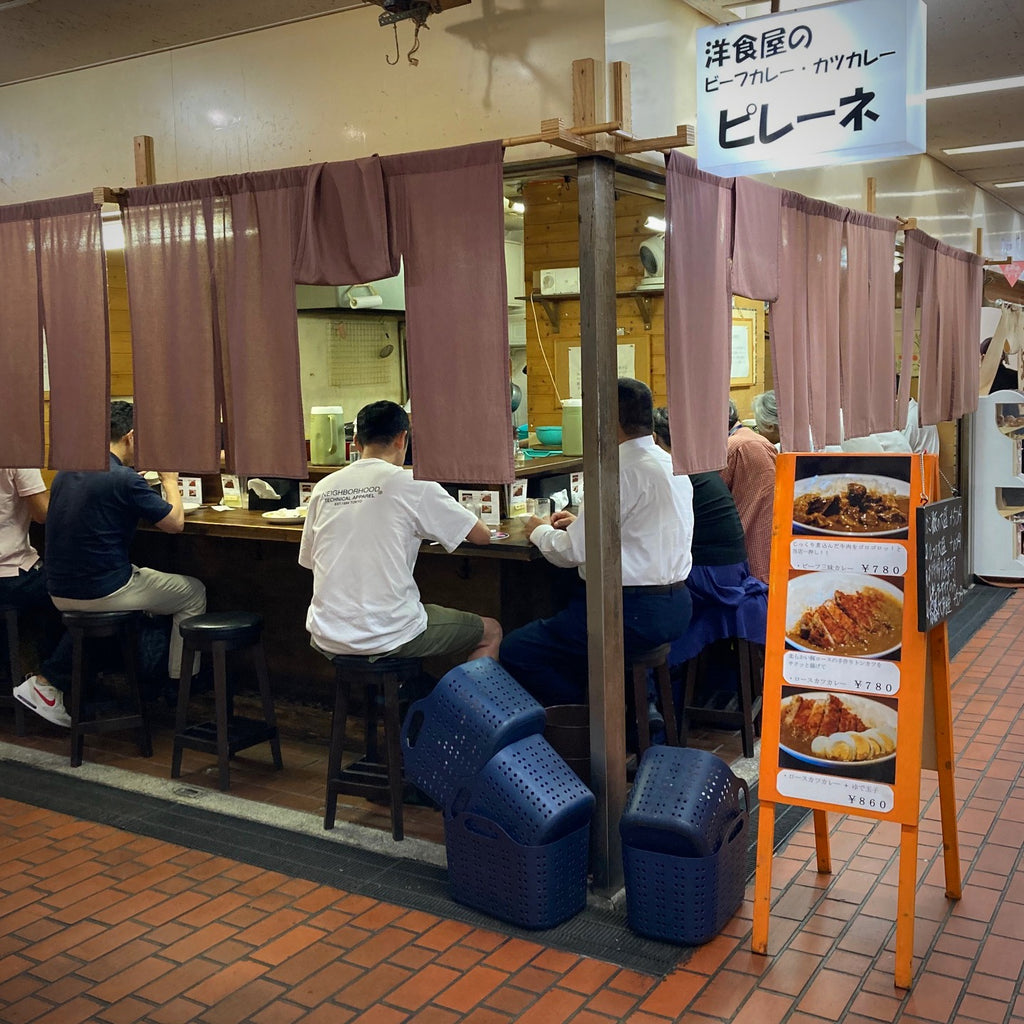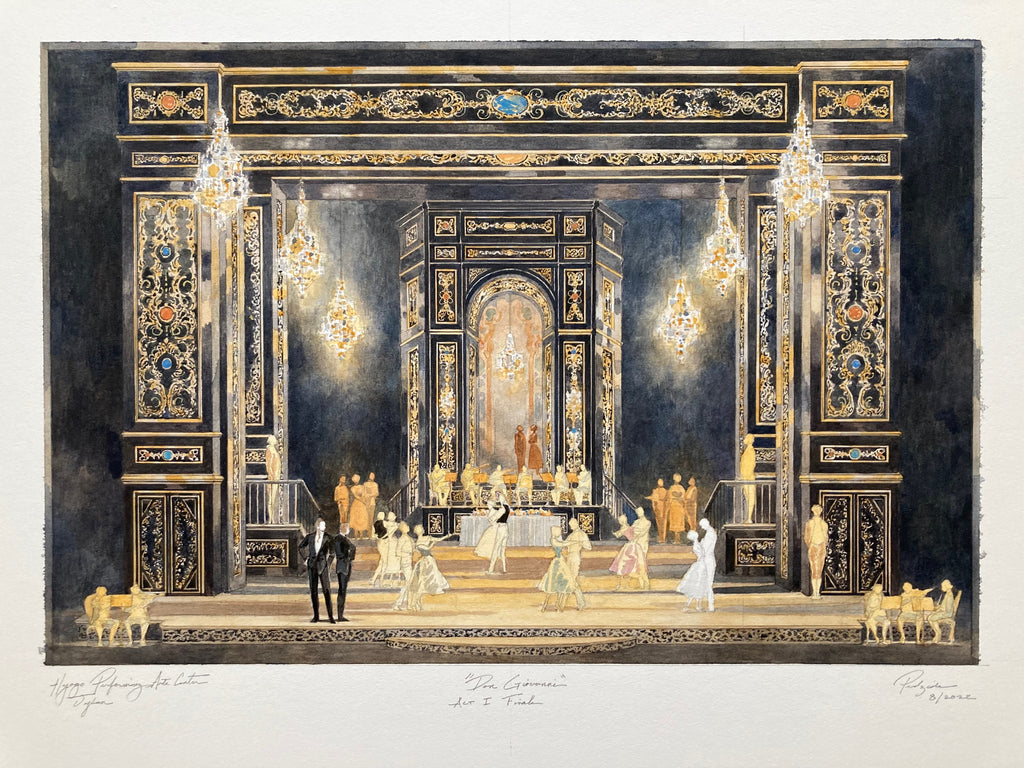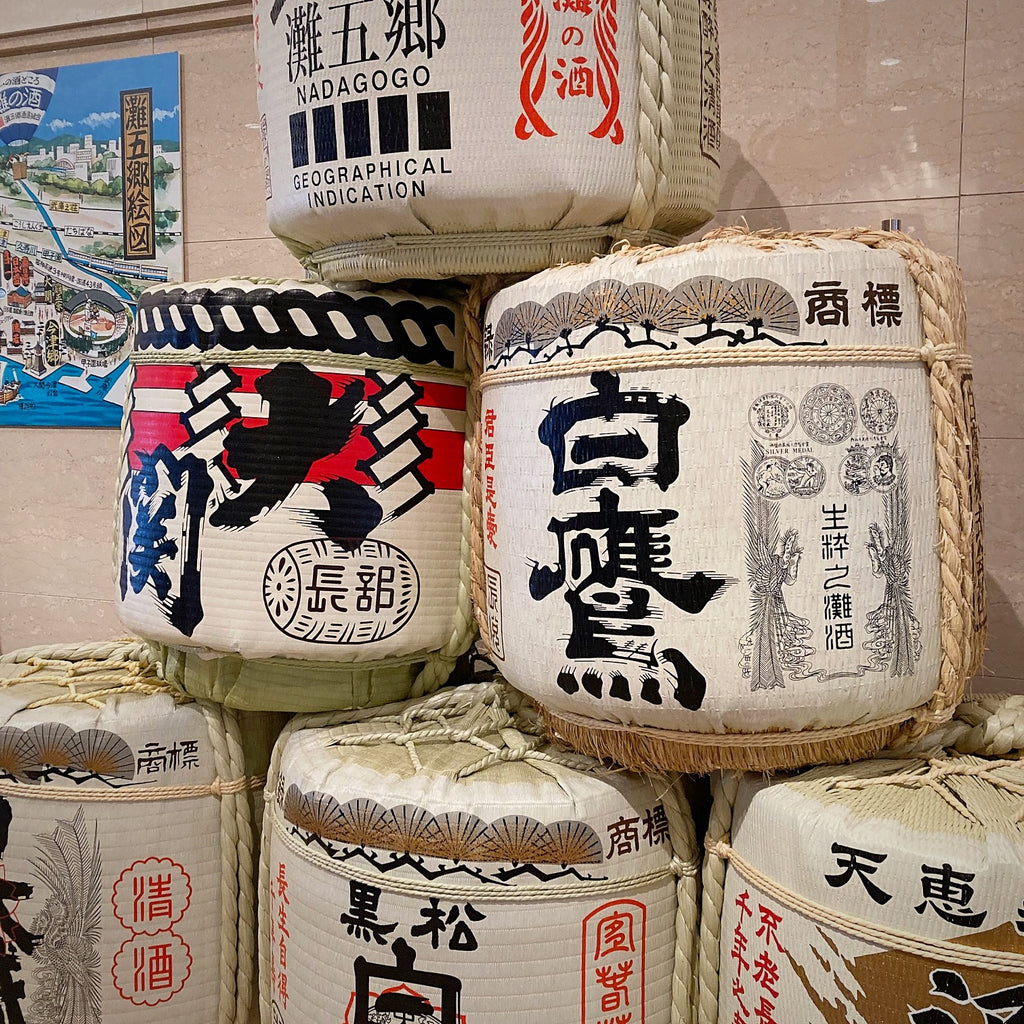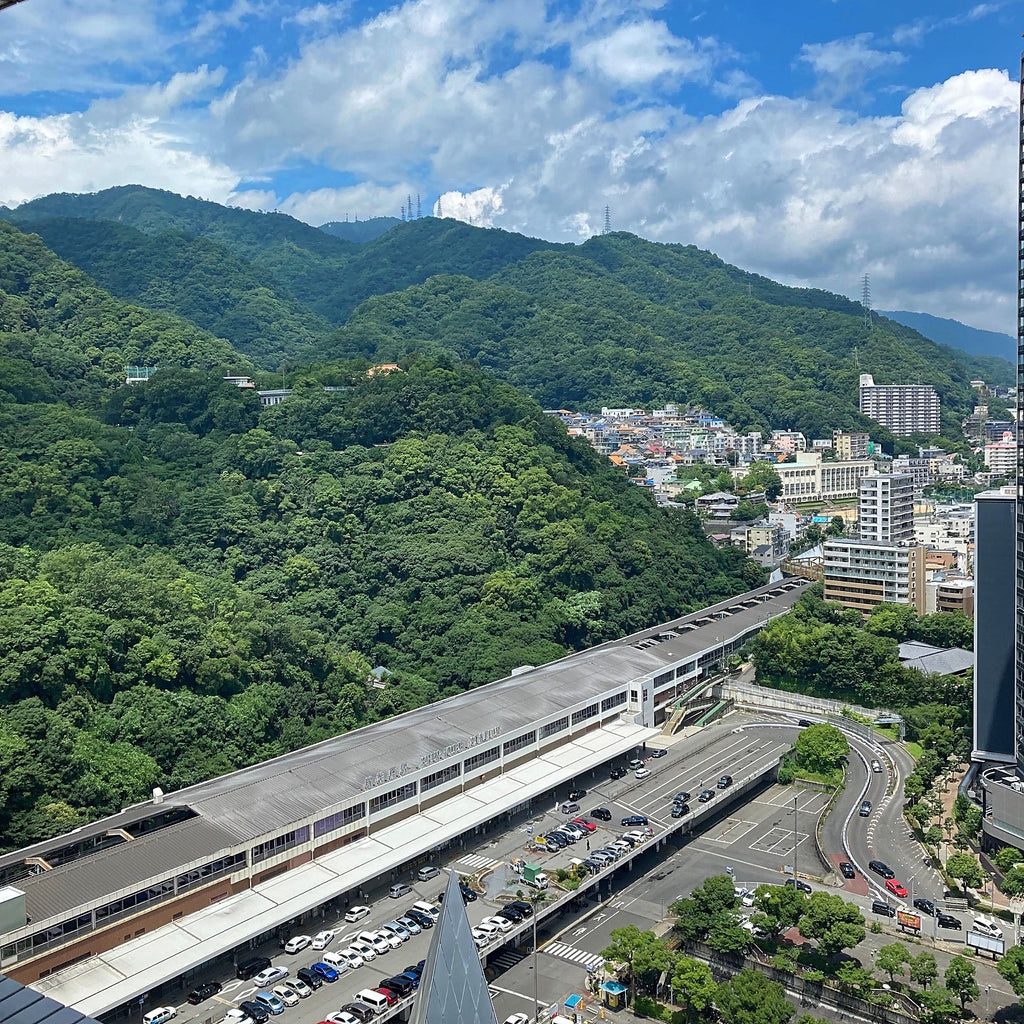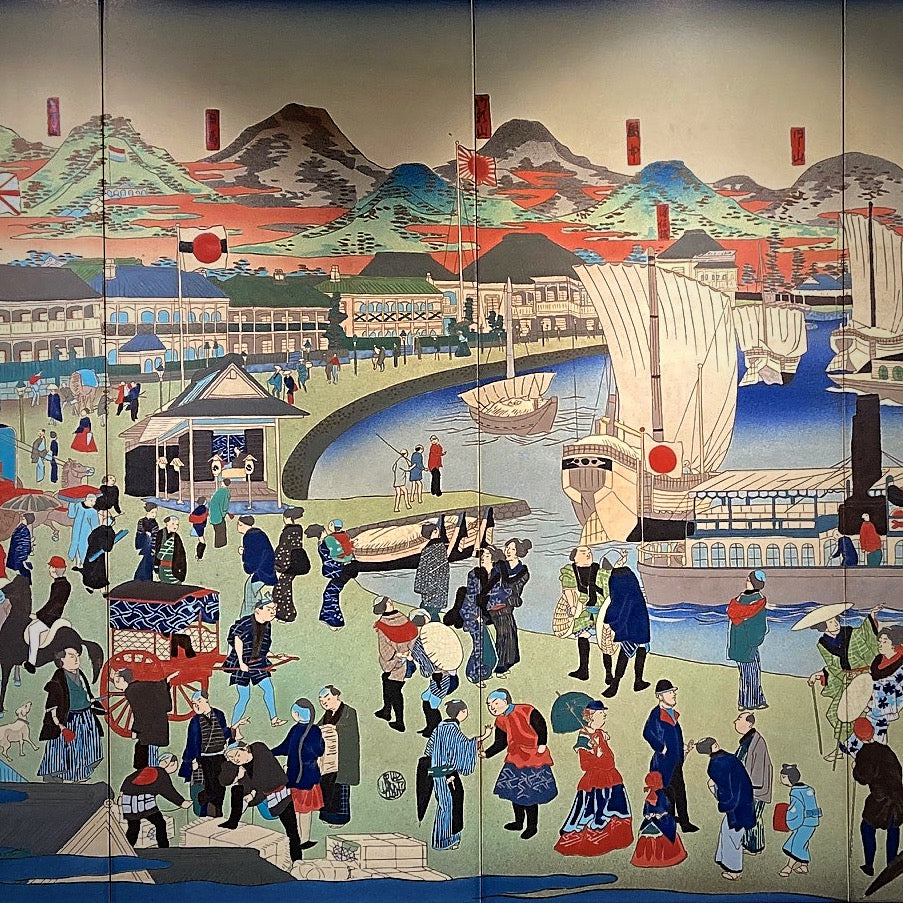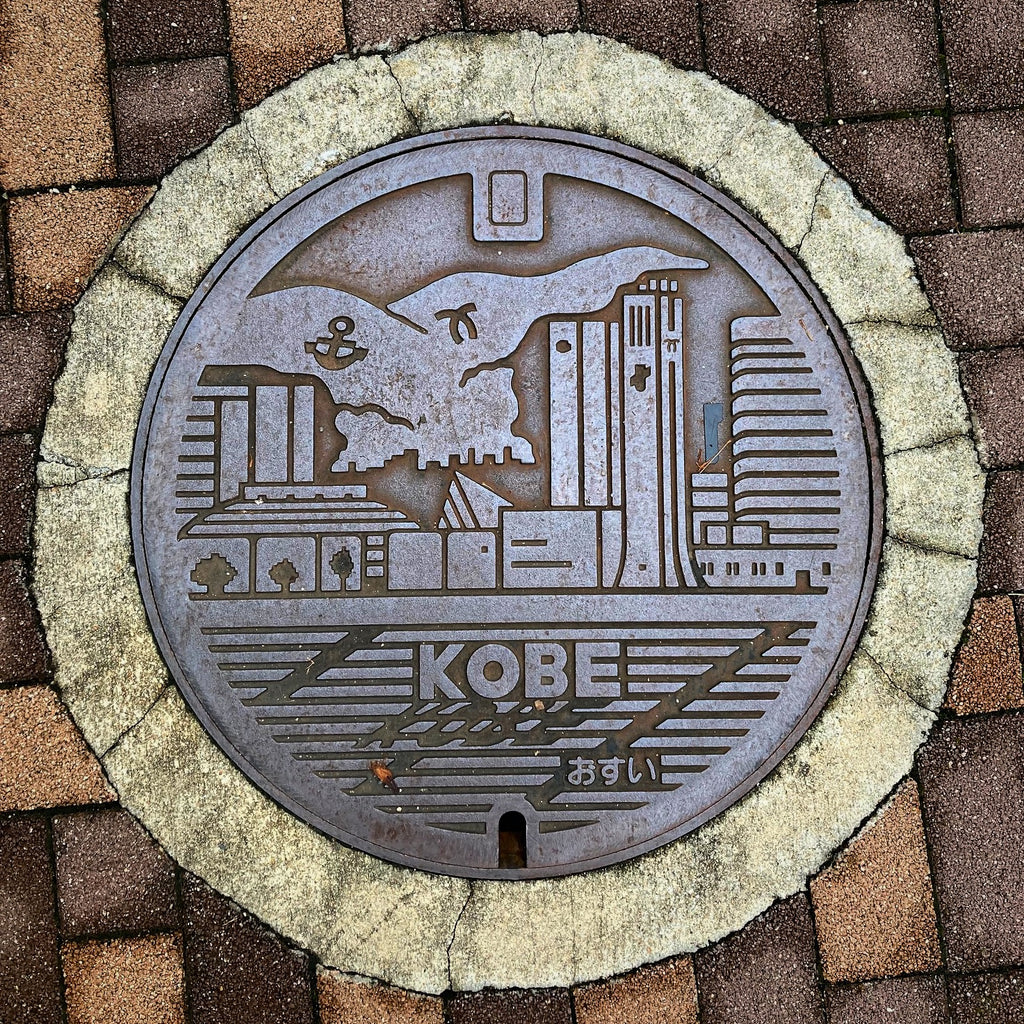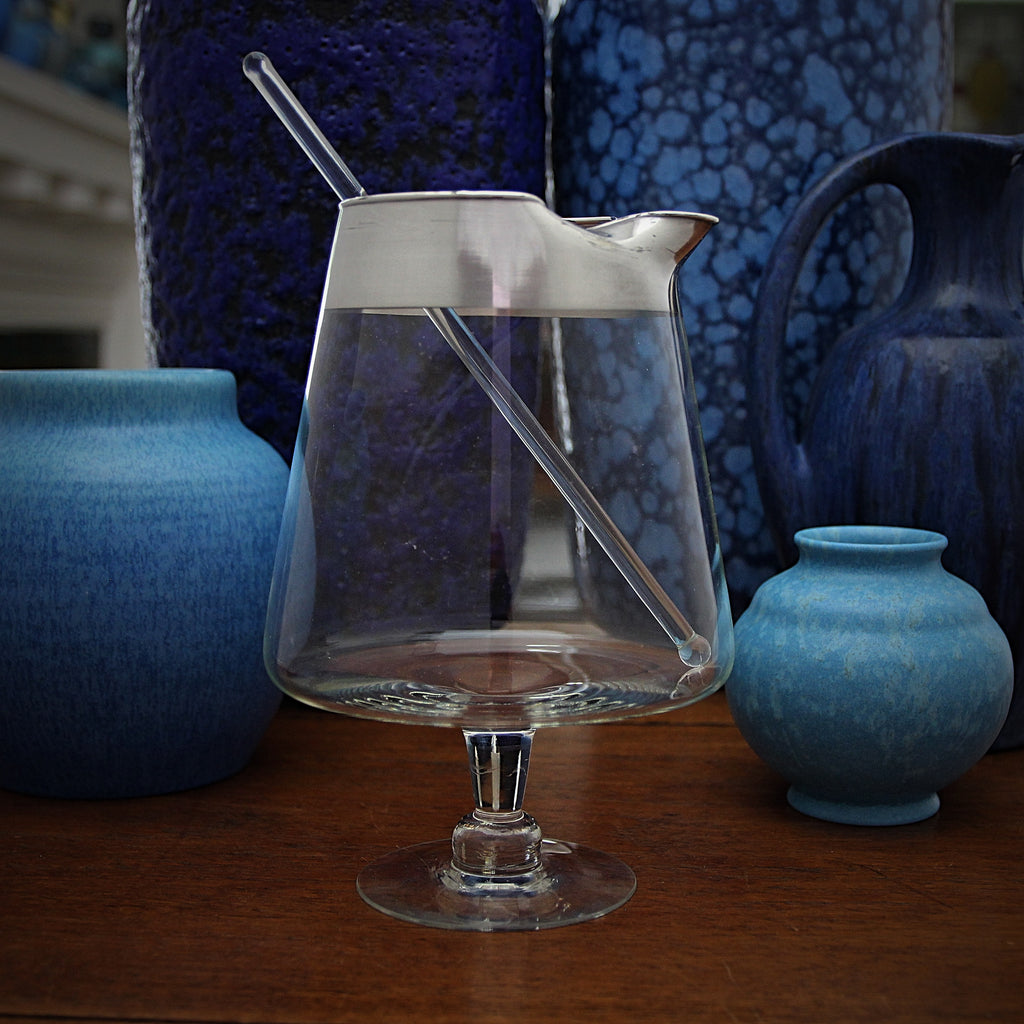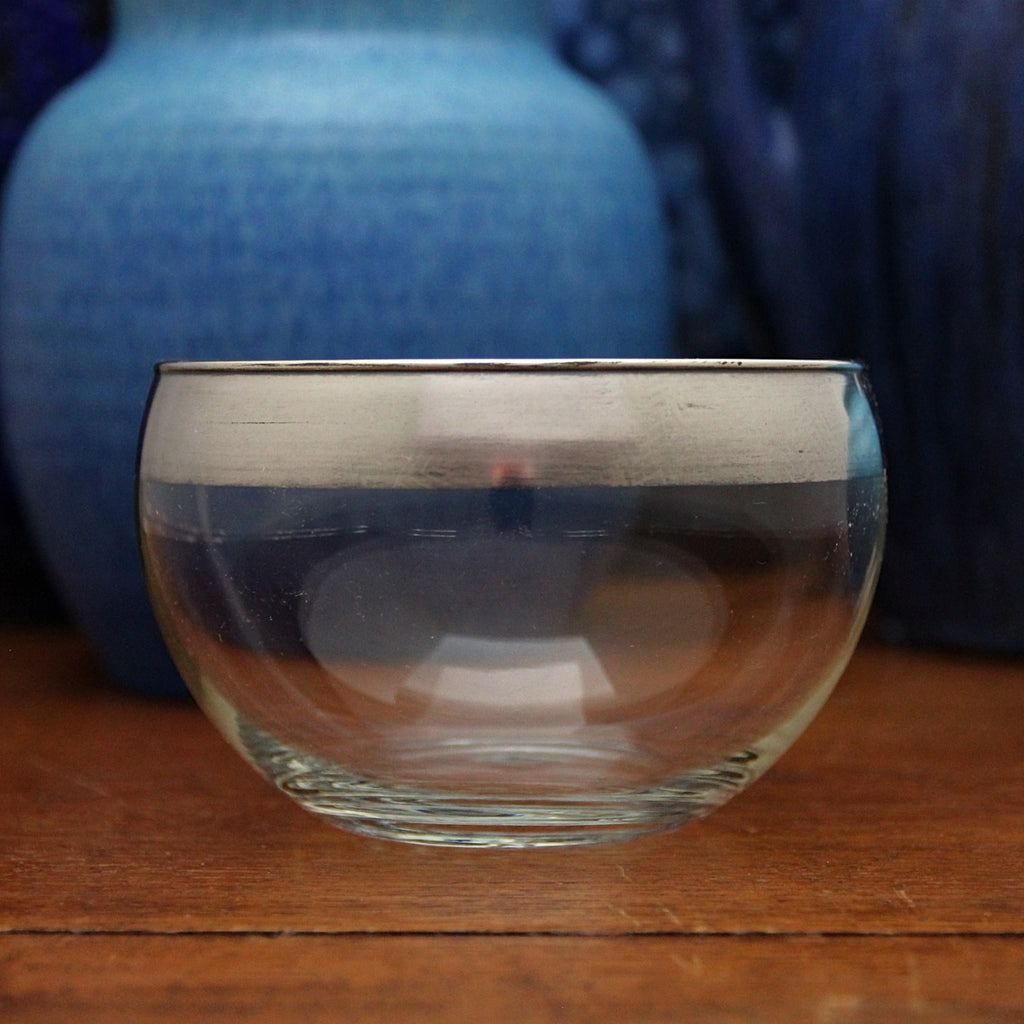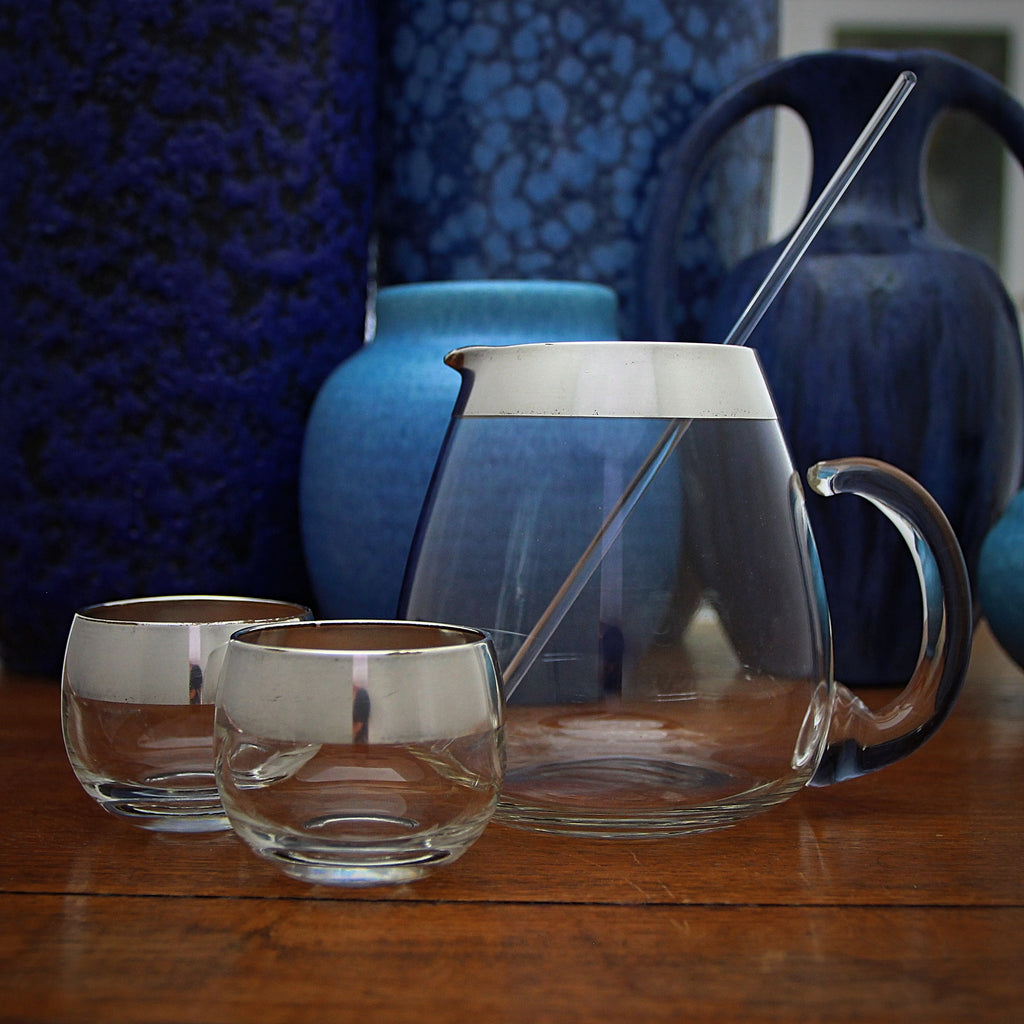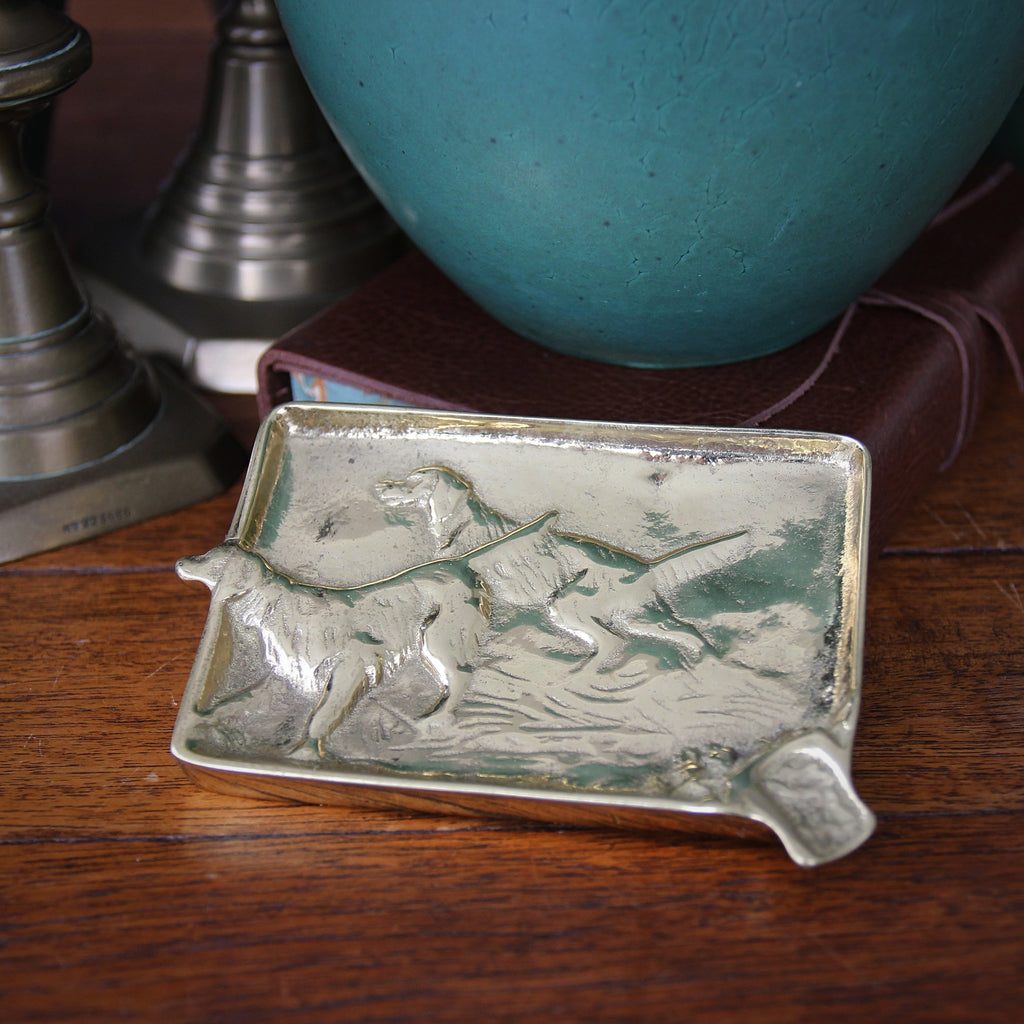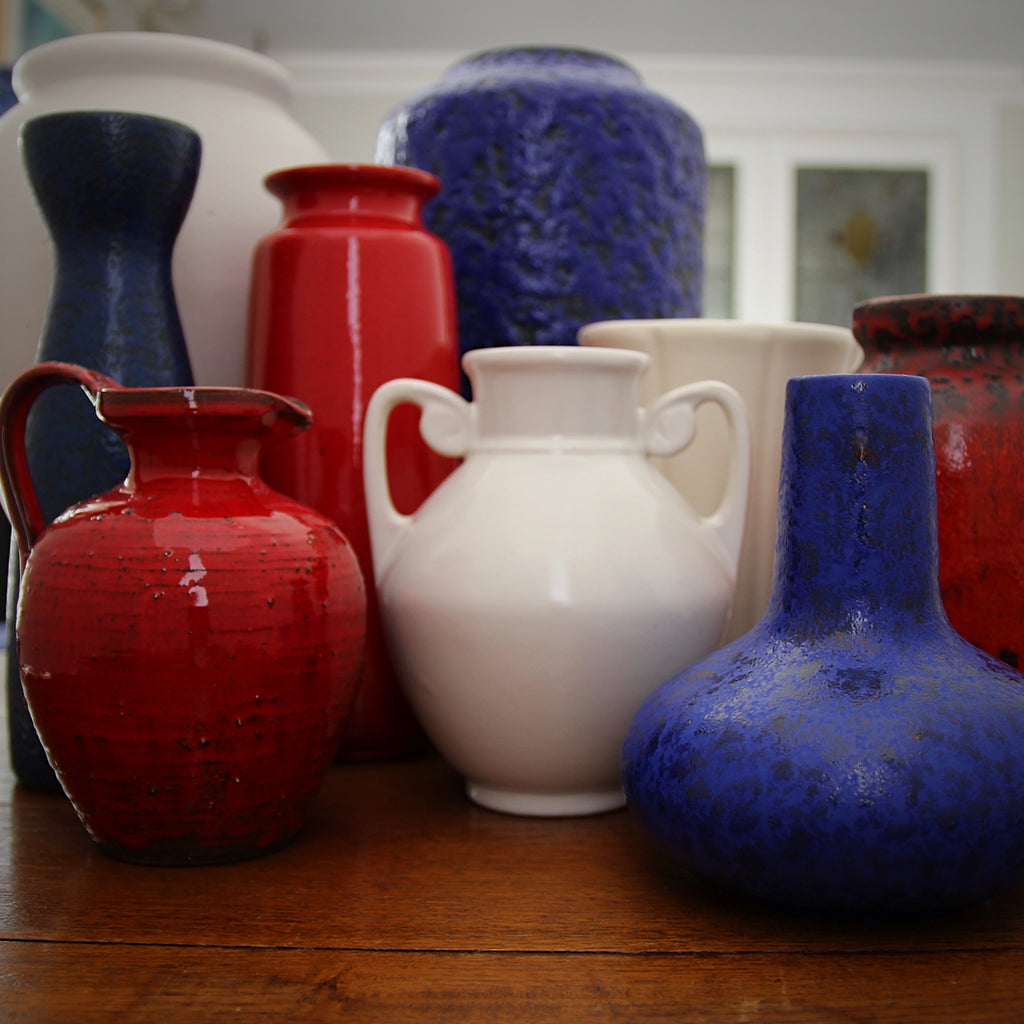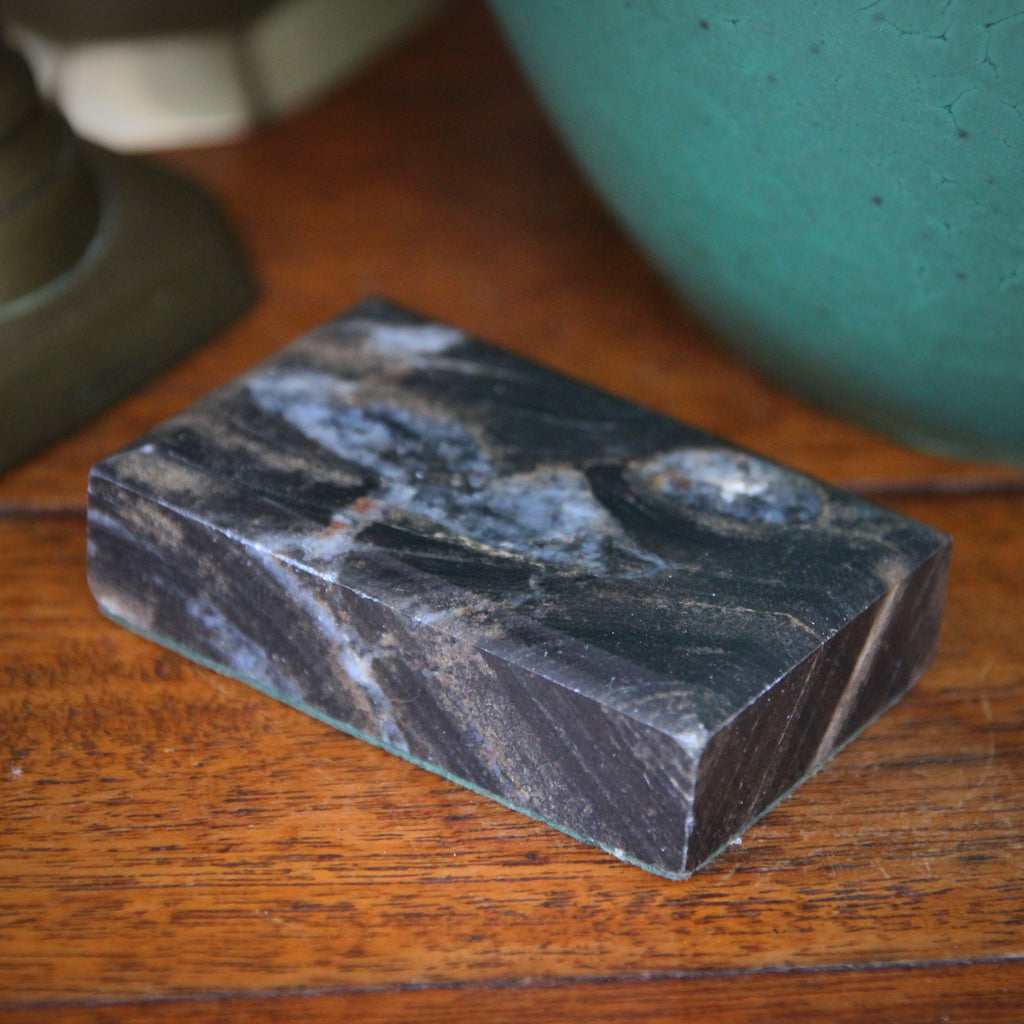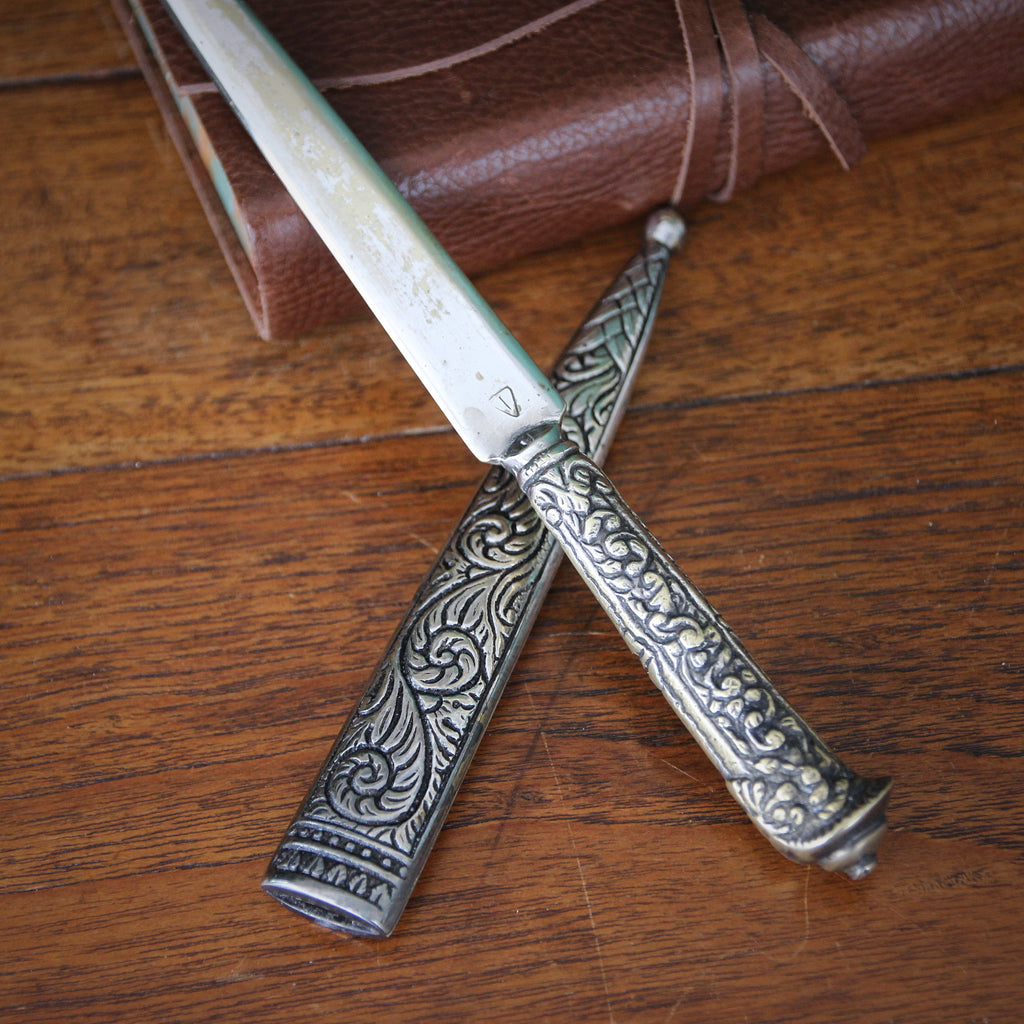JOURNAL RSS
Show-off the last of your Summer tan against the clean, white enameling of these Art Deco sterling silver cufflinks from the Twenties. Machine-turned guilloché work rests below the bright white enameling. A bold ring of Danish blue enameling encircles the white. Clean and classic, these handsome cufflinks will work regardless of the season.
Autumn is Here - part XV
Let's end our procession of Autumnal Offerings with this fat and fluffy bird—apparently well-fed and ready for the Winter! Is that a disgruntled look? Or is he just feeling a bit overstuffed? He is cast in brass, finished with a verdigris bronze patina. Bigger than a golfball—but smaller than a tennis ball—this little bird would make a wonderful paperweight or quiet companion on your desk, windowsill or bookshelf.
Autumn is Here - part XIV
Squirrels aren't the only wildlife wreaking havoc in my urban garden. Deer—over-populated and starving in the forested, nearby Schenley Park—have begun to cross into the city streets in-search of food. Since the mountain lions (which once roamed the area) are now gone, the deer population has exploded and they have stripped their wooded domain of grass, leaves and bark. As they venture out of the forest, they bring numerous problems with them. Automobiles hit them. Ticks (possibly bearing Lyme Disease) drop-off the deer, lying-in-wait for the next dog or human to pass-by. (A colleague of mine is currently battling the devastating effects of Lyme Disease—and not well.) And the starving creatures devour my lovingly-tended plants, sometimes just as they emerge...
Autumn is Here - part XIII
As the Autumn chill increases, we find ourselves hanging-up the garden tools and returning to our indoor pastimes: reading, baking, arts & crafts. For those who sew (or practice other needlecrafts), this hand-carved Swiss Blackforest pincushion might be a handsome and practical solution. Leaves and scrolling branches provide the frame—which, if desired, can be hung right on the wall (next to one's sewing spot). It can also be stored in a sewing basket or on a sewing room table or shelf. If sewing isn't your hobby of choice, this pincushion might be a useful place to hang some of your jewelry: pin-on the brooches directly and hang earrings or necklaces on a straight pin. It is also a clever and handsome...
Autumn is Here - part XII
With Autumn in full-swing, the bears are making final preparations for their months-long Winter hibernations. In the Fall, bears enter a period of "hyperphagia"—gorging on up to 20,000 calories per day (and gaining three pounds per day). They need to prepare for up to five months of confinement (depending on their climate zone) during which they will not eat, drink or eliminate waste. While they may not technically "sleep" right through their entire hibernation, their respiration and heartbeats will drop significantly, conserving precious energy, energy which they will need to complete the hibernation. Bear breeding season in in the late Spring or Summer. Pregnant bears, however, can "suspend their pregnancies"—that is, forestall their fertilized eggs from implanting into their...
Autumn is Here - part XI
The Art Deco ceramic rosebowl, shown here, made by Roseville in the Thirties, is an amalgamation—an artful melding—of two very different aesthetic sensibilities. First there is the form: a high-concept, industrio-mechanical sculpture, reminiscent of the vents on a piece of machinery (if not the gills on a robotic, Jules Verne shark). It's a hard, cold structure—practical, technical, efficient. (And a little scary, like a piece of equipment on the Star Wars Death Star.) Laid upon that is the second factor, the glaze. Its soft, mottled, earthy and organic coloration belies the hard, industrial form beneath. This juxtaposition of the gentle and the stern provides a wonderful contrast—a tension—in the final piece. And, as one can see, the glaze...
Autumn is Here - part X
Dressed in glazes of rusty, fallen Autumn leaves—with just a glint of metallic golden-bronze—this French Art Nouveau ceramic covered pot is animated with organic bas relief botanical elements: swaying leaves and twigs. It's the perfect size for keeping something special, perhaps those souvenir ticket stubs from flights to cherished holidays. Or something more mundane, like collar stays, cotton swabs or potpourri. The covered pot was made by Denbac around 1910.
Autumn is Here - part IX
The Autumn Season is Sweater Season—that most forgiving of garments. Shown here, a faux mohair teddy bear, with posable joints and a knitted, red, white and blue striped sweater. This little guy will make the perfect (quiet) companion—for you or for a youngster in your life.
Autumn is Here - part VIII
October is here! And with it comes the marigold—birth flower for the month of October.
Marigolds originated in Mexico and eventually spread South into Central and South America. This pungently-scented plant has been used medicinally, sometimes drunk as a tea, and it is also employed as a culinary herb. In South Asia, marigolds are used decoratively—strung into garlands or arranged as a carpet—for celebrations and Hindu religious ceremonies.
Over many years, the marigold has been developed into an easy-to-grow garden plant. Its fragrance, which some find unpleasant, is repellant to certain insects (thus marigolds are sometimes planted alongside other plants which require protection from infestation). And many varieties of marigolds have been produced by specialist gardeners.
Autumn is Here - part VII
Amongst the delights of urban home ownership is contending with the wildlife—wildlife which one would think should be living somewhere else (perhaps in a forest). Crows select their urban Winter night roosts every October (and you should hope that that tree is not in your yard . . . or over your car). Deer mow-down any tender shoot as it struggles to break-free of the ground. And the squirrels work all day, every day, to get into (and empty) your wild birdseed feeder. Despite these realities, crows, deer and squirrels all make wonderful decorative subjects in one's home. The squirrel on the stoneware ceramic plaque, shown above, is sculpted in perfect bas relief—from the tense hunch of its back to...
Autumn is Here - part VI
As much as I love the film Gosford Park, the notion of shooting pheasants out of the sky is abhorrent to me. Such beauty deserves to live and thrive! Nevertheless, a "shooting party" is a time-worn, aristocratic Anglo-Autumnal pastime.
Lucky for me (and all those beautiful pheasants), this handsome bird is crafted of finely-painted terracotta. It was hand-made in Italy, by Valeria Vestrini, probably in the 1980s. The painting is exceptional. It is numbered 53/500.
Autumn is Here - part V
Arts & Crafts movements—around the world—sought to "revive" (or "pay homage to") the ancient cultures, histories, art or literature of their particular countries. It was a way of "going back to the older, better times" which haunted the memories of contemporary people. The Brits referenced Medieval literary figures in their Arts & Crafts creations: knights, maidens, monarchs and heraldry. The Germans revived their Gothic folklore and fairy tales. The Celts restored their ancient, Viking-inspired decorative elements (knots, crosses, dragons and hearts). While in America, Arts & Crafts designers paid homage to the ancient, native cultures which populated the country before the arrival of Europeans: Native Americans.
Autumn is Here - part IV
Even a Non-Canadian is likely to agree: the maple leaf is a beautiful thing. Add to that the splendors of "birdseye" or "curley" maple wood—and let's not forget the wonder of maple syrup. O, Canada!
Shown above, a cast pewter maple leaf "dish," finished with a brassy patina. It could be used to hold rings, cufflinks, collar stays, paper clips, wrapped candies or a stack of business cards.
Autumn is Here - part III
Like a misty, autumnal tree scape, the Impressionistic decoration on this Arts & Crafts style ceramic plate provides a moment of calm. Though I do not know where it was made (or when), I enjoy looking at it. The organic green gazing on the rim is especially handsome. It bleeds gently into the landscape, providing a strong but soft framing for the image.
Autumn is Here - part II
Autumn leaves are the surest (visual) sign of the Fall season. Hilltops blush—first with a tinge, then with a flame of color. Sidewalks, eventually, are blanketed with crispy, desiccated leaves. Before long, the skeletal "arms" of trees—trunks, branches, twigs—will lay bare against the silvery winter sky. It's all part of the seasonal cycle of trees, and their leaves, which reminds us that the year moves-on, with or without our consent. But not to worry; the soft green buds of spring will be back in a matter of months. And the whole cycle will begin again.
Autumn is Here - part I
Autumn has begun! Time to pull-out the sweaters, time to feather the nest. Over the next several days, we'd like to share some of our seasonal—Autumnal—items with you. Enjoy the season!
Shown above, a set of six Mid-Century highball glasses, frosted and embellished with 22 karat gold "falling leaves." Though perfect for any time of the year, these glasses embrace the Autumn more than any other season.
Autumn Equinox
This morning at 2:50 Eastern Daylight Time, the Earth will undergo the Autumnal Equinox. The Earth spins on an axis which runs through the center of the Earth, from the North Pole to the South Pole. This imaginary "stick," on which the Earth spins, tilts toward and then away from the Sun over the course of its annual cycle. When the Northern Hemisphere of the Earth is tilting toward the Sun (as it does during the Spring and Summer), the days in the North are longer and warmer. When the Northern Hemisphere of the Earth leans away from the Sun (as it does during the Autumn and Winter), the days in the North are shorter and colder. This cycle of...
Back-to-School - III
Back-to-School cannot be (must not be) all study and drudgery. American Football plays a major role at many schools across the nation. Get into the school spirit with this Japanese crystal football by Sasaki, c. 1960's -1970's. Click on the photo above to learn more about it.
Back-to-School - II
Nothing illustrates the drudgery of academics quite like this pair of bookends, made by Bradley & Hubbard (Meriden, Connecticut) in the Twenties. Cast iron bookends portray a bas relief studious monk, leaning sleepily over his book. The bookends are finished with a bronze patina, the figurals in a golden bronze. Bradley & Hubbard started small—with six employees—in 1852. They produced finely-crafted, decorative metal desk accessories and other household objects. Bradley & Hubbard's design, style and quality was always very good. But they did not have a carriage trade business like, say, Tiffany Studios. Bradley & Hubbard's well-made product line was aimed squarely at the growing Upper Middle Class (and the aspirational Middle Class). By the 1890's, Bradley & Hubbard...
Back-to-School - I
By now the kids (small and big) are back-at-school. These days, "hitting the books" may be an obsolete phrase. But it shouldn't be. All the best people love and collect books, don't they? And, I don't mind adding, the cream of that crop of booklovers also need lots of bookends! Shown above, a pair of Arts & Crafts ceramic bookends made by R. Guy Cowan of Cowan Pottery. They portray a sculpted monk bent over his tome. The piece is glazed in a wonderful, organic dark green. The Cowan workshop was opened in 1912 in Lakewood, Ohio. Initially, most of the production designs were the work of Cowan himself. The studio closed temporarily while Cowan was serving in World...
Unearthing a Trove of Nicholsons - III
Let's end our tribute to the brilliant English artist, Sir William Nicholson, with a tribute to the brilliant American writer, Samuel Langhorne Clemens—better known as Mark Twain. In 1899, Nicholson published his first series of Twelve Portraits, published in London by William Heinemann. This was after Heinemann had already published three other Nicholson portfolios: An Almanac of 12 Sports (1897), London Types (1898), and The Alphabet (1898). Heinemann was keen to keep the business rolling. He proposed a second series of twelve portraits—and even suggested the list of luminaries to be included. The problem was, Nicholson was quite busy! He was running a successful graphic arts and printmaking business with his brother-in-law, James Pryde (called The Beggerstaffs). He was asked...
Unearthing a Trove of Nicholsons - II
In the late Nineteenth and early Twentieth Centuries, a number of Black (mostly American) boxers persevered in their challenging rise to prominence in the competitive boxing circuit. Such matches were certainly freighted with measures of fear, racism and "exotic spectacle"—especially when a Black fighter was matched with a White one. But Black boxers were popular, some developing legions of fans—in America and internationally.
Jack Johnson (1878-1946) was one of the most famous Turn-of-the-Century African-American professional boxers. Others included Joe Jeanette, Sam Langford and Sam McVey.
Unearthing a Trove of Nicholsons - I
I've been collecting William Nicholson prints for nearly thirty years. When I closed the store in Greenwich Village (and moved to Pittsburgh), I brought with me a flat file full of "frameable orphans"—antique pictures waiting to be adopted, that is, placed in a suitable, "forever frame." These prints and paintings have been sitting (in the dark, in Pittsburgh) for the last six-and-a-half years, waiting for me to find them frames. In truth, some of these pictures (including a number of Nicholsons) had been sitting in that flat file for an additional 20 years before the move. What slows-me-down is finding the right, period-correct frame for each special print. Although I collect antique frames, only a small percentage of my "private reserve" frame...
Musings on Central Park
Last week I drove-back to New York to transact some LEO Design business. Now that we no longer have a Manhattan apartment, we stay at a hotel on the Upper West Side. Until moving out of town, we had never required a hotel in the city. I must say, staying in a New York hotel is great, despite the expense. During most visits to New York, I cross Central Park to visit an elderly friend on the Upper East Side. Traversing the park is always one of the highlights of any Manhattan visit. And photo opportunities are always plentiful. On this trip, I pondered the enormous civilizing effect Central Park has on New York City life—especially for those lucky enough...
Musgo Real: Soap-on-a-Rope
When I was a boy (in the Sixties and Seventies), soap-on-a-rope was THE classic Father's Day gift. And it wasn't precious or expensive. I know; I used to buy it for my dad! Alas, today, soap-on-a-rope is very hard to find. I suppose that there is a level of handwork involved (inserting the rope?) which makes it far more costly than traditional bar soap. Furthermore, young men today seem to like body wash and liquid soaps. I guess soap-on-a-rope is a vestige of times past. Lucky for me, I seem to like all things "times past." The soap-on-a-rope shown here was made in Portugal by Claus Porto. It is in their classic Musgo Real ("Royal Moss") fragrance, a masculine blend...
Arts & Crafts Mirrors - III
This Scottish Arts & Crafts mirror is not large, but it packs a big punch. It was hand-crafted in Glasgow around the Turn-of-the-Century. The heavy brass frame is handsomely tooled with deep, scrolling "botanical whatnots"—like a wreath of intertwining rose stems. The crisp medallion-form frame, inspired by Adams (a Scotsman!), manages to confine the piece's sprawling, sculptural energy—which seems to want to burst-forth from the brass.
Arts & Crafts Mirrors - II
Different Arts & Crafts movements—in different parts of the world—sought to "travel back in time" by making references to their country's important historical, cultural, literary or aesthetic past. By reviving these ancient cultural elements, in an aesthetic manner, the Arts & Crafts movement was distancing itself from the Industrial present (and the social problems that came with modern life). Arts & Crafts movements endeavored to resurrect a feeling of the past—"a better, purer time" long, long before. In Scotland (and Wales and Ireland), Celtic motifs were a popular Arts & Crafts aesthetic theme. These "ancient and unspoiled" Celtic decorative elements ticked all the boxes: they were well-know yet primitive; they lent themselves to sophisticated handcraft; and they provided a tasteful...
Arts & Crafts Mirrors - I
When it comes to Arts & Crafts decoration, mirrors are heavy hitters for making a big impact, very quickly. Hammer-in a nail, hang the mirror, and there you go: instant architectural interest. Even in modern, non Arts & Crafts interiors, a handful of period mirrors will give your space a terrific aesthetic upgrade. Best of all, you can move them around easily and take them with you when you move!
The English Arts & Crafts bevelled mirror, shown above, was made around the Turn-of-the-Century. It features hand-hammered butterflies surrounded by classic, Art Nouveau whiplashing. The brass sheeting was hand-tooled and then wrapped around a wooden frame, for support.
22 Years On
22 years later.
At times it seems like just yesterday;
other times, it seems so long ago.
One in five Americans weren't even born, yet,
when the towers came down.
Musgo Real: Aftershave
In 1887, two German businessmen, Claus & Schweder, formed a soap and fragrance company in Porto, Portugal. Over the decades, the company—now called Claus Porto—made fine bath products for Portugal's carriage trade. Some families commissioned their own custom soap fragrances, milled and packaged specifically for their household. Claus Porto's Musgo Real range (that is, "Royal Moss") was born in the Art Deco Thirties. The classic, original fragrance (shown above) is a masculine blend of patchouli, neroli, bergamot, lavender, violet, vetiver and musk. The 3.4 ounce bottle of aftershave comes in an Art Deco inspired bottle. Note that fragrance is labeled and sold within strict industry (and legal) guidelines, based on the percentage of essential oil in the formula (in order: aftershave,...
In Search of the Pharaoh's Daughter - XVII
The ancient city of Jerash is amongst the best-preserved Roman cities outside of Italy. It lies about 30 miles North of Amman, Jordan (previously known by its Greek name, "Philadelphia"). Ancient Greeks called the city "Gerasa." While very old human remains have been found in the area (possibly dating from 7,500 BC), the city really got its start under Alexander the Great—while he was heading home from Egypt in 331 BC. After Greek rule, it was possessed by Jews, Romans, Byzantine Christians, and Muslims. After a massive, destructive earthquake in 749 AD, the city seems to have been abandoned for several centuries until Crusader armies camped here in the Twelfth Century. In time, Ottoman Muslims took the city. The years...
In Search of the Pharaoh's Daughter - XVI
We started our short trek into Petra rather early in the morning—hoping to avoid the heat, dust and crowds. We were only partially successful. It seems that Petra is high on many people's "Bucket Lists." And the mid-day heat is oppressive. Every step on the way into the complex requires the same step taken on the way out. The sandstone mountains and rocky outcrops create a beautiful, otherworldly atmosphere. The anticipation builds as we get closer to Petra. Along the way, we begin to see tombs—both modest and ambitious—like the "Obelisk Tomb" (ambitious) shown above, carved out of the solid rock of the sandstone cliffs, probably in the First Century AD. Bodies of the aristocratic family members would have been...
In Search of the Pharaoh's Daughter - XV
Today proved to be an unexpectedly touching day. We visited Mount Nebo, in Biblical Moab (now modern day Jordan), the site where God lead Moses to view the Promised Land. As the biblical account tells us, Moses was allowed to see the land with his own eyes, however, God informed Moses that he would not make it there himself. He was to die at Mount Nebo and would be buried there. Shown above, the view Moses might have witnessed some 3,500 years ago. Jerusalem and Jericho are hidden in the haze. Today there is a Franciscan Church over the site presumed to be his grave (though there are other competing claims, as well). Being able to visit such a site—any...
In Search of the Pharaoh's Daughter - XIV
The heat and stillness are overwhelming at the Dead Sea. And the thick, soupy water is extremely salty—not refreshing at all. I was warned to avoid getting the water into my eyes or mouth (which did happen). But they say the water is great for a float, especially after applying a thick layer of Dead Sea mud all over your face and body. It didn't dry as quickly as I would have thought; perhaps I was perspiring too much in the heat. But, I must admit, while I did not look any younger after a dip, my skin did feel smooth and hydrated.
In Search of the Pharaoh's Daughter - XIII
It's our last day in Egypt and we decided to explore Cairo's Coptic Quarter—a neighborhood populated with some of Egypt's diminishing Christian population. It's a lovely change of atmosphere from the gritty, bustling commotion of modern Cairo. Almost zen-like. Though full of people, the neighborhood seems to have a calm and centered air. The word "Coptic," in its simplest sense, means "Egyptian." "Coptic Christians" simply means "Egyptian Christians." Though, today, the word Coptic (alone) has come to refer to Egyptian Christians. The Coptic Orthodox Church has its own pope and rites and has been separate from the Roman Catholic or Greek Orthodox Churches since 451 AD. Coptics name Saint Mark (who was evangelizing in Alexandria, Egypt) as their founder. It...
In Search of the Pharaoh's Daughter - XII
The Temple of Horus was built in the Ptolemaic (or Hellenistic) Period (332-30 BC) when the Greeks were in-charge. Alexander the Great kicked-out the Persians from Egypt in 332. He crowned himself King, though he was careful to observe all Egyptian customs and artistic requirements when building structures to commemorate his powerful (and deified) reign.
Shown above, a black granite sculpture of Horus the falcon, the Patron God of royalty, strength and protection. Here he wears the pharaonic crown. In Ancient Egypt, gods were king and kings were gods. Horus is one of the most important gods in the Ancient Egyptian pantheon, and this sculpture (as pharaoh) reinforces the belief that kings were gods on Earth.
In Search of the Pharaoh's Daughter - XI
Today we visited Aswan and took a motorboat out to Agilkia Island to visit the Temple of Philae Complex: a temple dedicated to Isis and the unfinished Trajan's Kiosk. In 1902, the Aswan Dam was built. Though it helped Egypt to control and regularize the flow of the Nile (so crucial to agriculture and the feeding of a growing population), the dam also endangered numerous ancient archaeological sites and the Egyptian homeland of the Nubian people. A second dam further upstream, called the Aswan High Dam (conceived in the Fifties), also would have submerged numerous important archaeological sites. When the controversial dam opened in 1970, it displaced many Nubians living in that area. They were forced to relocate; some moved down...
In Search of the Pharaoh's Daughter - X
If you love old columns—as I do—Luxor is for you. In fact, what are ancient stone columns but an architectural form of sculpture? And I love all sculpture including columns and (especially) their capitals. There are two significant temples in Luxor (the city once called Thebes), each packed with handsome stone columns: the Temple of Luxor and the Temple of Karnak. Between the two temples lies a 1.8 mile processional walkway called the Avenue of Sphinxes. In ancient times, on certain festivals, statues of the gods would be carried in procession from one temple to the other. This lane was once lined along both sides with over 600 sphinxes. Many remain, though some of them are now damaged or...
In Search of the Pharaoh's Daughter - IX
Hatshepsut (1507-1458 BC) had real Girl Power. She was the daughter of Pharaoh Thutmose I, married her half-brother, King Thutmosis II, and served as his queen. When the king died, Hatshepsut's stepson, Thutmose III, was crowned Pharaoh at the age of two. Hatshepsut served as Queen Regent to her stepson, ruling in his stead. That, however, didn't suit Hatshepsut's ambition, ability and power. She crowned herself King and began portraying herself with all the male titles, dress and appurtenances that came with the masculine office. Hatshepsut built many important monuments during her reign including the Temple of Karnak and her own impressive mortuary temple, shown above. Hatshepsut insisted in being portrayed as a man (as seen in her sculpture as...
In Search of the Pharaoh's Daughter - VIII
King Tutankhamun ascended the throne at nine and was dead at 18. This left insufficient time to plan and start building (let alone finish) a proper tomb for The Boy King. Instead, the tomb of an aristocrat in The Valley of the Kings was appropriated and adapted—very quickly!—for the burial of King Tutankhamun. Embalming and mummification took about 70 days, which did not leave much time for an elaborate tomb to be built, decorated and furnished. Howard Carter was a British archaeologist working in Egypt whose exploration was funded by Lord Carnarvon (of Highclere Castle of "Downton Abbey" fame). He began working in the Valley of the Kings in 1906 and is credited with discovering the Tomb of the pharaoh...
In Search of the Pharaoh's Daughter - VII
We awoke this morning to a pastel view of The Valley of the Kings, across the River Nile, in Luxor, Egypt. We were eager to explore the hot and dusty limestone crevices of this hidden valley—a place where pharaohs, queens and (invited) noblemen have lain buried for thousands of years. These desert mountains are certainly an inhospitable place for nosy on-lookers or ruthless grave robbers. The pharaohs (and their teams who planned their funerals) believed that this desolate place would provide privacy and protection until their royal souls could come back and re-animate their carefully preserved corpses. But people did find their graves—grave robbers, mercenaries and scholars—some as far back as antiquity and some in the Twentieth Century. Though the...
In Search of the Pharaoh's Daughter - VI
Today we sailed to Qena in Upper Egypt. Observe that "Upper Egypt" is to the South (closer to the source of the Nile) while "Lower Egypt" is to the North, closer to the Mediterranean (where the Nile ends). The Nile has provided life-sustaining water and transport to Ancient Egyptians (and Modern Egyptians, too). When one travels "Up the Nile," he is traveling South, towards the river's headwaters. In Qena, we visited the Temple of Dendara, shown above, dedicated to the worship of the Goddess Hathor. It was built circa 54 BC, during the Roman occupation. Carved and painted decoration during this time will often show the Roman (or Greek) conquerer depicted as a Pharaoh, accompanied by the gods and...
In Search of the Pharaoh's Daughter - V
Why shouldn't Egypt be hot? It's 90% desert. And it's August. Nevertheless, the sights are worth every drop of sweat. Today we travelled to Giza, the site of magical, mysterious and iconic sights. Even a person who has never been here before might feel as though s/he knows it . The images already are ingrained in every curious mind. We had been here once before, ten years ago, and are impressed with how the Egyptian government, the Ministry of Antiquities, has improved the visitor areas around the sites since then—all for the improvement of protection, scholarship and public education. But it's still hot and dusty. Occasional breezes will blow fine limestone sand into one's hair, upon one's moist skin and...
In Search of the Pharaoh's Daughter - IV
The Mosque of Muhammad Ali Pasha, Ottoman ruler of Egypt during the first half of the Nineteenth Century, can be seen from much of the city of Cairo. It is built high on a hill, within the fortified "Citadel" complex, the Medieval Islamic fortress which was the seat of Egypt's rulers for centuries. The mosque was built between 1830 and 1848 of limestone, alabaster and lead—for the silvery metallic domes and other metal roofing. The architect, from Istanbul, modeled it on the Sultan Ahmed Mosque in his city, also know as "The Blue Mosque. Muhammad Ali Pasha is buried in this mosque.
In Search of the Pharaoh's Daughter - III
Nothing (or almost nothing) is ever truly new. Artists, designers and craftsmen have been stealing good ideas from their predecessors since, well, forever. In fact, it is those artists who attempt to be inventive who often end-up disappointing me the most. In my humble opinion, taste, aesthetics and execution are what makes good art—not novelty or innovation (unless taste, aesthetics and execution also are employed). I love finding links between the great design of today (or yesteryear) and the design which came well before that. Today I will show you three ancient examples—all to be found in the Egyptian Museum, Cairo—which have found their ways into Nineteenth and Twentieth Century art and design. Shown above, a hand-carved granite "palm column," made...
In Search of the Pharaoh's Daughter - II
A Phalanx of Pharaohs assemble to greet visitor at the Turn-of-the-Century Egyptian Museum in Cairo. Big ones, little ones, stone ones, wooden ones: they are all impressive, commanding, and meant to display the best attributes of the Pharaoh King. They are also beautiful.
We also see King Menkaure (who reigned in the late 2500's BC) in a "triad" sculpture alongside two goddesses, Hathor and Bat. He wears the conical crown of an Upper Egypt king. The trio is carved in grey-green schist and it was found in Giza in 1908. It was carved between 2530 and 2494 BC.
In Search of the Pharaoh's Daughter - I
After twenty-four hours of traveling—door-to-door—we staggered into our comfortable and quiet hotel room in Cairo, desperate for a shower and a nap. We'll stay here for three nights before heading South to sail Up the River Nile. The photo, above, shows the view which greeted us this morning, out our hotel room window—across the Nile to Zamalek Island. At 4,130 miles, the Nile is the longest river in the world (my Egyptian guide assures me, despite recent claims that the Amazon might be slightly longer). It is fed by two tributaries: the Blue Nile (which begins at Lake Tana, Ethiopia) and the White Nile (which begins at Lake Victoria, Uganda). The Nile flows northward, emptying into the Mediterranean Sea, but...
Cairo-Bound
After three years of cancelled vacations, we are finally enjoying a long-wished-for holiday: a visit to Egypt and Jordan. We've already visited Cairo and Alexandria—two fascinating cities—ten years ago. But we've never been further inland. This time, we will get to see some important archeological sites along the Nile and visit the ancient city of Petra in Jordan. By the time you read this journal entry, we should have touched-down on the African continent. Egypt holds a complex fascination for us. For most of 2020 and 2021, my husband, Robert Perdziola, spent 18 hours a day hunched over his drafting table, designing the sets and costumes for the ambitious Nineteenth Century ballet, The Pharaoh's Daughter for the Mariinsky Theatre in...
Last Days of LEO - Part III
Let's mark the last day of LEO with this sensational, impressive piece. It is a beautifully-rendered model of the 1840 "Walking Lion" by French animalier par excellence Antoine-Louis Barye (1795-1875). Barye, who had little formal education, began his artistic career working for his father, a goldsmith and military engraver. He later was apprenticed to Napoleon's master goldsmith. After military service (1812-1814), he found work in a painting studio, followed by work with a sculptor. From 1818 to 1823, Barye studied at the esteemed École des Beaux Arts. His public debut as a sculptor occurred at the Paris Salon of 1831—after which he generated many government, religious and private commissions. When key patrons died, and commissions slowed, Barye began producing limited...
Last Days of LEO - Part II
The Minoan Civilization—centered on the Mediterranean island of Crete—is considered the first civilization in Europe, which coalesced some 5,000 years ago. Around 1450 BC, they came under the domination of the Mycenaeans (Ancient Greeks) and a hybrid culture developed. But the art and society of the Minoans (as can be seen at the Palace of Knossos) was lively, energetic and wonderful. The island boasts a small but terrific museum. The vase above, made in Art Nouveau Belgium by potter Antoine DuBois, is inspired by ancient ceramics such as those found in Crete. A Minoan or Greek-inspired lion leaps beneath a band of Greek Key fretwork. On the reverse, a Greek stylized palm leaf can be found, similar to those found...
Last Days of LEO - Part I
We're in the last three days of LEO; Virgo is waiting in the wings. Let's countdown the last days of LEO with an assortment of handsome feline gifts.
Shown above, a pair of cast iron bookends with portraits of a regal King of the Jungle. They were modeled by the talented sculptor Gregory Seymour Allen who was born in New Jersey in 1884 and died in Glendale, California in 1934. Alas, I can find little biographical information about the artist or his life. But I can see that he was a talented sculptor, judging by his work on this pair of bookends.
Money, Money, Money
Every country has its typical, traditional National money box—a place where money-changers, shop keepers and street vendors can keep their cash (safe and organized) while doing business. In England, cash boxes seem frequently to be black-painted steel with gold edging, sometimes with additional decorative painting on the top. In other countries I've seen other commonly-used styles: wooden boxes or trays (with or without denomination dividers), plastic "tackle" boxes with a top handle, or even old coffee cans. In America, at least within my lifetime, I've always observed merchants using the same very utilitarian, hinged rectangular metal boxes—usually finished with soft grey or putty colored baked enamel. A removable black plastic coin tray usually sits inside.
René Jules Lalique
René Jules Lalique was a French jeweler, interior decorator, medal sculptor, and (most famously) the designer and maker of luxurious decorative art glass wares during the Belle Epoque period. He was born in Aÿ, France, in 1860 and moved with his family to Paris at the age of two. As a teen, he took drawing classes at school, supplemented with night courses at the Ecole des arts décoratifs. When Lalique's father died, René became an apprentice jeweler to a Parisian goldsmith. learning the trade of jewelry production. He continued taking art classes at the Ecole des arts décoratifs. At twenty one, René began providing freelance jewelry designs to such luminaries as Cartier and Boucheron. At 26, Lalique founded his own jewelry...
My Little Cabin
Modern people—especially urban denizens—often long for a little place in the country where they can get-away from the bustle of workaday life. A place to go, perhaps for the weekend, where they can relax amidst nature and "recharge their batteries." The Adirondacks in Upstate New York is full of city dwellers (at least on the weekends). Bostonians choose Cape Cod, New Hampshire or Maine to get away. And the many (many) islands which populate the waterways near Stockholm are dotted with thousands of cute red and white weekend cabins. Whether used for hunting, fishing, reading or cooking, these little weekend homes provide the rest and relaxation needed to counteract the hustle-and-bustle of modern, city life. This little log cabin,...
Japanese Cloisonné
Cloisonné is the French word for the enamel work technique in which a metal surface (usually copper or brass) is artfully subdivided with metal wires or strips to create small fields—each holding a different color of enamel. Glass powder is blended into a paste and applied to each field (called a "cloison") following the designer's color plan. Once the colored pastes are applied, the piece is fired in a kiln (to melt, that is "vitrify," the glass powder into enamel), cooled and polished to create a smooth, lustrous surface. In some cases, whole gemstones were cut-to-fit and inserted into the fields. But the use of glass enameling was a quicker, less costly way of achieving an impressive effect.
Counterbalance
Before digital scales were invented, objects were weighed by "balancing" the object against another group of objects whose weights were already known and could be added-up. On one side of the balance, a measure of grain. On the other side of the scale, a group of counterweights which balance the weight of the grain.
The handsome—and sculptural—industrial scale weights, shown above, were made in the early Twentieth Century. Each brass weight (raging from .8 ounces to 10 pounds) is marked with its weight. These counterweights would have been used, in combination, to ascertain the weight of some other object. Add and subtract weights until balance is achieved. Then, simply add-up the total weight of the multiple counterweights.
St. Johnsbury to the World
Thaddeus Fairbanks, of Saint Johnsbury, Vermont, was an inventor, mechanic and wagon-maker. He developed a cast iron plow and a cast iron oven, yet he was disappointed with contemporary weighing scales. They were inaccurate and difficult to use. With his brother, Erastus, he formed the E & T Fairbanks Company. With their clever new inventions, the brothers' business rocketed—and their timing was perfect, right at the start of the Industrial Revolution. By the 1860's, at the time of the American Civil War, Fairbanks scales were the most famous American product in the world. Thaddeus achieved ease and accuracy of weighing by applying the physics of leverage to reduce the amount of counterweight needed to measure heavy objects. He developed...
. . . And a Sublime Summery Sky
We're sharing selections from our collection of art pottery, now in-stock at LEO Design, which reminds us of the Summer: the sea, the sky. This English Art Deco piece, made by Beswick in the Thirties, is a delicious combination of aqua glaze, topped with sponged-on cornflower "tendrils." The bright, optimistic coloration can only mean Summer. And the form—reminiscent of a fat penguin—adds to the piece's happy mien. It's large enough to make a statement on its own. It would also look wonderful anchoring a collection of aqueous ceramic vessels.
Summer's Last Tide . . .
The Summer ends six weeks from today—on Saturday 23 September. While six weeks of Summer sounds like a good, long time, in fact, the kids will be heading back to school in a matter of days (if they're not in-class already). The snap of Autumn (along with apples, sweaters and pumpkin spice) will be with us before you know it. So, let's bask in the glory of Summer warmth for a few more days. This impressive West German Modernist vase is tall, topped with four "strap-ring" handles, and is dressed in a foamy, aqueous glaze—like turquoise seawater churned with traces of foam. Its bright, optimistic color certainly reminds me of Summer. Perhaps it will take us back to those wonderful,...
The Dog Days of Summer - Part X
Let's end our parade of Summer "Hot Dogs" with this curious little pup—a cast bronze canine, a symbol of "Puppy Love." For on the bottoms of each of his paws are found the letters L, O, V & E. Give him to a sweetheart. Or keep him for yourself, a reminder of that special someone who once (inexplicably?) haunted your consciousness. This little rascal—impressionistic though he is—radiates playful curiosity and energy.
The Dog Days of Summer - Part IX
We are counting-down the last of the "Dog Days of Summer"—a forty day period scheduled to end on 11 August. To commemorate these waning days of Summer, we'd like to share some of our favorite "canines" from the LEO Design collection. Consider sending one as a gift to your favorite dog lover.
Our little pup, shown above, is as winsome as he is determined. Formed of cast iron, he is painted—mostly black, but finished with a red bow. Click on the photo above to learn more about him.
The Dog Days of Summer - Part VIII
We are counting-down the last of the "Dog Days of Summer"—a forty day period scheduled to end on 11 August. To commemorate these waning days of Summer, we'd like to share some of our favorite "canines" from the LEO Design collection. Consider sending one as a gift to your favorite dog lover.
Scotties—formally called Scottish Terriers or Aberdeen Terriers—were developed in Scotland as "ratters"—dogs bred to capture and kill rats around the home or on a farm. The first reference to them was in literature published in 1432. In the Seventeenth Century, English painter Joshua Reynolds included a Scottie in a portrait of a young girl.
The Dog Days of Summer - Part VII
The Russian Wolfhound, despite its imperial bearing, is no palace lap dog. In fact, they were originally developed to hunt wolves with their human masters—a grueling and dangerous activity, indeed. The breed was developed in the 1500's, a cross between the Saluki and other European "Sighthounds." A "sighthound" is a type of dog which hunts with vision and speed (as opposed to "scent hounds" which track game with their advanced sense of smell). Russian Wolfhounds have a wavy top coat and a thick undercoat to keep them warm in the winter (which falls away in the warmer months). Russian Wolfhounds were so beloved of the Tsars that Russian subjects were not allowed to purchase one. The only way one could...
The Dog Days of Summer - Part VI
A "naughty dachshund" is featured on this pair of cast metal bookends, made in the Seventies. A bronze alloy is moulded in this highly three dimensional figural—a stack of books, with the top volume being gnawed by the problem pooch. They are finished with an antique golden bronze patina and stand ready to hold-up your collection of favorite tomes.
The Dog Days of Summer - Part V
Before the days of residential air conditioning, windows were left open—and doors required "fixing-open," to prevent them from slamming-shut in a breeze. A wooden wedge-shaped offcut was all one needed to stop a door. But how much fun is that? Metal foundries stepped-in to produce a wide variety of doorstops (and other metal household items), often highly decorative). Hubley Manufacturing was one such company. Founded in Lancaster, Pennsylvania, in 1894 by John Hubley, the company made a range of decorative sand-cast iron doorstops, some of them modeled after different breeds of dogs. The process started by carving an excellent wooden model—complete with details like fur, musculature and facial features. The model was then pressed into a tray of sticky sand,...
The Dog Days of Summer - Part IV
We are counting-down the last of the "Dog Days of Summer"—a forty day period scheduled to end on 11 August. To commemorate these waning days of Summer, we'd like to share some of our favorite "canines" from the LEO Design collection. Consider sending one as a gift to your favorite dog lover.
Speaking of the Dog Days, this "Slouchy Puppy" really hits the mark. His sculptor imbued the form—cast brass finished with a rustic verdigris patina—with a slouchy puppy's energy (or lack thereof). He could be used to hold-up some hardbacks. But he was made to sit on your coffee table, bookshelf or nightstand—relaxed, attentive and always ready to join you on the next adventure.
The Dog Days of Summer - Part III
This pair of antique bookends—I've had a few of them during LEO Design's 28 years in business—has always been a customer favorite. Handsomely sculpted, proudly alert, these Shepherds are noble, fit and fine. They were made in the Twenties, the heyday of German Shepherd Superstar "Rin Tin Tin." Rin Tin Tin was a German Shepherd who appeared in 27 Hollywood films. He was immensely popular, worldwide, and ignited an interest in German Shepherds as American household pets. An American soldier had discovered him, his mother and four littermates in a bombed-out kennel in France (1918). The soldier rescued the dogs giving four of them away. But he kept one male and one female puppy for himself—eventually sneaking them aboard his...
The Dog Days of Summer - Part II
We are counting-down the last of the "Dog Days of Summer"—a forty day period scheduled to end on 11 August. To commemorate these waning days of Summer, we'd like to share some of our favorite "canines" from the LEO Design collection. Consider sending one as a gift to your favorite dog lover.
"Man's Best Friend" is certainly apt—to anyone who has had and loved a dog. This sculpted bird dog—standing quietly attentive—should remind any sportsman of a favorite hunting companion. He's cast in brass and finished with a rusticated verdigris bronze patina. He'll stand loyally on your desk or bedside table—awaiting the signal to fetch your game.
The Dog Days of Summer - Part I
We think of "The Dog Days of Summer" as those mid-Summer days—hot, humid and still—when we should follow the example of our canine friends: lie still in the shade and drink lots of water. And, perhaps this is true.
But the origin of the term "Dog Days" actually refers to the "Dog Star," also called "Sirius." Sirius is the second brightest star in the sky (after our Sun) and is part of the constellation cluster "Canis Major." The Dog Days begin when one can observe Sirius rising along the horizon at dawn (usually around 3 July). The period lasts about 40 days (usually to around 11 August).
August is Here
It's August! Thus, let's welcome the month's birthstone, Sardonyx. Sardonyx is "striped" with random bands of two different variations of chalcedony: "Sard" (the reddish portion shown here) and "Onyx" (which is shown above in white). The range of possible natural colors is quite wide (including black and white) and, like onyx, the stone can be color-treated with heat or chemical washes (usually various acids) to amplify or change the stone's natural color. In the antiques retail trade, sardonyx is sometimes casually called "agate." Agate and sardonyx, though related, are differing varieties of chalcedony. Agate is usually softer than sardonyx and agate's bands are more irregular than the straight-ish lines found in sardonyx. Both stones, sardonyx and agate, are used...
Earlier Aesthetics
In the world of design and aesthetics, rarely is anything truly new. Designers, staring at their empty sketchbooks (and, perhaps on-deadline) have been "borrowing" other artists' good ideas since the Mesopotamians (and maybe before that). And this is not a bad thing. In my book, novelty is never as important as taste, beauty and craftsmanship. Appropriation—of dress, cuisine, architecture or artwork—is acknowledgement of someone's else's good choices. In the Arts & Crafts period, for example, designers and artists around the world sought local references from the artists (and the culture) which came before. Part of this was to honor the culture in which the (contemporary) artists were working. Additionally, Arts & Crafts designers were attempting to "go-back" to an...
A Desert Drive
At about this time last year I visited my mother in the Southwest, where she lives. Though she inhabits a fairly large town, which is part of a larger cluster of towns, her community remains "amenity-free"—meaning, in this case, that the nearest operating airport is 4 hours away by car. (By the way, there also are no arthouse cinemas or comprehensive bookstores in her town, either). I surmise that few people in her region of 100,000 people ever go anywhere by plane (or see foreign films or read secular books). So I flew to the nearest airport, rented a car, and drove the additional 4 hours to join her. Despite my annoyance (and travel exhaustion), it was a beautiful...
Back To The City - Day 4
Though I lived in New York for 27 years, I never knew that the New York Historical Society exhibited a sensational collection of Louis Comfort Tiffany leaded glass lamps and other Tiffany Studio objets. 100 lamps—table lamps, lanterns, chandeliers—are beautifully displayed in a two-floor gallery. Never have I seen such a wonderful accumulation of Tiffany items, all in one place. Besides lamps, there are a small number of desk accessories and a large stained glass window depicting the good shepherd. The collection—indeed the entire New York Historical Society—is a true gem. It was a hidden gem, for me (at least for 27 plus the six years I've been gone). But it's hidden no more. I intend to visit frequently, whenever...
Back To The City - Day 3
The highlight of my visit to New York was seeing the wonderful exhibit of paintings by Joseph Christian Leyendecker at the New York Historical Society. (Followed by my tour of the Society's Tiffany lamps on the fourth floor, more about that tomorrow.)
The painting above, In the Yale Boathouse, is one of seven works he created for the July 1905 issue of Scribner's Magazine, illustrating Ralph D. Paine's article "A Victory Unforeseen."
Before there was Bruce Webber and Abercrombie & Fitch, Leyendecker created a Turn-of-the-Century standard of aspirational American male beauty. For me, "aspirational" is a key word. When I behold Leyendecker's riveting images, I often perceive a touch of sadness in his paintings.
Back To The City - Day 2
It was a hot and steamy day in New York today. So the cool comfort of tree-lined Bank Street provided welcome relief as I trekked-down to see my old shops on Bleecker and Hudson Streets. It's been six-and-a-half years since I closed my shop and moved to Pittsburgh. Since then, I had spent very little time revisiting Greenwich Village, the locus of so many important memories. Today, I decided, it was time to come see the old neighborhood which had become a turning-point in my life. In a city where very little remains the same (like old my storefront—and most of the shops I remembered), I was comforted to see that the up-turned paving stone, on the left side of...
Back To The City - Day 1
One of the first lessons I learned, as a brand new New Yorker, was this: when walking down the street, don't look up! Somehow, taking in the sights would mark me as a tourist, a curious spectator—not a real New Yorker.
Well, forget it. Now, when I return to the city, I am a tourist. Of sorts. And I am not shy about looking-up and marveling at the beautiful, Pre-War architecture—the craftwork of thousands of unknown human hands.
Always Good Intentions
I remember Eighth Grade Shop Class quite well. It was at Kapaa Intermediate School, on the Hawaiian island of Kauai, and we would rotate through the various "disciplines" quarterly: woodworking, metal craft, technical drawing and gardening. If Mother's Day or Father's Day happened to coincide (even approximately) with the woodworking or metal craft interval, you could be certain that a "love-crafted gift" would be going home to the parent in question. Now, 47 years later, I can still clock a shop class creation from across the flea market. The piece always has good intention; it's the level of finesse which varies. And I always spare a thought for the (poor?) parent who was required to "oooh and ahhh" at the...
I'm Not Going Native!
Though I live in the City of Pittsburgh, I am part of a multi-dealer group shop, The Antique Center of Strabane, in Washington County—the suburban (and rural) region south of The Steel City. Thus I am a daily witness to the aesthetic "taste preferences" of this non-urban population. What's most popular in this area is a rustic country look, sometimes called "primitives." This means crocks, old kitchen accoutrements, and rustic, painted wooden furniture.
One such example of primitive goods is the weathered knife box, shown above. It displays the "life wear" which primitive collectors want, plus substantial traces of the original paint, in this case white.
LEO Is Here!
LEO is here! It's 23 July, the first day of LEO—namesake, of course, of my favorite shop, LEO Design. It is also my X-tieth birthday, one I'd prefer to ignore. (Don't we get a three year "birthday rebate" because of Covid?) Instead, let me turn your attention to the regal lion, majestic embodiment of the LEO sunsign. This winsome feline guards the deposits held at Dollar Bank on Pittsburgh's Fourth Avenue—once known as the city's Wall Street. The bank was founded in 1855 and this handsome (and imposing) flagship location was built in 1871 (with 14,000 tons of Connecticut brownstone). The original pair of lion sculptures were carved by 28-year-old German immigrant, Max Kohler (assisted by a 25-year-old Welshman, Richard...
Going Dutch - Part V
Let's end our summer tour of Gouda with this sunny, summery piece made in the 1920's. With just a whisper of Mediterranean chic, this Dutch vase is embellished with bold flowers and leaves in marigold, burnt orange, mossy green, aqua blue and white. A serpentine border provides a meandering edge to the painting. This happy vase will certainly take you back to sunny days during the coldest weeks of the Winter.
Going Dutch - Part IV
Of all the Gouda pieces I've bought, sold and collected over the years, this one may be my all time favorite. The size is impressive. The shape sublime. And the hand-painted Art Nouveau florals are boldly handsome. But it's the color that delights me the most: a sophisticated blend of varied, saturated blues set against an earthy olive green (with small pops of golden embellishment). The color palette is an exercise of sophisticated restraint. It's date-marked 1922, a few years after the Great War, during the waning days of the Art Nouveau movement. In a couple of years, the Art Deco movement will coalesce. (Though the movement will go by a different name for a while, "L'Art Moderne." The term...
Going Dutch - Part III
Stylized flowers are used liberally in hand-painted Gouda ceramics, like on this little two-handled bowl dated 1923. A garland of Morning Glories wends its way around the bowl, providing handsome contrast to the dark chocolate and golden mustard glazes which provide the background.
Going Dutch - Part II
This week we are sharing a collection of nice Dutch pottery from Gouda, the inland city in the Netherlands. I have always liked these hand-painted ceramics, especially those Art Nouveau pieces which seem to be inspired from Oriental ceramics (in this case, pottery and tiles from the Near East: Persia and the Arab lands). Such "exotic" ceramics, made in Holland, would be more accessible and less costly to middle class consumers in Europe. While the carriage trade could afford real Persian ceramics (or, better yet, vases from China or Japan), working people—desiring a little taste of Orientalism—could better afford something less rare, made closer to home. The genie bottle, shown above, has the feeling of Persian ceramics work—with the inclusion...
Going Dutch - Part I
Gouda (pronounced "How-dah") is a Dutch inland city—known for its local cheeses, bisque clay pipes, Stroopwafel and hand-painted ceramics from the Art Nouveau and Art Deco eras. Built on marshlands in the Medieval era, Gouda had all the things needed for ceramics production: clay, a heat source for firing (peat), a manner of transport (waterways, then railways), and labor for crafting the objects. Although some solid-colored pottery was made in Gouda, local potters are best know for the detailed, fanciful, hand-painted designs which ran the gamut from folk art to the sophisticated. The Golden Age of Gouda pottery was from the 1880's to the 1920's. Like many Gouda products (including pipes, cheese and Stroopwafel), Gouda pottery soon developed a worldwide...
Notes From Japan - Part Eight
The alarm rang all-too-soon. 3:15 am and it was time to start the push for home. Thanks to a long connection in Tokyo, it would likely be a 29 hour journey home (door-to-door). Needless to say, there was little traffic en route to the Osaka-Kansai airport—and not much at the airport, either. Our aircraft was ready-and-waiting. Our final gift from Japan: a heavenly (aerial) view of glorious Mount Fuji, piercing the clouds and mist. Mount Fuji has been inspiring artists for centuries—since ancient times. But not until the last 100 years has anyone been able to see it from this elevated vantage point. Am I not lucky to be able to witness its lonely grandeur (and capture the image so...
Notes From Japan - Part Seven
Though it may sound fancy that I would travel half-way around the world to see an opera, I cannot deny possessing a persistently pedestrian dimension, as well. Unless I'm hunting for antiques (in which case I remain adamantly on-task), I enjoy letting Kismet take the lead—to see what I can discover by taking random turns in the street. When walking through foreign shopping districts—whether arcades, malls or supermarkets—I find myself drawn to the humble, quotidian goods which local people need most regularly. I am mesmerized in the Japanese packaged candy aisle, the bold and colorful graphics calling-out to me (loudly, though I am not sure what they're saying). Foreign kitchen gadgets are another thrill. And don't get me started on...
Notes From Japan - Part Six
The bustling port city of Kobe is long and skinny—squeezed between the Bay of Osaka on the one side and the Rokko Mountain range behind it. Along the water is the industrial part of the city: manufacturing, sake brewing, warehousing and shipping. In-between, the city surges with life and commerce. Along the hilly rise, not far from our hotel, is a leafy neighborhood called Kitano Ijinkin. In this quiet, residential district, modern apartment buildings are mixed with Turn-of-the-Century Western-style homes, built by the American and European diplomats and merchants who did business in Kobe. Recall, the Port of Kobe opened-up to Western Trade in the 1850's, after which Western businessmen arrived, beginning to purchase and export Japanese goods. Today,...
Notes From Japan - Part Five
My primary reason for traveling to Japan was to hear the opera, Don Giovanni, for which my husband, Robert Perdziola designed the sets and costumes. Tonight was the premiere of the "International Cast," with principal roles sung by Canadians, Americans and Europeans. Tomorrow night the "Japanese Cast" takes the stage for their premiere.
The Japanese producers—administrators, craftspeople, crew—work very hard and invest heavily to bring Bob's designs to life. This team of people respects (and honors) talent, artistry and beauty. So it is extremely fulfilling for Bob to be able to work here—where people at every level of the organization make every effort to execute to the highest possible standard.
Notes From Japan - Part Four
Kobe is a major producer of sake, the Japanese rice wine which can be served cold or hot. Kobe is also the oldest sake-producing region, coalescing some 700 years ago. The area's high quality rice, water and weather conditions create high-grade wine—and the nearby Port of Kobe is ideal for easy shipping (within Japan or abroad). Many of the breweries are located on a 2.5 mile strip along the port and welcome visitors to observe production, sample the product, and learn the history of sake-making. I am intrigued by the fancy-decorated casks, called Kazari-daru, which were traditionally used to store and transport the sake. These barrels are made of cedar slats, bound with braided bamboo "belts." The cask is filled...
Notes From Japan - Part Three
When I travel to foreign cities, I love nothing more than "figuring-out" how to use their mass transit. It gets me around town, quickly and cheaply, and it allows me to observe the "real people" who live full-time in that world. It also allows me a sense of accomplishment: navigating and succeeding in mastering the complex tangle of symbols—whether in Japanese, Russian or Greek. Riding the Shinkansen "Bullet Train" is a delight. It is a marvel of mass transit engineering. It is smooth, elegant and fast, fast, fast—speeding along at up to 200 miles per hour. Oh, that America had the will to build such a network! We certainly have the ability and the money. I could get from...
Notes From Japan - Part Two
Kobe is an important, bustling port town along the southern coast of Japan's main island, Honshū. Kobe is squeezed between the Rokko mountain range and the crescent-shaped Osaka Bay. Osaka lies across the bay from Kobe and Kyoto is about 45 miles away. In the second half of the Nineteenth Century, Kobe was amongst the first ports to open-up to trade with the West—and developed rapidly in wealth and infrastructure. Like other important Asian port cities—Shanghai, Hong Kong—Kobe grew wealthy from the trade and developed an international, cosmopolitan personality from the interaction. The city, though modern and thoroughly Japanese, is dotted with remnants of the Late-Victorian and Edwardian era Western influence—buildings and houses that were built by Western merchants and...
Notes From Japan - Part One
I arrived today in Kobe, Japan. I am here to hear an opera, Don Giovanni, costumes and scenery designed by my husband, Bob Perdziola. (Perhaps I should amend that statement: I am most interested in seeing the opera, since the scenery and costumes are my husband's work. Though singing—and Mozart's music— promise to be wonderful, too.) After 28 hours of travel—door-to-door—I still had the presence of mind to appreciate some of the finer details of artful Japanese industrial design. This manhole cover, which I found walking through the hilly, leafy neighborhood near our hotel, displays the wonderful confluence of handsome, artisanal design with modern, affordable, mass-production technology. During the Nineteenth Century Industrial Revolution, when mass-production methods were invented and...
Dorothy Thorpe - IV
Dorothy Thorpe was successful in her day—and her name continues to be associated with stylish, Mid-Century Modernist design. Her pieces were sold in high-end department stores, jewelry shops and other sophisticated boutiques. In more recent years, the Mad Men television series helped give a boost to Modernist barware, including that of Dorothy Thorpe. Dorothy Thorpe died in San Diego, California, in 1989.
The cocktail pitcher, shown above, comes with a glass stirring rod. It is certainly Modernist, yet, classically timeless. It would certainly be a great addition to your bar shelf or bar cart.
Dorothy Thorpe - III
Dorothy Thorpe's earliest designs (from the Forties) featured sandblasted tropical flower patterns on the glassware. She later created a line of glassware imbued with gold flecking—perhaps inspired by Venetian glassware. In the Fifties and Sixties, she developed her signature look: Modernist glass forms topped with bold, thick bands of silver overlay. These are the pieces which are most associated with Thorpe today.
Shown above, a snifter-form cocktail pitcher, complete with glass stirring rod. Its simple, sculpted form is at once whimsical and "laboratorial."
Dorothy Thorpe - II
Dorothy Thorpe was a designer and decorator of American glassware—not a manufacturer. She purchased "blanks" from other glassware companies, those firms which actually made the pieces. Thorpe would then decorate the glassware blanks with her original designs.
Dorothy Thorpe loved traveling to Hawaii and was much-inspired by the islands' native flora. Her first designs, starting in the Forties, featured sandblasted tropical floral patterns. Because these glasses were sandblasted, most of them were also signed in the process. Her later patterns—those with gold flecking and those with silver banding—might have had a Dorothy Thorpe sticker (at one time) though they rarely have lasted through the years. Thorpe's later works are usually found unsigned.
Dorothy Thorpe - I
American Mid-Century glassware designer, Dorothy Thorpe, was born in Salt Lake City, Utah, in 1901. She graduated from the University of Utah and moved to the Glendale neighborhood of Los Angeles in the Thirties. She had a dramatic impact on the design and marketing of Modernist glassware from the Forties through the Seventies. Much of her signature style—especially the silver banded "roly-poly" glasses (such as those shown above)—made a big impact on the Mad Men television series.
Shown above, a cocktail set including a cocktail pitcher, two roly-poly glasses and a glass stirring rod. The glasses and pitcher have the signature wide silver bands for which Dorothy Thorpe became famous.
Summertime!
Although we have been "in-summer" for a full two weeks, it really seems to be kicking-in now, with the temperature spiking and Independence Day behind us. I find myself heading out to my garden early in the day—before it gets too hot. If I can do my weeding and trimming and fertilizing before 10:30 am, I can shower and focus on "work" for the rest of the day. These working dogs—English Birddogs—seem to be enjoying a cooling splash in a steam. They also seem to like getting out of the house and into the countryside. Though I have endured many a hot day in England, on the whole, there is nothing more beautiful than an English Summer. The light, the...
Independence Day
Happy Independence Day! On this day in 1995 (I remember it well), I was on my hands-and-knees, belt-sanding the floor in my first shop, 413 Bleecker Street. The shop was to open in a month—and there was no time for a day off. But it didn't matter: I was independent, I was my own boss, I was taking the first few steps off of an interesting and fulfilling career as a shopkeeper. This year—twenty-eight years later—I probably still will spend (at least) a little time at work. I'm leaving on vacation in five day's time and need to make use of the time. I guess some things don't change! As in 1995, I still live a life on-deadline. But...
The Paperweight
In the days before air-conditioning, offices had windows. Eventually, offices got fans. But paper, windows and fans can be a risky combination. Paperweights were standard-issue equipment in every office—of every variety and strata. Paperweights came in all manner of styles. Railroad magnates might enjoy a fancy, expensive, sculpted-bronze masterpiece by Tiffany. The billing clerk at the fruit wholesaler might employee an old, worn horseshoe. Everyone in-between would use an appropriate paperweight which comports to their industry, budget and the aesthetic sophistication of their office. A good paperweight must satisfy several criteria. First, it must be weighty. Stone or metal are typically heavy for their size, making them appropriate paperweight materials. They should be small-ish—so that they don't obstruct (or hide)...
Rip, Cut or Slit?
How one opens an envelope tells you a little something about that person. (Not everything, but a little bit.) Most people are content to insert a finger into the flap and "rip-away." What does it matter if the top edge of the envelope is tattered crudely? The envelope will be binned momentarily. The envelope already has served its purpose; let's not get precious. Other people are fastidious about being neat, exercising precision, or preserving options (specifically, the need to save the envelope to store the enclosed document). Such people prefer to use a letterknife to execute a clean opening. If the document needs to be saved or stored, the envelope is nice-and-tidy—ready to receive the returning letter, bill or form....


